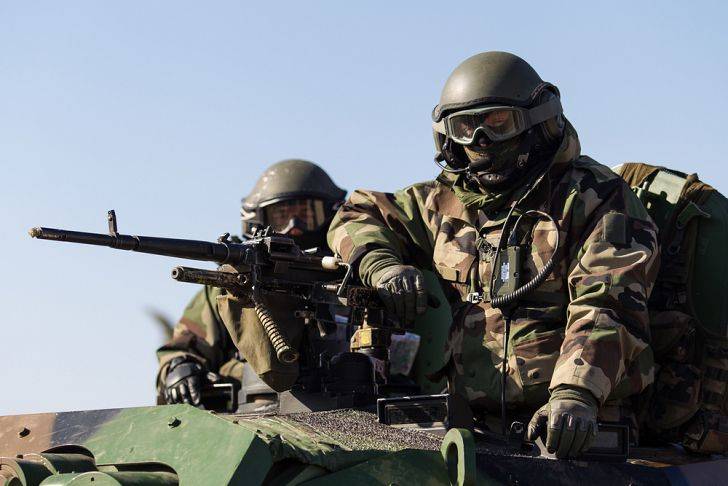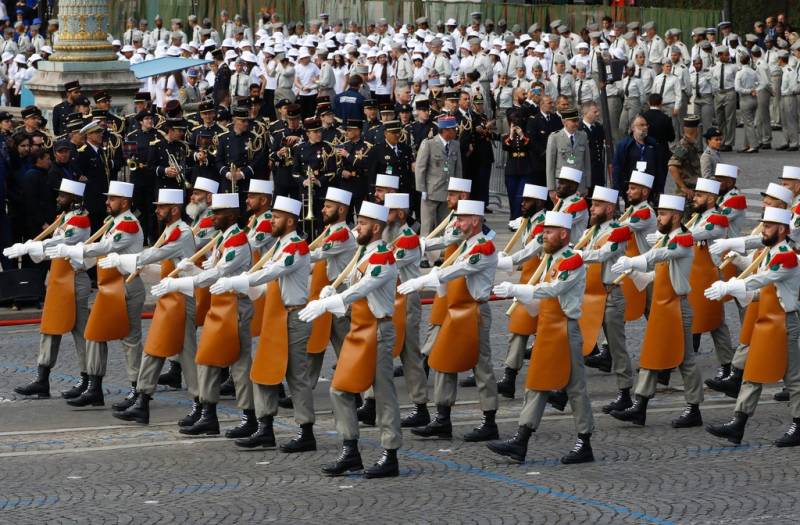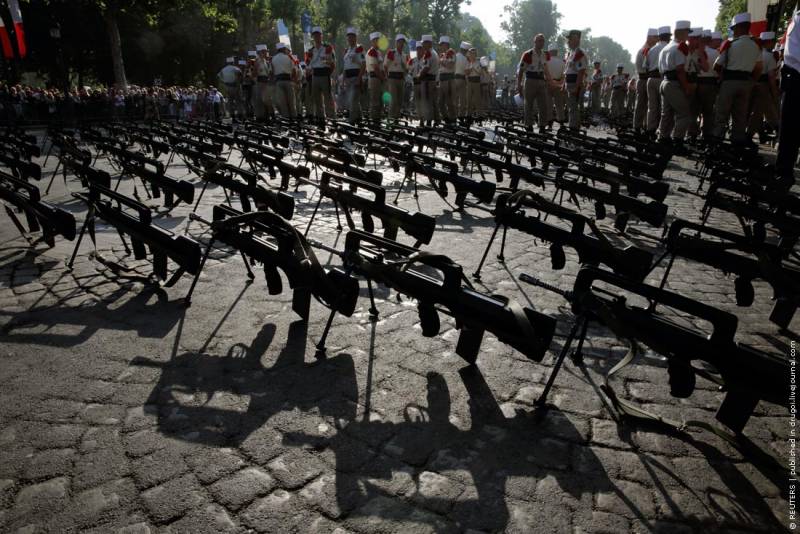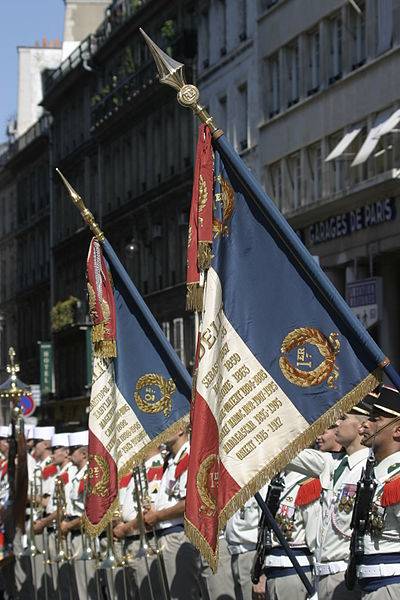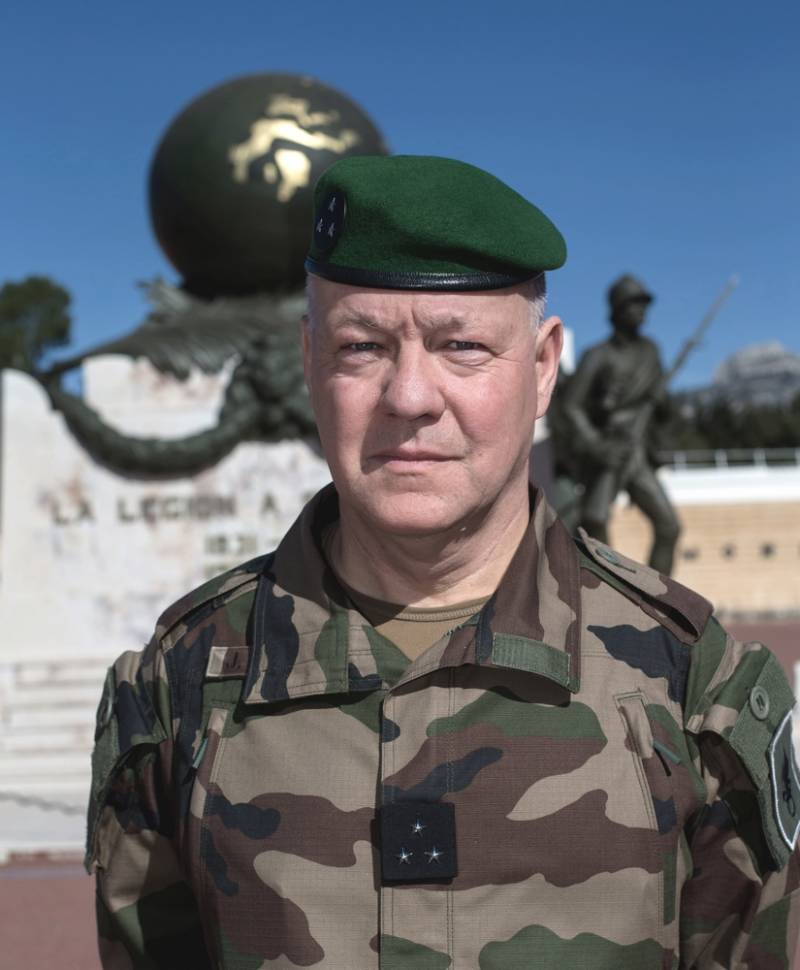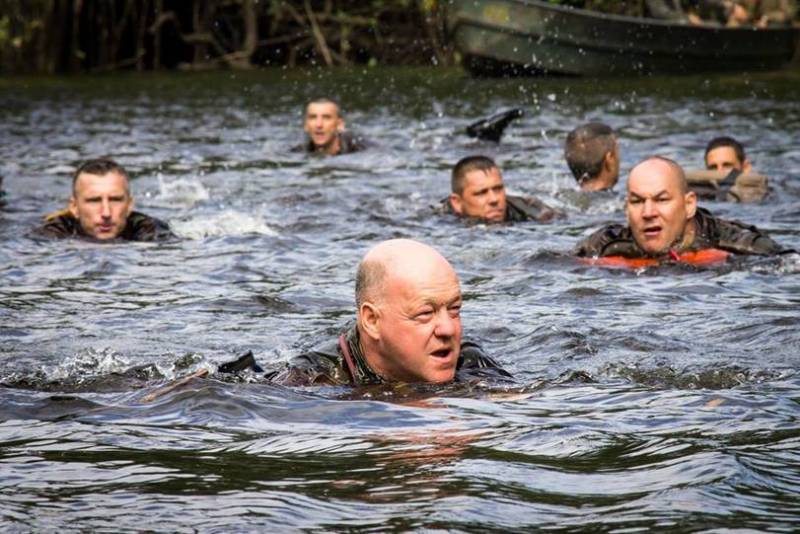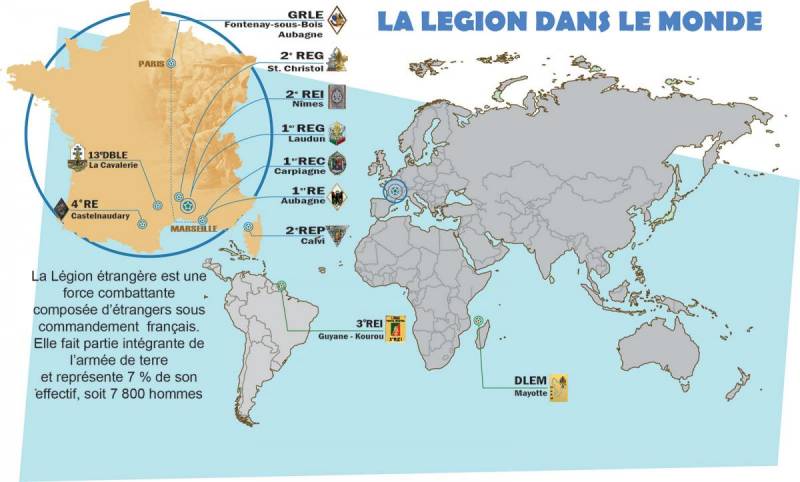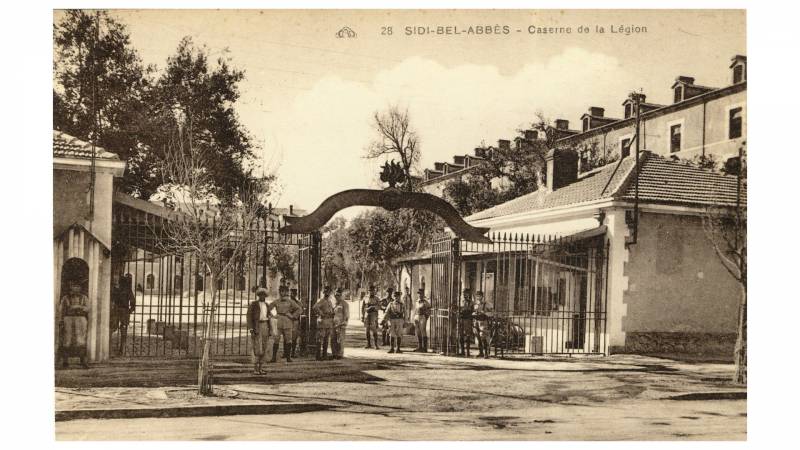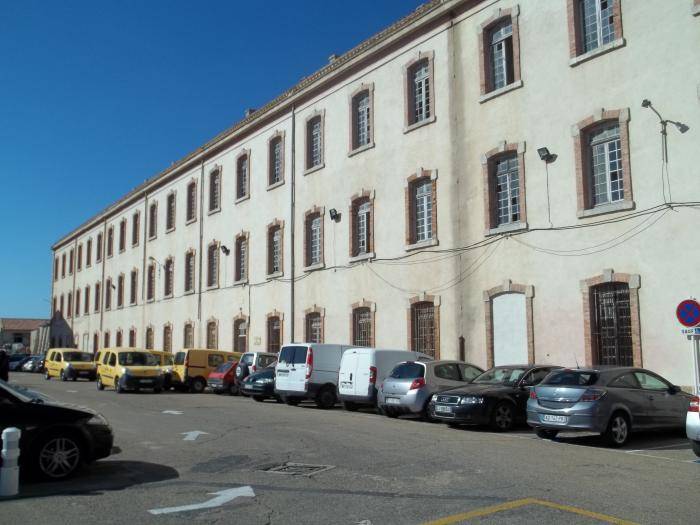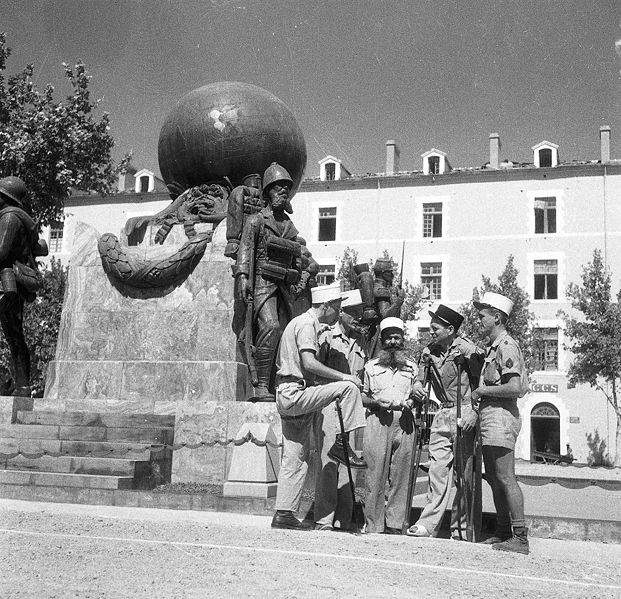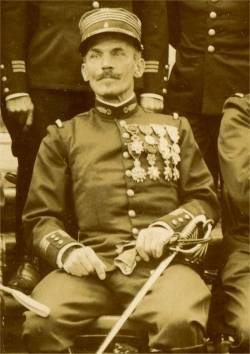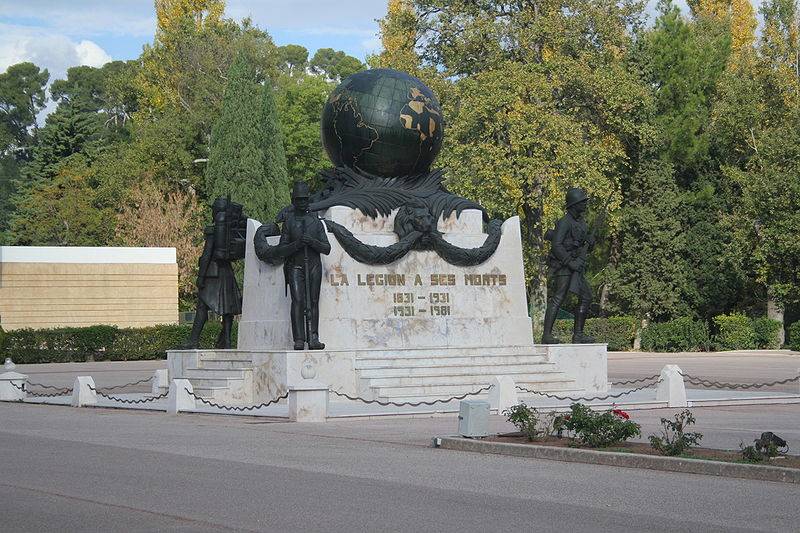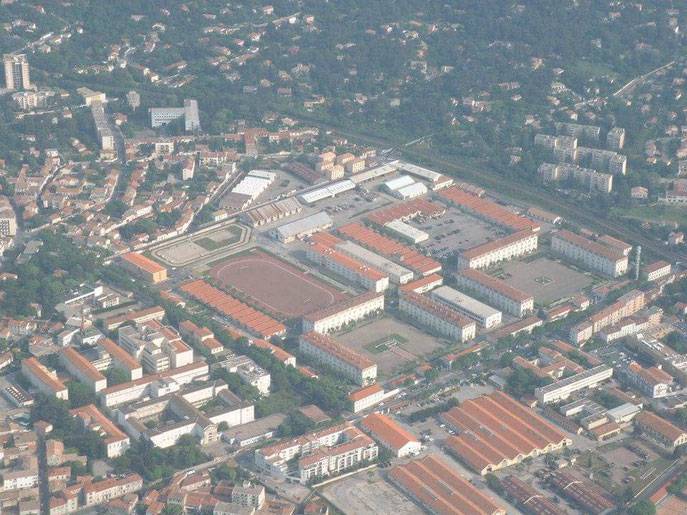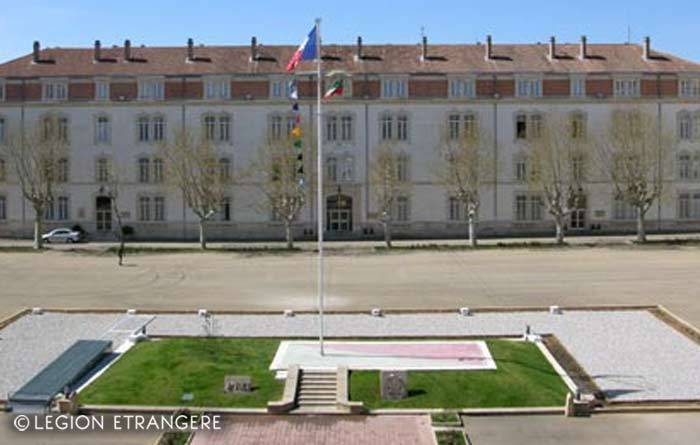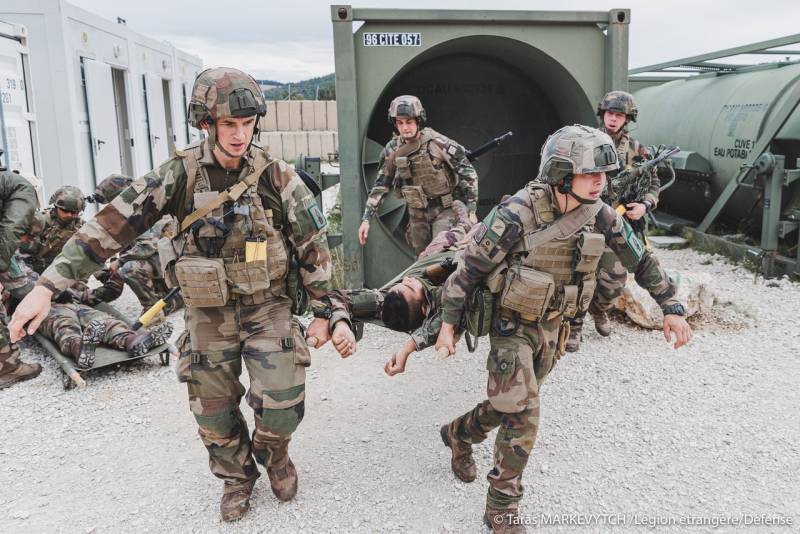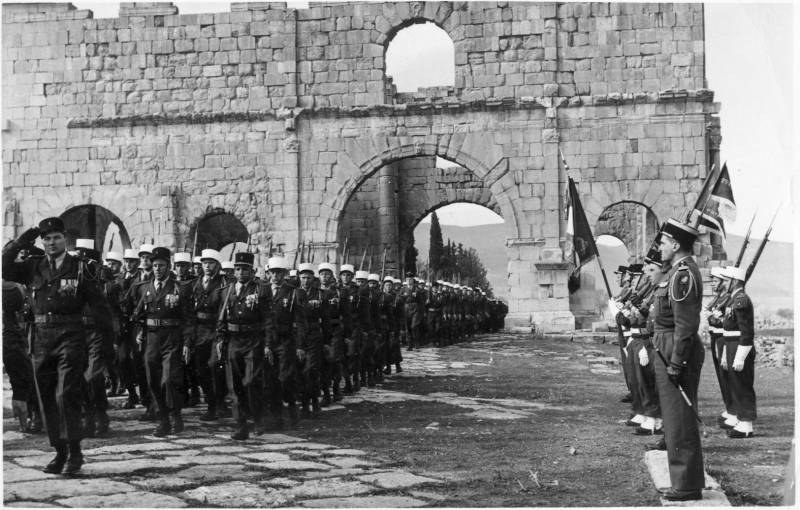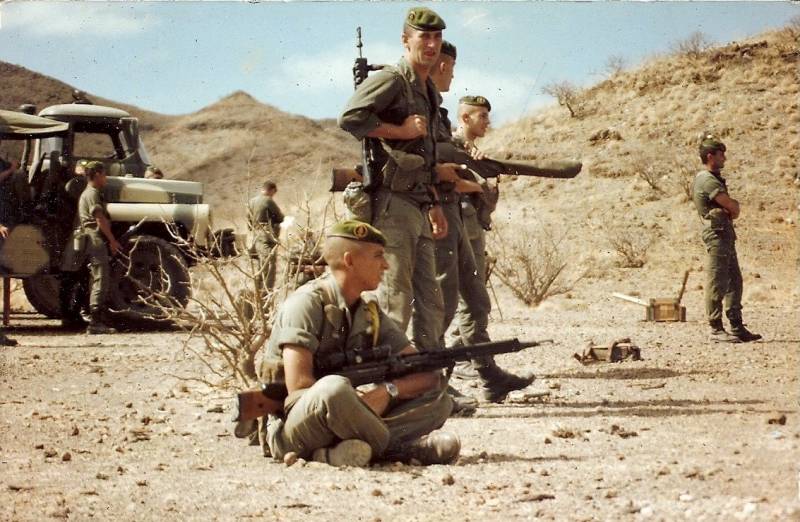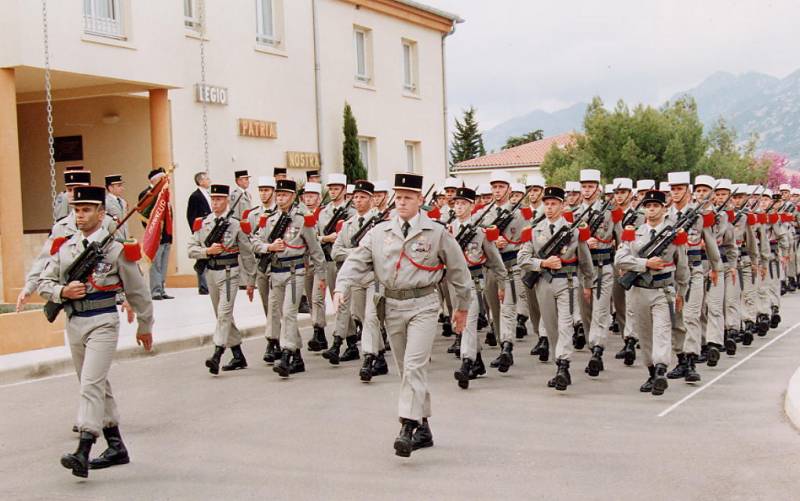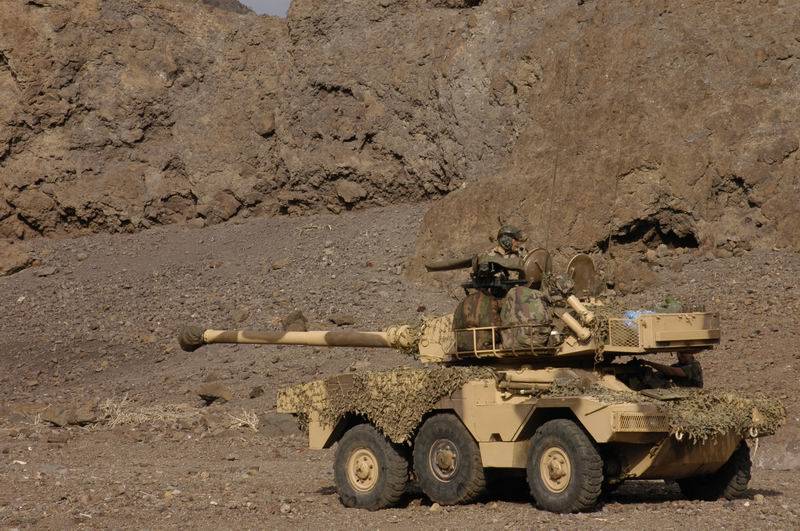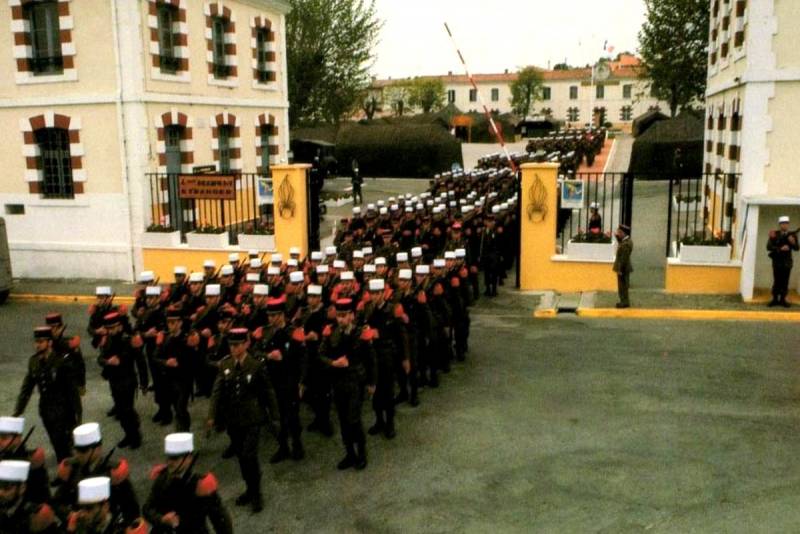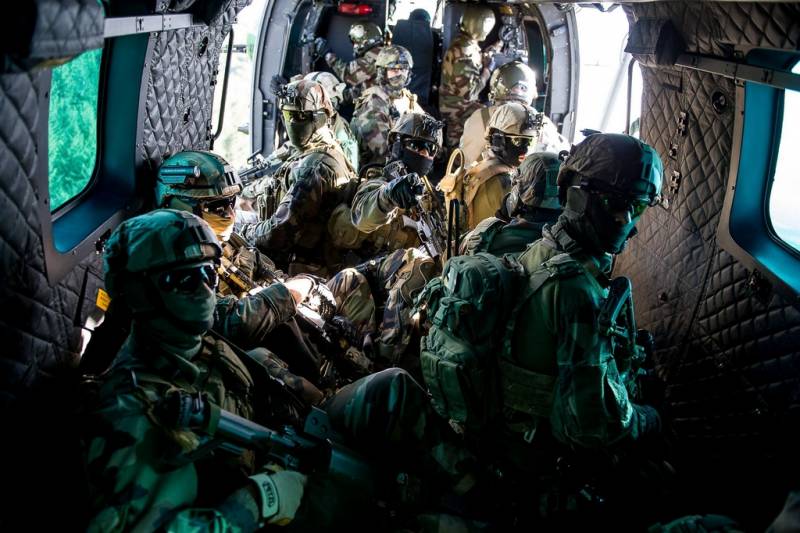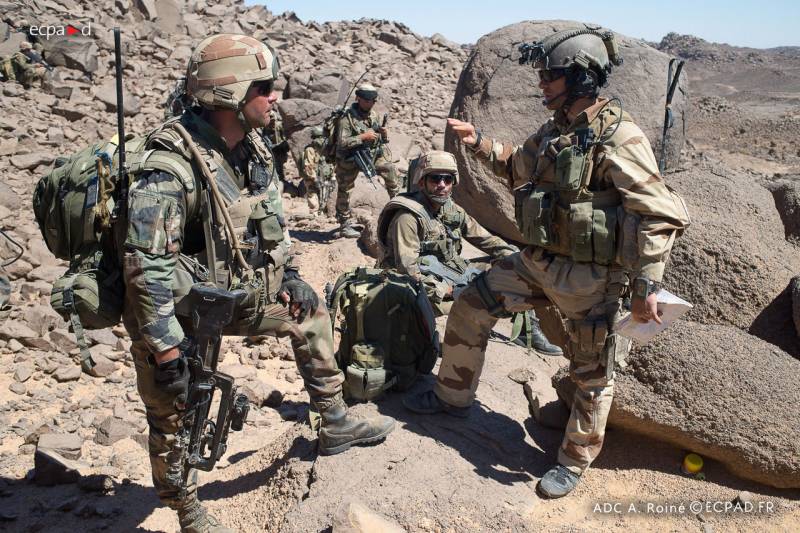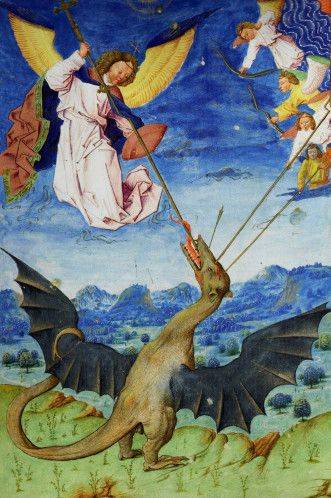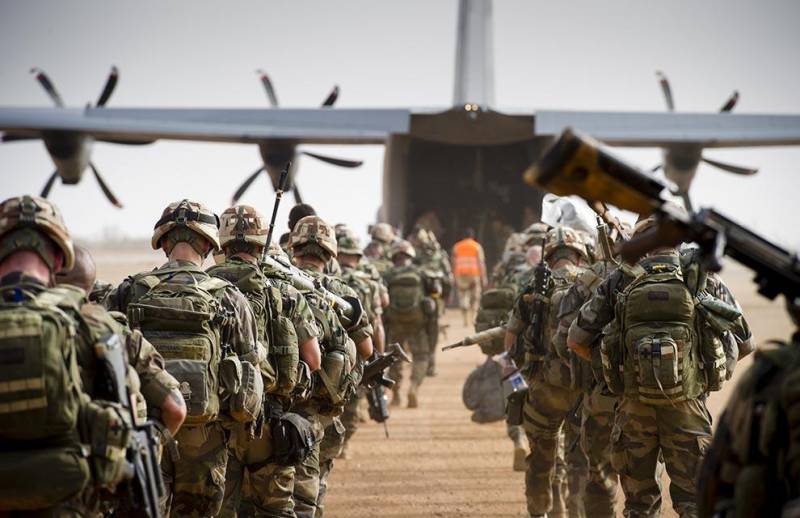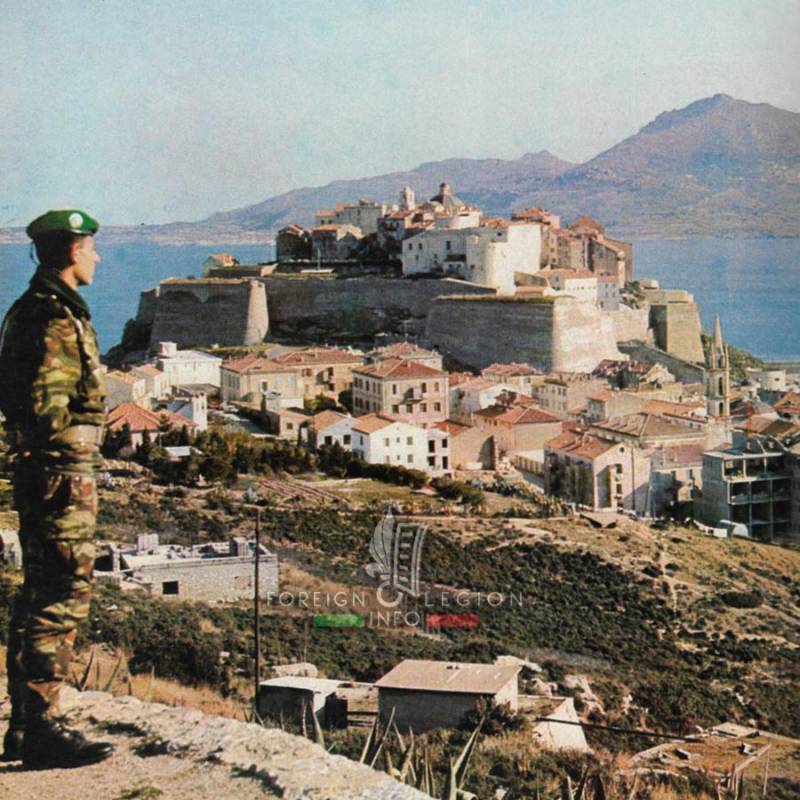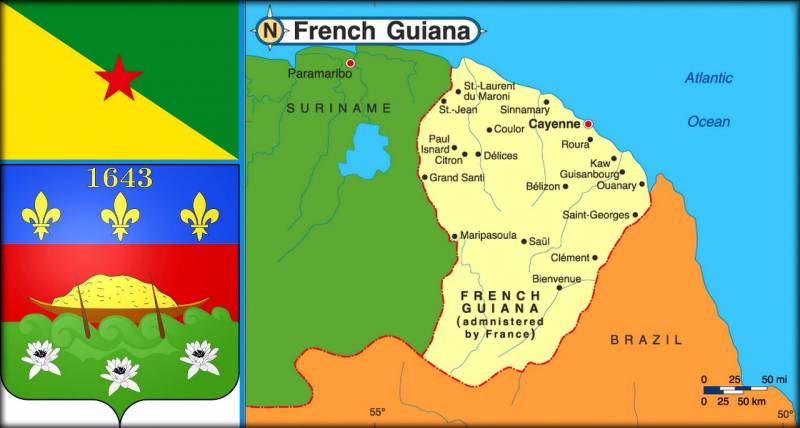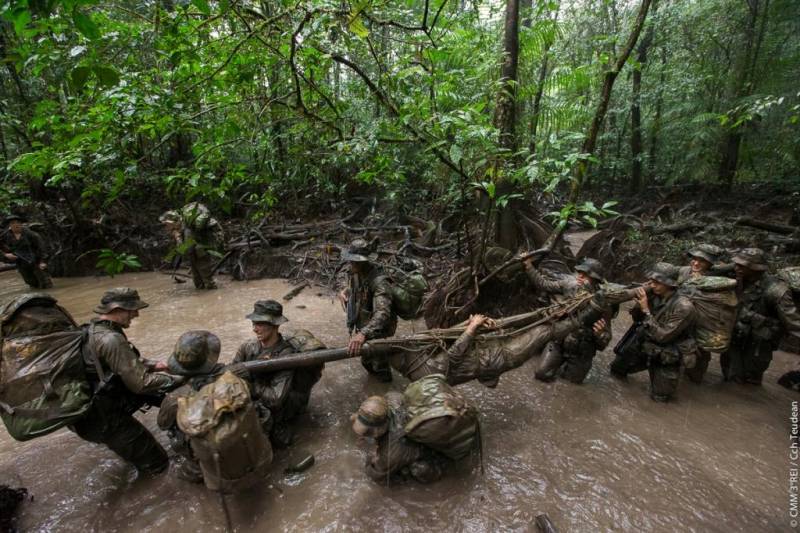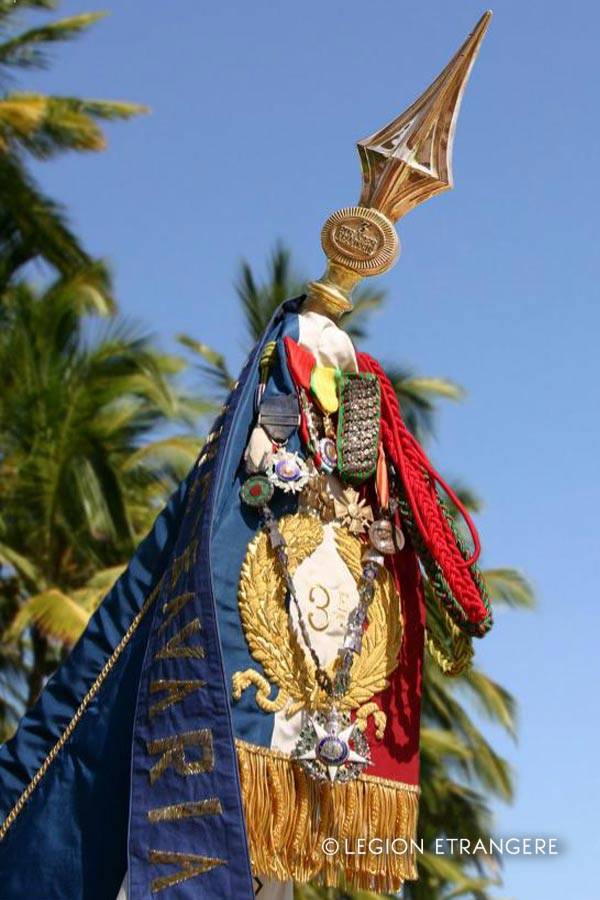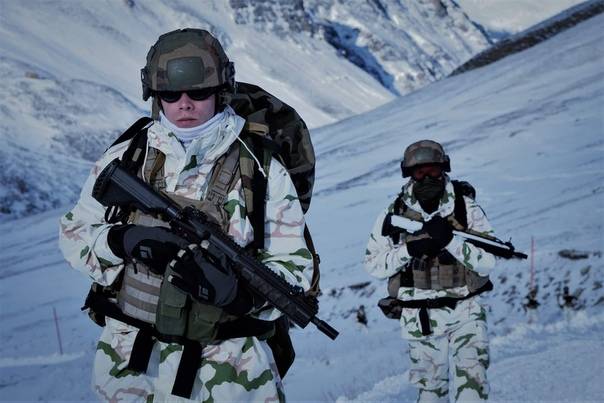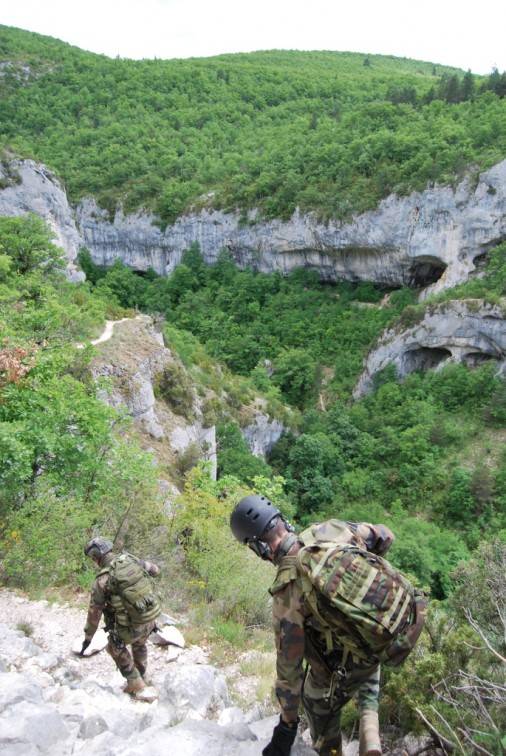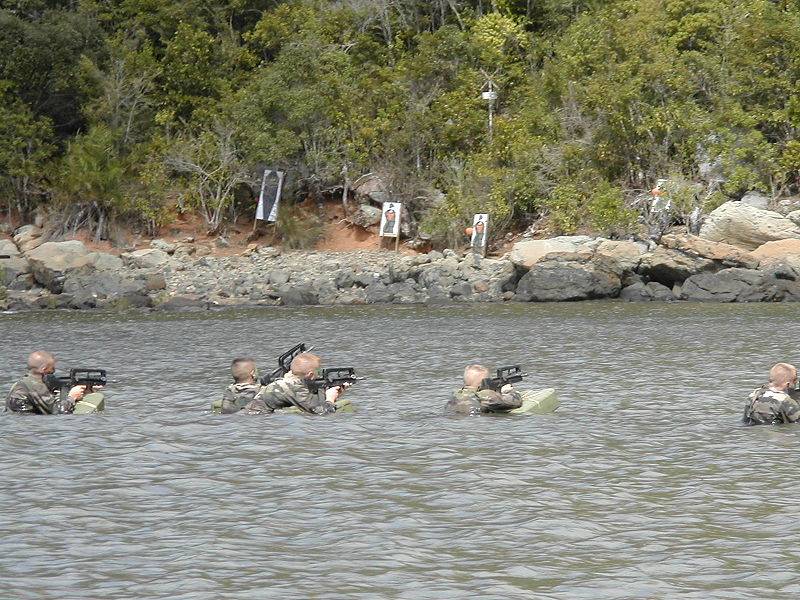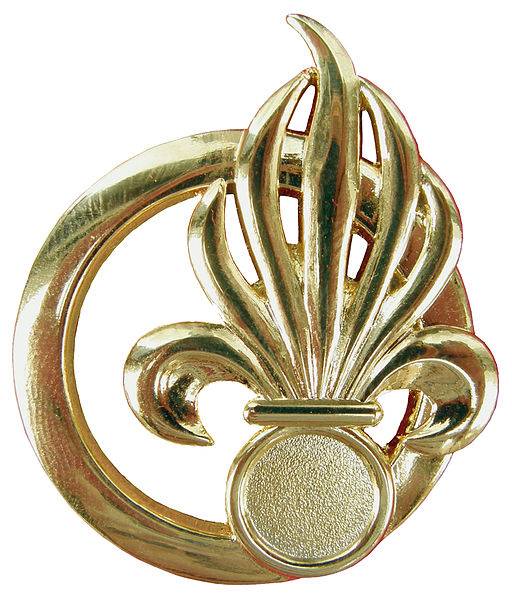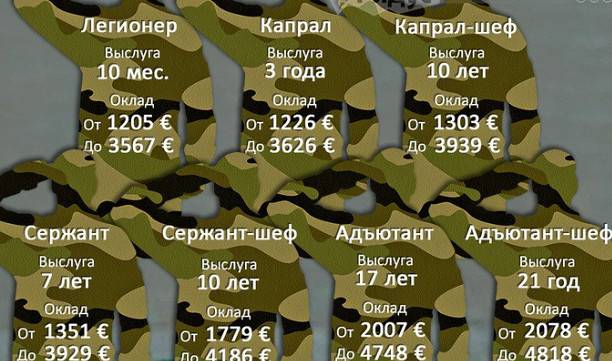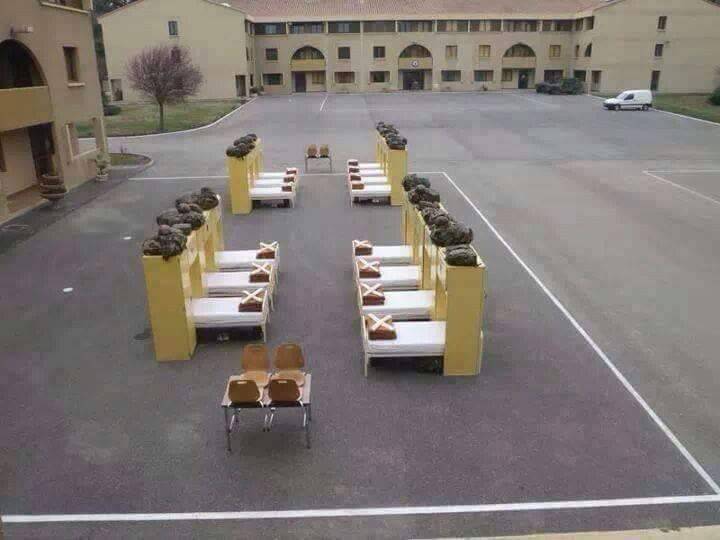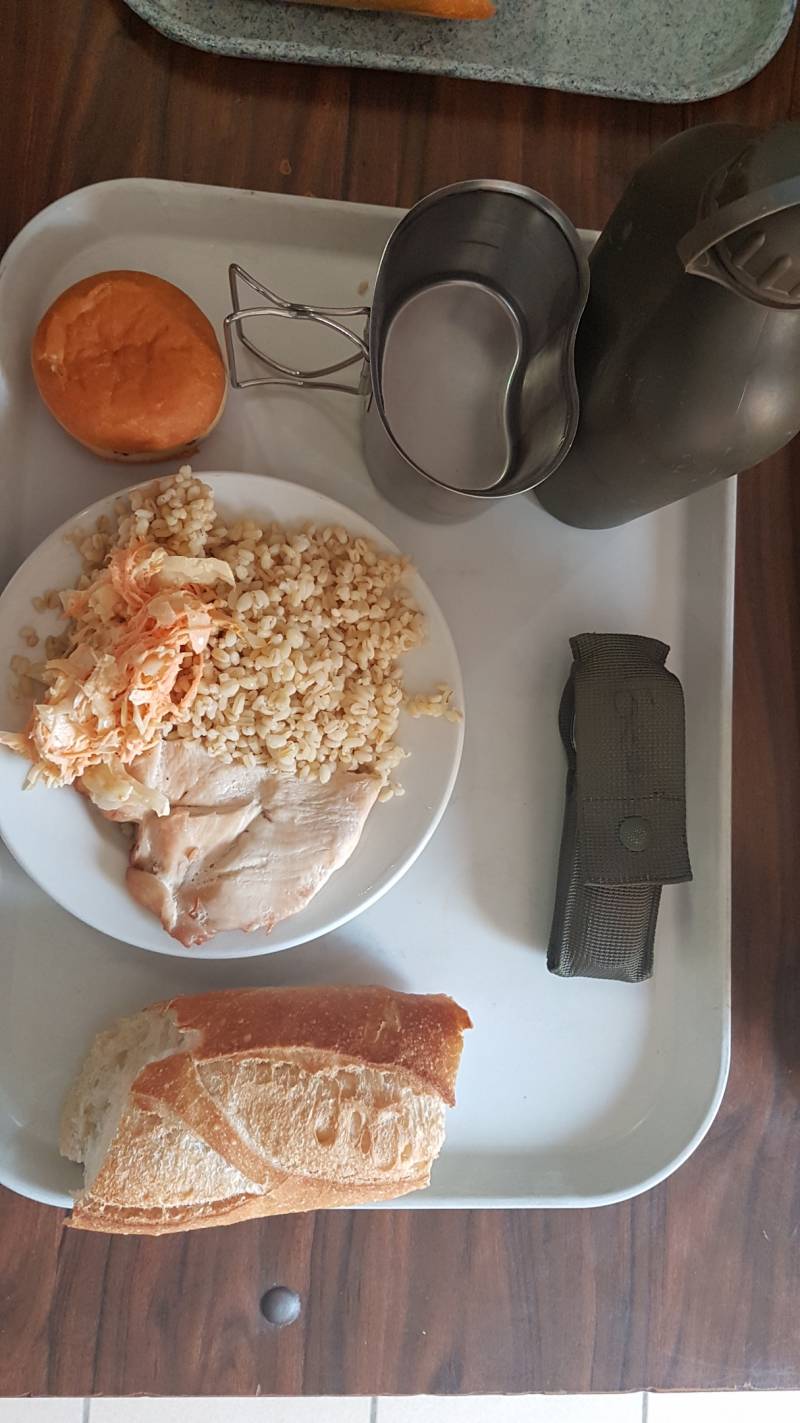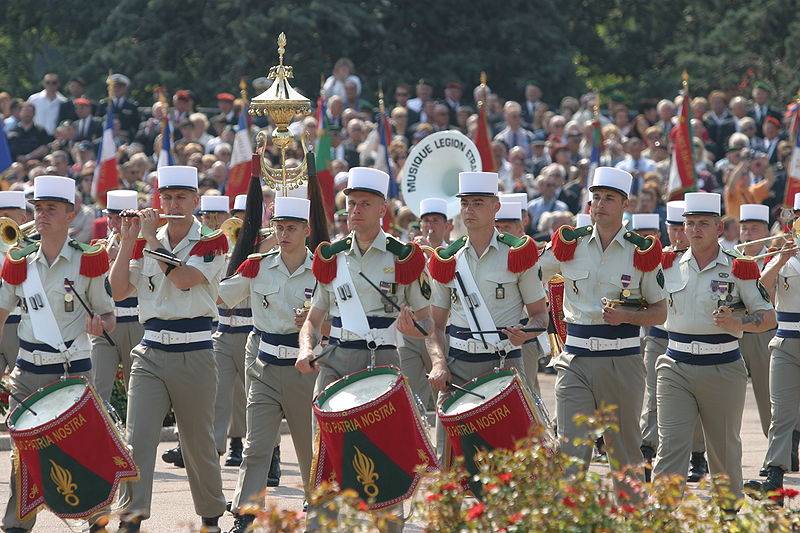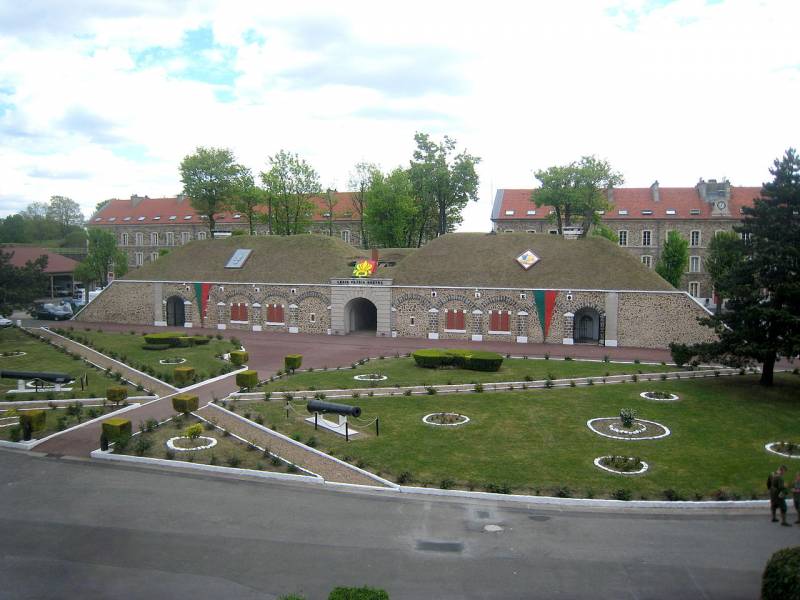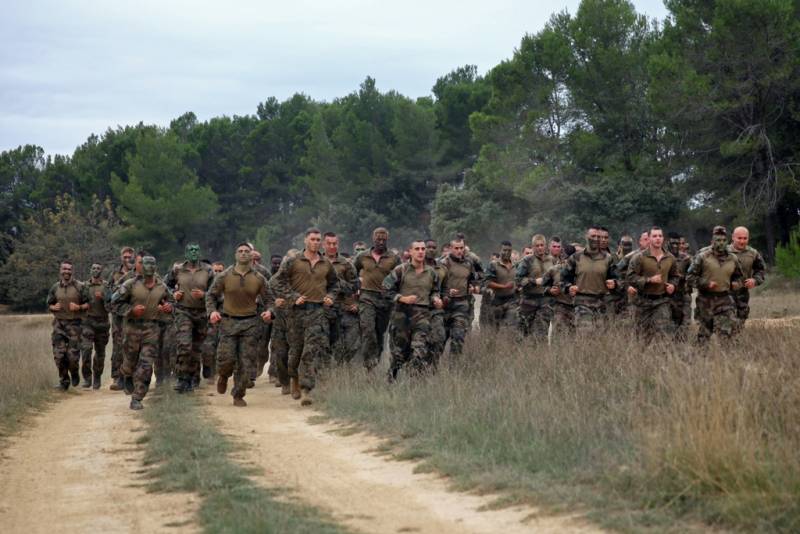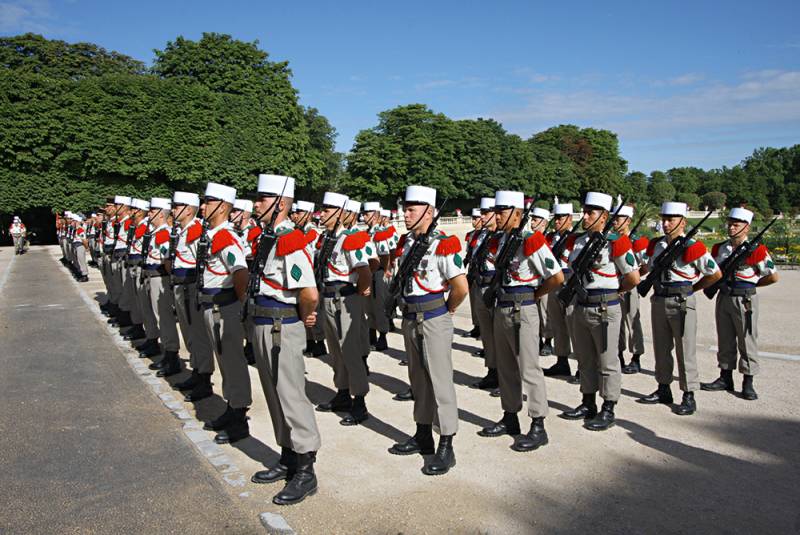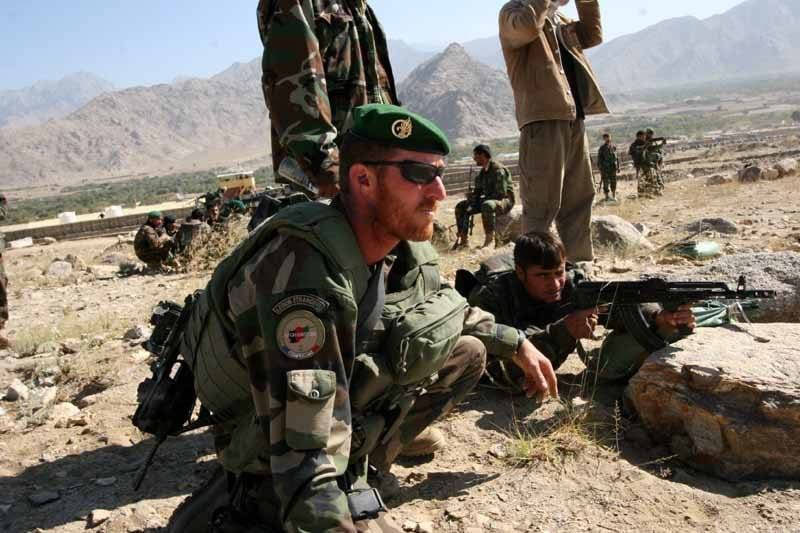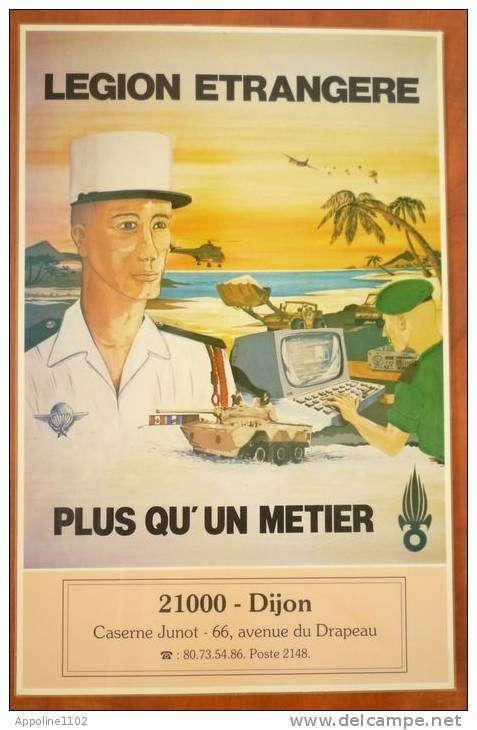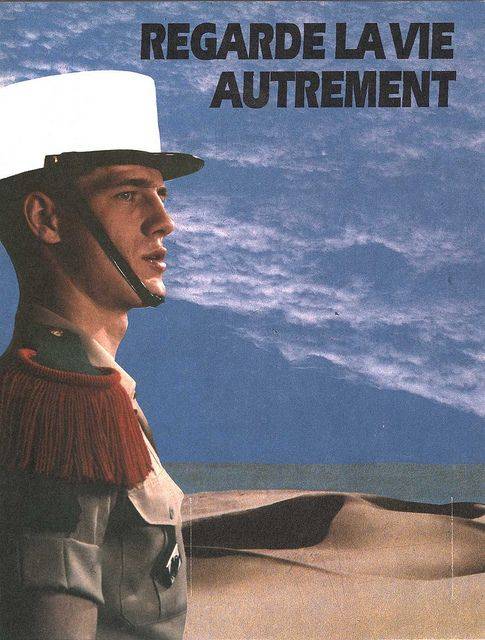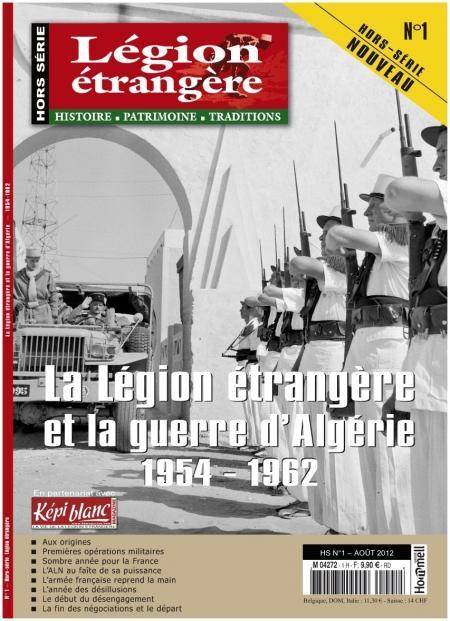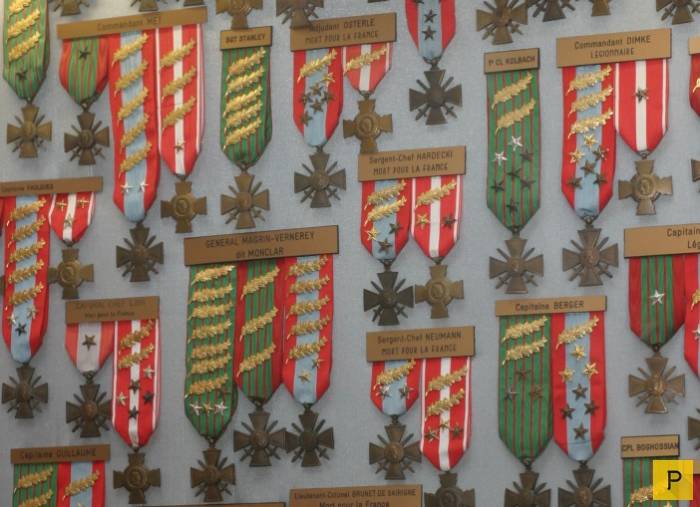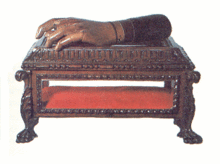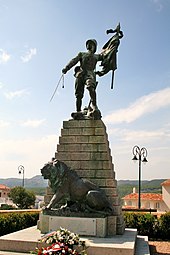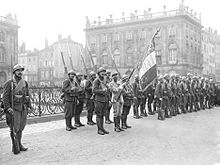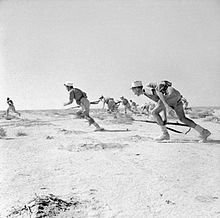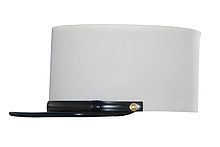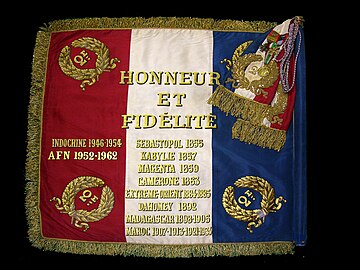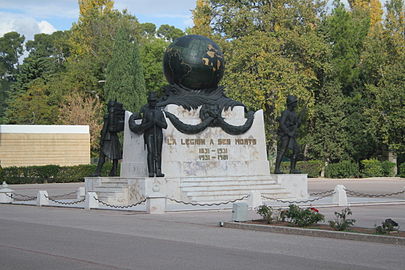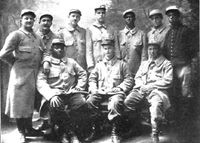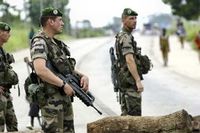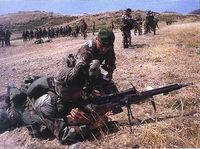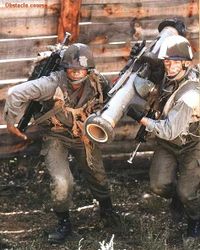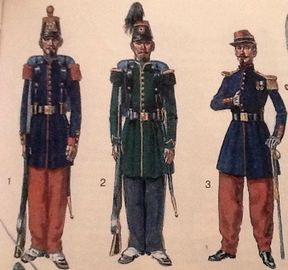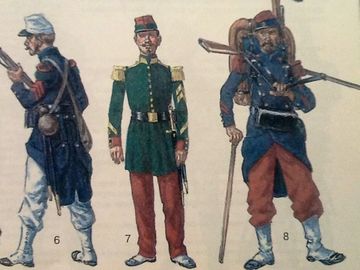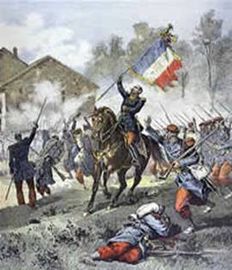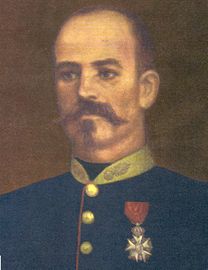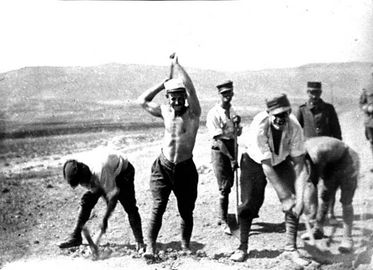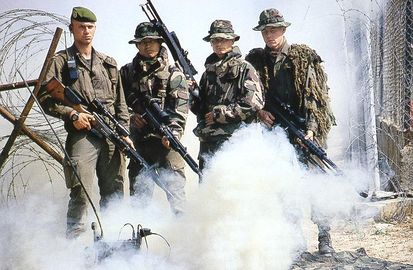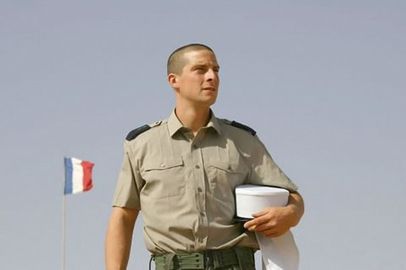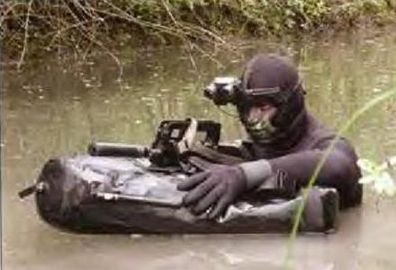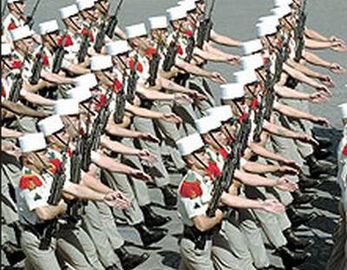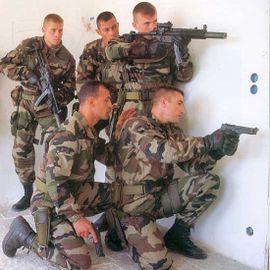Праздники легиона
Праздники легиона
Конечно, главный праздник для легионера — это выигранный бой, без потерь.
И все же во Французском Иностранном легионе два самых главных праздника: 30 апреля и 24 декабря. Один — это «Камерон», годовщина боя при Камероне в Мексике в XIX веке, а второй — Рождество.
«Камерон» — протез капитана Данжу
Основным официальным праздничным днем в Иностранном легионе считается 30 апреля — в этот день в 1863 году на асьенде Камерон в Мексике 63 легионера под командованием капитана Данжу, встав в круговую оборону, в течение десяти часов отражали бешеный натиск двух тысяч мексиканцев. Горстка иностранцев на жалованье против целой армии энтузиастов-патриотов! Патриоты предлагали им сдаться на почетных условиях. Контрактники отказались и предпочли смерть. Кто не погиб в бою, тот вскоре умер от ран.
На могилах легионеров рядом с местом боя вскоре был установлен скромный памятник. Уходя из Мексики, 27 февраля 1867 года легионеры прощались с павшими словами, произнесенными на их могиле генералом Жаннигро: «Мужественные наши братья по оружию, погибшие на поле чести… Ваш героический подвиг не будет забыт и останется в анналах военной истории и нашей экспедиции в Мексику!» Слова оказались пророческими — именно Камерон стал символом стойкости легиона, его преданности присяге Франции и примером, на котором воспитывают многие поколения легионеров. В 1892 году в Камероне установили новый памятник и начертали на нем на латыни: «Их было меньше шестидесяти против полчища. Их раздавила эта масса. Но жизнь покинула этих французских солдат скорее, чем их отвага. 30 апреля 1863 года».
Через пятьдесят шесть лет после этого торжественного события, в 1948 году полковник Пенетт, отставной офицер легиона, по собственной инициативе начал хлопотать о строительстве мавзолея павшим солдатам. Благодаря своей настойчивости и вере в успех задуманного предприятия через несколько лет он сумел убедить в своей правоте не только французское и мексиканское правительства, но и верховного комиссара ООН. Скульптор Владимир Каспе разработал проект мавзолея с простыми и четкими линиями. По замыслу автора он своими формами напоминает о простоте и ясности любой миссии, выполняемой легионом по всему миру. В апреле 1963 года прах погибших солдат (кости и черепа героев уместились в двух ящиках) был перенесен к месту последнего упокоения.
Легионеры произносят название асьенды и своего праздника по-своему: по привычке не читать по правилам французской фонетики «е» они «съедают» и всегда выходит «Камрон».
Человеку, не служившему в легионе, трудно понять смысл этого праздника: в каждой армии найдется немало примеров стойкости и самопожертвования, а в российской — особенно. И разница не только в оценке отдельной человеческой жизни и «приоритете гуманитарных ценностей», как говорили в забытую эпоху горбачевской «перестройки», а в характере самого народа. То, что для нас — норма, для француза — героизм. Отсюда опять разница: мы своих смельчаков из-за массовости их героизма быстро забываем, а французы своих немногих героев помнят. Но смысл один — «шестьдесят данжуйцев», как наши «двадцать восемь памфиловцев». Но в легионе погибших не оплакивают, а мстят за них. А отомстив, чтят их память.
Празднование «Камерона» проводят в каждом полку. В «Отчем доме», в Обане, на плацу, напротив Памятника павшим, перед глазами десяти тысяч приглашенных ветеранов, официальных лиц и просто «друзей легиона» и местных жителей, проходит парад. Он начинается с того, что деревянный протез левой руки капитана Жана Данжу, командовавшего боем в Камероне, самый достойный из офицеров-ветеранов обносит перед замершими в молчании шеренгами.
Данжу хоронили без протеза — он куда-то исчез. После боя его не нашли, да особенно никто и не старался. Зато спустя пару лет деревянная рука обнаружилась — ее случайно увидел и выкупил один из офицеров у пеона в соседней Камерону деревне — тот клялся, что нашел руку на развалинах асьенды… Крестьянин зачем-то сохранил эту совершенно никчемную в его хозяйстве вещь.
Свою руку капитан Данжу потерял вовсе не в жарком бою. В 1853 году во время мирной топографической съемки в горах Кабилии произошел досадный несчастный случай: он хотел подать знак и выстрелил холостым зарядом… Курок щелкнул по капсюлю, и казенную часть ружья разнесло в клочья, а с ней и руку. Первый раз протез геройски погибшего капитана был показан войскам в гарнизоне Сиди-Бель-Аббеса в 1936 году. Ее нес лейтенант по фамилии Даини. В 1937-м этой чести удостоился капитан Риккио — классический герой довоенного легиона, вобравший все лучшие черты офицера того времени. В 1938 году настала очередь полковника Тероба, по кличке «Тонтон Тероб». Едва зародившись, традиция прервалась до 1947 года. Единственный, кто удостоился этой чести три раза подряд с 1947 по 1949 год, был коммандан Мерле. Тогда и появилось правило: никто не имеет права проносить на параде руку более трех раз. С тех пор кто же будет нести протез капитана Данжу — вопрос долгих обсуждений и большая интрига, теперь такое случается только один раз в жизни.
Кому-то покажется странным, что главная реликвия Французского Иностранного легиона — протез. С точки зрения англичан, французы вообще «very peculiar people», то есть «весьма специфические люди»…
В каждом подразделении происходит общий сбор за красиво накрытыми столами — знаменитая легионерская попойка — «попот». Все это так, но если на праздник 30 апреля смотреть глазами легионера, то становится ясно, что именно этот день — средоточие всех традиций, легенд и верований Иностранного легиона. Это не просто военный церемониал, а торжественная месса верующих, которую служит тот, кто для них выше самого папы римского, — командующий легионом.
«Камерон» довольно «молодой» праздник, его отмечают с 1906 года. Именно тогда о героически погибших в Мексике легионерах вспомнил выпускник Сен-Сира, тогда еще только лейтенант с очень длинным именем Франсуа Мари Жюль Виктор Леон, однако в истории он остался просто Франсуа. Итак, юный Франсуа командовал небольшим отрядом легионеров Первого пехотного полка на всеми забытом блокпосте в Таланге на китайско-вьетнамской границе в провинции Тонкин («Тонкин» — искаженное французами название столицы средневекового Вьетнама г. Тханглаунг, современного Ханоя. — В. Ж). Его проинформировали из штаба о том, что 28 апреля в Сиди-Бель-Аббесе на знамя его полка будет прикреплен орден Почетного легиона, о чем нужно было сообщить личному составу. Лейтенант подошел к этому неформально: 30 апреля, ровно в девять, весь гарнизон был построен с оружием на маленьком плацу. Наказанные были прощены и тоже заняли свое место в строю. Лейтенант обошел строй, внимательно глядя каждому солдату в глаза — всем было уже ясно, что это не обычная утренняя поверка. А затем громко, четко, по-военному кратко доложил о награждении знамени полка орденом и связал это событие с битвой в Камероне, рассказав о подвиге легионеров под командованием капитана Данжу и младших лейтенантов Вилэ и Моде. А затем выхватил из ножен саблю и салютовал так, будто знамя было не на другом конце света — в Африке, а перед ним. Так было положено начало празднику легионеров.
Повод для «попота» получил продолжение: в 1912-м такой же праздник устроили себе во Втором пехотном в Марокко. Спустя десять лет, в конце апреля 1924 года, старший сержант Штерн бодро докладывает из гарнизона в Сефру в том же Марокко, что вторая конная рота всю ночь 30 апреля несла добровольно службу по случаю праздника в результате выдачи дополнительной «четвертинки» красного вина… Наконец вьетнамско-марокканская инициатива снизу была услышана, и перед «странной войной» — в 1936 и 1939 годах — в «Отчем доме» в Алжире так же отмечался этот праздник. Затем последовал долгий перерыв на мировую войну: с 1 января 1946 года, по приказу командующего полковника Готье, поминовение легионеров из Камерона стало отмечаться во всех полках. Так что этот праздник нельзя назвать придуманным или спущенным «сверху».
Но почему же именно «Камерон» стал главным праздником легиона? Это и не сражение и даже не победа в бою. Выражаясь языком реляций русской армии, просто «дело у деревни Камерон». Сколько их было? Таких «шестьдесят легионеров», «героев Шипки» и прочих «девятых рот» в истории войн? Но не все погибшие становятся символами, несмотря на отчаянные старания оплаченных разными правительствами делателей истории…
Иногда одно поражение стоит всех больших побед. «Победа… Поражения… Эти высокие слова лишены всякого смысла. Жизнь не парит в этих высотах, она уже рождает новые образы. Победа ослабляет народ; поражение пробуждает в нем новые силы», — писал летчик де Сент-Экзюпери.
Смысл символизма «Камерона» прост — когда кто-то нагло называет легионеров наемниками, то слышит в ответ: «Если бы легионеры были бы действительно наемниками, то тогда, при Камероне, они б сдались. Это — самое разумное и правильное решение в такой ситуации. Для наемника. Но они были легионерами и предпочли смерть — бесчестью…»
Рождество
Рождество или, как его называют во Франции, «ноэль» — для одинокого эмигранта самый грустный день в году. Вечером 24 декабря все французы собираются своей семьей дома встречать «первую звезду». Приглашать посторонних, даже друзей, не принято. У любого француза есть родители, любимые бабушки и дедушки, братья и сестры, тетушки и дядюшки: это же их страна. А родственники эмигрантов чаще всего находятся очень далеко. И в такой вечер чужого праздника их отсутствие ощущается особенно остро. В этот вечер одинокая девушка-иностранка с французским паспортом или холостой мужчина в лучшем случае могут пойти в ближайшую церковь к рождественской мессе, куда французы отправляются всей семьей, и немного «погреться» о чужое счастье.
В легионе в этот вечер не бывает одиноко и грустно. Рождество справляют по всей французской армии, но в Иностранном легионе — по-своему. Легионеры обязательно наряжают елку и оформляют рождественский вертеп — макет, изображающий сцену рождения Христа. В искусстве создания вертепов соревнуются все: однажды полковнику Ваяну, командовавшему «Отчим домом» в Сиди-Бель-Аббесе в 1961 году, пришлось ознакомиться с тридцатью тремя вертепами!
Для легиона Рождество тоже семейный праздник. Легион — не обычное воинское подразделение, а большая семья. И отношения между людьми здесь не в стиле «я — начальник, ты — дурак», а как в нормальной семье, где младшие уважают старших, а старшие любят и заботятся о младших. Недаром старшие офицеры называют младших и простых легионеров «nos garcons» — «наши мальчишки».
И все это — не пустые слова. Известно, что в сочельник вся Франция сидит дома и ест всей семьей «фуа гра» — гусиную печенку. В этот священный для семьи вечер даже самые искушенные «ходоки» проводят вечер с женой. Но только не офицеры Иностранного легиона: на Рождество они в казарме, со своими «мальчишками», а их мальчишки сидят с мамами без пап. Как мне объяснил комбат, парашютист майор Моррель: «Жена офицера-легионера знает, что у ее мужа есть вторая семья — легион. И не должна ревновать». У комбата в сочельник дома остается семь сыновей.
Но никому даже в голову не придет остаться со своей первой семьей (или второй — вот в чем вопрос для каждого легионера и его жены!) и не провести ночь в казармах, раздавая и получая рождественские подарки, распевая песни и попивая вино или пиво.
«По-своему» Рождество начали справлять в легионе с 1912 года. Например, во Втором пехотном полку, расквартированном в Фезе в Марокко, легионеры не стали сооружать вертеп, а изобразили живую сценку, используя свои форменные бурнусы и шешы, правда, в роли младенца Иисуса выступала большая кукла… Офицеры в тот вечер появились в комнате, где проходило ночное рождественское бдение, ровно в полночь с подарками в руках. Раздали подарки своим солдатам, а потом пили с ними и пели на русском, испанском, французском и немецком. «А вот молились в ту ночь все больше немцы, а французы — мало», — сообщает современник.
Никто уже не вспомнит, кто в легионе придумал сделать «ноэль» особым праздником, но легионеры разных национальностей и вероисповеданий ждут Рождество с тех пор с радостью. Во Франции Рождество справляют не так пышно и красиво, как в Германии, но присутствие в легионе большого количества немцев после Второй мировой войны добавило немало немецкого и австрийского «гемютлиха» в оформление праздника. Однако Рождество для легионеров не религиозный праздник, а семейный. А как же иначе, если в одном подразделении собрались и православные, и католики, и протестанты, и мусульмане, и буддисты, и иудеи? Но вертеп, елка и подарки обязательно присутствуют, а ночное бдение превращается в «попот». Разумеется, кто считает нужным, может отправиться на мессу к полковому «падре»… но к началу «попота» опаздывать не следует!
Конечно, в связи с тем, что легионеры служили и продолжают служить по всему свету, география вносит свои дополнения в этот праздник; никого не удивляет, если вместо елки — пальма, а вместо снега — вата из перевязочных пакетов. Даже во время боевых операций легионеры не изменяют своему обычаю справлять Рождество. Во время операции в Сомали командир отдает письменный приказ своим парашютистам: «Движение в направлении Байду. Остановка в 17.30, 30 км на юго-восток от города. Разбивка бивуака. 20.30 — рождественская месса, раздача подарков, скетчи и шаржи, ужин. Команда собирается вокруг елки. Поздний отход ко сну».
Разумеется, по периметру выставлены караулы с приборами ночного видения.
Бывали и забавные случаи во время встречи Рождества: хорошо подвыпившая компания легионеров демонстрирует полковнику свое творчество — вертеп и при этом бормочет: «Нужно простить Божью Матерь: она сегодня многовато выпила». А в другой раз старый служака «аджюдан», когда в комнату внесли вертеп с новорожденным Христом, скомандовал: «Смирн-аа! Равнение на Святое Семейство!»
Если 30 апреля стал днем отваги и самопожертвования, то 24 декабря для легионеров — вечер самых теплых человеческих чувств. И к нему относятся как к домашнему празднику: все делается от души, а не «по приказу». Легионеры даже сочиняют свои, легионерские, рождественские сказки. Например, о том, как беременная Мария и ее муж, Иосиф из Назарета, отправились в Вифлеем, чтобы принять участие в переписи населения. Они были бедны, а мест в дешевых гостиницах не было. Добрый человек посоветовал им поискать ночлег в пригородах города. Выйдя из города, они увидели на небе яркую звезду и пошли в ее направлении. Шли долго, и уже не было никакой надежды найти людей и ночлег. И вдруг увидели форт. Мария уже была еле живой от усталости, и ребенок должен был вот-вот родиться. Иосиф боялся постучать в ворота, но Мария заставила его. Раздался окрик: «Кто там?» Иосиф торопливо поведал их историю. В ответ прозвучало: «Стоять! Не двигаться!» Молодая пара перепугалась не на шутку. Вдруг ворота распахнулись, и они увидели двадцать солдат в белых кепи. Один из них был в черном кепи.
Он и сказал: «Входите скорее! Мы подготовим удобное место для вашей жены!» А дальше все как в настоящей сказке. Иосиф не понимал их языка. Видел только, что тот, в черном кепи, отдает приказы, а солдаты их охотно исполняют. У каждого была своя задача: один быстро постелил постель для Марии, другой ловко накрыл на стол для них двоих, третий резво развел огонь, четвертый со знанием дела резал овощи… Разумеется, спустя некоторое время раздался детский крик. Иосиф распахнул дверь из комнаты роженицы и прокричал: «Это мальчик. Имя ему — Иисус!» В ответ легионеры дружно грохнули: «Ура! Да здравствует Иисус!» А позже, когда все собрались за одним столом и Иосиф стал благодарить своих спасителей, капитан в черном кепи сказал ему: «Это мы должны благодарить вас. В этот вечер мы чувствовали себя одиноко, и каждый сидел в своем углу. Все мы так далеко от наших семей и наших близких. А благодаря вашему появлению мы все собрались вокруг семьи». А в это время старый ветеран-легионер, попыхивая трубкой, строгал из деревяшки детскую игрушку и бормотал себе под нос: «Сегодня день необычный… и ребенок тоже необычный. Не как все. Он точно оставит след в жизни человечества, как оставил сегодня в нашей. Готов поспорить на все свое убогое жалованье солдата».
А потом на мотив этой сказки один русский легионер-художник нарисовал трогательную картинку: Мария с маленьким Иисусом, завернутым в тряпицу, стоит в окружении улыбающихся легионеров в бурнусах — тех самых, что носили во время службы в Сахаре в пятидесятые годы прошлого века.
«Святая Варвара»
День святой Варвары — третий официальный праздник Иностранного легиона.
В России день великомученицы Варвары — 17 декабря (по новому стилю). Он совпадает с праздником Ракетных войск стратегического назначения, поэтому с 1998 года ракетчики считают ее своей святой покровительницей. Во Франции этот день приходится на 4 декабря (так же было и в России по старому стилю).
Почему же именно святая Варвара? Только ли потому, что считается избавительницей от внезапной смерти, без причастия и покаяния, что воспринимается верующими как наказание? Несомненно, жизнь легионера полна опасностей, а, как известно, «сапер в жизни ошибается только раз». Все это так, но французские католики верят в то, что святая Варвара оберегает от удара молнии, ведь после казни великомученицы ее истязателей собственного отца Диоскура и правителя города Мартиана поразил удар молнии. Она же покровительствует тем, кто имеет дело с огнем и взрывчатыми веществами: минерам, артиллеристам, саперам и пожарным. Но мало кто из саперов-легионеров знает, что мощи их святой покровительницы покоятся в Киеве: православное предание рассказывает, что в XII веке византийская царевна Варвара Комнина — дочь императора Алексея перед отъездом в Киевскую Русь к жениху умолила отца отдать ей мощи святой Варвары. Муж царевны — великий князь Святополк Изяславович положил мощи в каменную церковь, выстроенную годом ранее, а затем основал старейший в Киеве мужской монастырь — Михайловский Златоверхий. После его разрушения в 1930 году мощи перенесли во Владимирский собор в Киеве, где они находятся и поныне.
Саперы-легионеры день великомученицы Варвары называют «мирным Камероном», потому что там, где заканчивается работа пехотинцев, начинается работа саперов — восстановление всего того, что было разрушено в бою. В этот день в саперных полках проходит парад и устраивается «попот», на котором командир полка разрезает огромный торт не ножом, а саперным топором с длинной ручкой.
Данный текст является ознакомительным фрагментом.
Читайте также
Праздники
Праздники
Переход церковных ритуалов в традиции общекультурные особенно заметен во время религиозных праздников. Отмечаются они в точные даты (которые, впрочем, могут слегка смещаться) и по установленным правилам. Однако редко когда заканчиваются в церкви.Самый любимый
Праздники
Праздники
Праздники носили религиозный характер. Для майя религия была человеком, а человек – религией; многое, если не все из того, что они делали, имело магическую или религиозную цель.Месяц Поп, который выпал бы в нашем календаре на июль, был у майя Новым годом. Это было
Глава 18 Праздники
Глава 18
Праздники
Кельтский год поначалу не был упорядочен по солнцестояниям и равноденствиям, а неким образом был связан с сельскохозяйственными сезонами или временами года. Позже год состоял из лунных циклов, и есть некоторые свидетельства в пользу стремления кельтов
VII. Формирование легиона
VII. Формирование легиона
Римляне побеждали все нации своей дисциплиной; они постоянно совершенствовали свои знания о войне и легко отказывались от старых обычаев, если находили им лучшую замену. В этом отношении они отличались от галлов, которых били в течение нескольких
Праздники и рабочие дни
Праздники и рабочие дни
Главные праздники
В Британии всего 8 федеральных праздников: Новый год 1 января, перед Пасхой, дата которой меняется из года в год и зависит, как и у нас, от лунного календаря, Good Friday (Страстная пятница), понедельник после Пасхи, Bank Holiday (Банковский
Главные праздники
Главные праздники
В Британии всего 8 федеральных праздников: Новый год 1 января, перед Пасхой, дата которой меняется из года в год и зависит, как и у нас, от лунного календаря, Good Friday (Страстная пятница), понедельник после Пасхи, Bank Holiday (Банковский выходной). Традиция выделять
5.3 Праздники
5.3 Праздники
Суббота и воскресенье переживаются в деревне как кульминация недели. В те или иные дни можно особенно почувствовать соответствующее время года или годичный круговорот в целом. Таких моментов много. Вот важнейшие из них:Новогодний вечер (встреча жителей
3 Календарные праздники
3 Календарные праздники
Был стар Иосиф, очень стар,
Когда Марию взял
И в Галилее пред людьми
Женой своей назвал.
Вот в сад, где ягоды не счесть,
Пришли они вдвоем,
И вишня алая, как кровь,
Свисала там кругом.
По саду доброму они
В тиши вдвоем бредут.
А вишня сладкая
Весенние праздники
Весенние праздники
Отзвучали веселый смех, чмоканье и залихватские напевы. Февральская стужа сковала сердца, померкли улыбки, и тоскливо стало на душе. Наступало самое печальное время года — Великий пост. Он начинался за сорок дней до Пасхи, в Пепельную среду. В
Летние праздники
Летние праздники
Ночью 23 июня, накануне Дня Иоанна Крестителя, нечисть кутила так буйно, как не веселилась с самого Хэллоуина. На юге Стаффордшира верили, что в эту ночь ведьмы всего мира устраивают совещания, на которых решают судьбы смертных.То было время для гаданий и
Василий Журавлёв Повседневная жизнь Французского Иностранного легиона: «Ко мне, Легион!»
Василий Журавлёв
Повседневная жизнь Французского Иностранного легиона: «Ко мне, Легион!»
Благодарю за помощь в написании этой книги: профессора исторического факультета МГУ Николая Борисова, командира танкового эскадрона Фредерика Дагийона, командира батальона
Музыка легиона
Музыка легиона
Музыка и песни в легионе давно уже стали традицией. Для военного человека музыка порой важнее, чем для штатского. Для легионера — особенно. Это признание его заслуг и того, что он не зря рисковал своей жизнью. Музыка и песни легионеров — воспоминания о
Униформа легиона
Униформа легиона
Станция парижского метро «Бастилия» — самая светлая. И не потому, что мозаики на стенах напоминают о светлом дне в истории Франции, когда парижская голытьба снесла тюрьму «спецназначения» и страна пошла «другим путем», но не захлебнулась в собственной
В данной статье мы завершим рассказ о Французском Иностранном легионе. В настоящее время к солдатам его полков во Франции относятся гораздо лучше, чем пятьдесят лет назад. По крайней мере, военнослужащие легиона не считаются сейчас поголовно уголовниками и социально опасными психопатами. Впрочем, особых симпатий, особенно в левых и либеральных кругах, к ним тоже не наблюдается. Сами легионеры шутят, что французы любят их только один день в году – во время Парада в честь взятия Бастилии, когда их подразделения торжественным маршем проходят по Елисейским полям.
Саперы (пионеры) Иностранного легиона. Военный парад в честь годовщины взятия Бастилии, Париж, Елисейские поля. 2016 год
Оружие солдат Иностранного легиона, принимающих участие в параде в честь взятия Бастилии
Полковые флаги первого и второго полков Иностранного легиона, Париж, 2003 год
Были времена, когда численность Иностранного легиона достигала 42 000 человек (начало I мировой войны), сейчас в нём насчитывается, по разным данным, от семи с половиной до восьми тысяч солдат и офицеров. Жан Морен (однофамилец последнего командира 1e REP, преемника Жанпьера), атташе по вопросам обороны посольства Франции в РФ, в интервью радиостанции «Эхо Москвы», которое он дал 24 апреля 2010 года, назвал число 7600 человек. Вероятно, его данным следует доверять, поскольку с 1 августа 2014 года именно он является командующим частями Французского Иностранного легиона.
Генерал-лейтенант Жан Морен, выпускник Академии Генерального штаба Вооружённых Сил Российской Федерации, бывший военный атташе в России, командующий Иностранным легионом
Командир Иностранного легиона Жан Морен и солдаты Третьего полка. Французская Гвиана
Из 11 полков легиона 7 сейчас базируются во Франции: в Обани, Кастельнодари, Кальви (остров Корсика), Оранже, Авиньоне, Ниме и Сант-Кристолье, 4 – за её пределами: в Джибути, Французской Полинезии, острове Майотт (архипелаг Коморских островов) и Французской Гвиане.
Места дислокации полков Французского Иностранного легиона
Штаб-квартирой всего легиона сейчас является Обань (город примерно в 15 км от Марселя): в казармах Вьено здесь размещается Первый полк (1 RE), сюда после эвакуации из алжирского города Сидди-бель Аббес, который легионеры ласково называли Прекрасная Аббес (в нём, кстати, располагались также спаги) были переведены главный штаб Иностранного легиона и его командование.
Казармы в Сидди-бель Аббес в XIX веке
Малопримечательное здание Главного штаба Иностранного легиона в городе Обань
Этот памятник погибшим воинам Иностранного легиона был установлен в Сидди-бель Аббес в 1932 году:
Мы видим земной шар, лежащий на охапке пальмовых ветвей, который охраняют четыре фигуры, символизирующие легионеров Алжира, Мексики, колониальных кампаний и Первой мировой войны. Инициатором создания и установки этого монумента стал «отец легиона» – полковник Поль-Фредерик Ролле (о нём было рассказано в статье «Псы войны» Французского Иностранного легиона»). По его просьбе легионеру колониальных кампаний было придано сходство с майором Брюндсо.
Майор Брюндсо
Покидая в 1962 году Алжир, легионеры привезли его в Обань:
Первый полк сейчас является учебным, главной функцией его военнослужащих является первичная подготовка новобранцев.
Второй пехотный полк, который был сформирован ещё в 1841 году на базе 4-го и 5-го батальонов Первого полка, размещается в казармах Валлонг (город Ним). Любопытно, что полковая песня второго полка – немецкая «Anna Maria».
Казармы Валлонг, Ним
Caserne 2e REI, Nimes
Совместные учения второго пехотного полка и аервого инженерно-саперного полка Иностранного легиона. От 2e REI – 5-ая рота, от 1er REG – инженерный взвод и медицинская команда
Знаменитая 13-ая полубригада на самом деле сейчас является полком, однако в память о былых заслугах сохранила своё название.
13-я полубригада Иностранного легиона проходит через римские руины. Lambaesis, Алжир, 1958 год
До 2011 года она размещалась в Джибути. На этих фотографиях мы видим солдат 13-й полубригады:
Солдаты 13-й полубригады, Джибути
Легионеры в Джибути
А здесь французская боевая разведывательная машина ERC 90 Sagaie 13-й полубригады в окрестностях Джибути, фотография 2005 года:
French ERC 90 Sagaie
Потом 13-я полубригада была переведена в Абу-Даби (ОАЭ), а сейчас вернулась во Францию.
На этой фотографии четвертый полк Иностранного легиона покидает казармы Данжу, город Кастельнодари, Франция (1980 год):
В расположении этого полка находятся офицерская школа и школа для сержантского состава.
Многие новобранцы, попавшие на обучение в школу Кастельнодари, вспоминают время, проведённое там, как кошмарный сон: работать приходилось буквально на износ.
Помимо пехотных, в Иностранном легионе имеются парашютно-десантный, танковый (бронекавалерийский), инженерно-сапёрные полки (кстати, в настоящее время лишь сапёрам разрешается отпускать бороду).
Десантники второго парашютного полка Иностранного легиона
В состав парашютно-десантного полка легиона (2e REP, размещается в казармах Раффали, город Кальви, Корсика) входят подразделения спецназа, которые комплектуются из добровольцев в чине не ниже сержанта, – CRAP (Commandos de Recherche et d’Action dans la Profondeur).
GCP (Parachute Commando) member from 2e REP (left) with a 17e RPG, March 8, 2013
Полковой праздник 2e REP отмечается 29 сентября, в день архангела Михаила, который считается покровителем парашютистов-десантников.
Все полки легиона входят в состав более крупных военных соединений французской армии. Например, второй парашютный полк является частью 11-й парашютной бригады, а первый бронекавалерийский входит в состав 6-й лёгкой бронетанковой дивизии.
Наиболее тяжёлой считается служба в третьем пехотном и втором парашютном полках. В парашютном полку трудно служить из-за постоянных высоких нагрузок и чрезвычайно жёсткого распорядка дня. Причем некоторые роты этого полка имеют свои уникальные учебные программы: 1-я рота специализируется на боях в черте города, 2-я рота – на войне в горах, 3-я занимается морскими операциями, 4-я рота осуществляет диверсионно-разведывательные действия.
Третья рота второго парашютного полка Иностранного легиона
2e REP legionnaire at Calvi, Corsica, 1965
Третий пехотный полк ранее был размещён на острове Мадагаскар, он второй в легионе по количеству наград, а его полковой праздник приходится на 14 сентября – это дата прорыва линии Гинденбурга в 1918 году. В настоящее время он располагается в Гвиане, месте, которое французы раньше называли «сухой гильотиной»: ещё в первой половине XIX века смертность в тюрьмах трёх близлежащих островов (архипелаг Иль-де-Салю) и трёх материковых достигала 97 %.
Французская Гвиана, карта
Самый известный каторжник Гвианы – бывший командующий Рейнской и Северной армиями генерал Пишегрю, которого Наполеон на острове Святой Елены назвал «способнейшим из генералов Республики». Он, кстати, стал одним из немногих, кому удалось из Гвианы бежать. Другой «знаменитостью» каторжной Гвианы стал анархист Клеман Дюваль, также бежавший с печально известного «острова Дьявола» – в 1901 году.
В настоящее время легионеры, отправляющиеся в «тропический рай» этого заморского департамента Франции, получают до 14 прививок от различных болезней.
В Гвиане располагается основной космодром Европейского космического агентства (Куру), охрана которого является одной из задач третьего полка легиона. А чтобы легионерам не было скучно, неподалёку построен Centre d’entrainement a la foret equatoriale – учебно-тренировочный центр по выживанию в джунглях. Обучающий курс состоит из модулей различной сложности, самый простой из которых учит просто не умереть в течение четырех дней (под наблюдением опытного инструктора). Второй уровень сложности – скрытное перемещение, организация засад, разведка и наблюдение. Третий – обучение командованию подразделением во время диверсионных либо противопартизанских операций. Четвёртый – автономный рейд с минимальным набором для выживания. Травмы во время таких занятий легионеры получают регулярно, часто опасные для жизни.
Легионеры в джунглях Гвианы
Знамя третьего полка Иностранного легиона
Самым «молодым» соединением Иностранного легиона является второй инженерно-сапёрный полк (2-e REG), созданный в 1999 году. Он специализируется на операциях в горной местности и входит в состав 27-й горной пехотной бригады (27e brigade d’infanterie de montagne). Располагается он в городе Сант-Кристоль.
Солдаты Второго инженерно-сапёрного полка:
2REG Foreign Legion
А здесь мы видим учения легионеров подразделения DLEM (de Légion étrangère de Mayotte), остров Майотта, 2007 год:
Это самое маленькое по численности соединение Иностранного легиона, его девизом является латинская фраза Pericula Ludus (что-то вроде «Удовольствие в опасности» или «Опасность – моя игра»).
Знак отличия подразделения DLEM, носится на берете
Те из вас, что прочитали статью «Боб Денар, Жан Шрамм, Роже Фольк и Майк Хоар: судьба кондотьеров», должны помнить, что именно легионеры подразделения DLEM в 1995 году арестовали на Коморских островах знаменитого короля наёмников – Боба Денара, пожелавшего устроить в этом государстве очередной государственный переворот.
Несмотря на то, что Иностранный легион в настоящее время является одним из самых боеспособных соединений французской армии (его часто называют «наконечником французского копья»), его рядовые военнослужащие получают обычное содержание (скромный базовый оклад от 1200 евро) и не имеют преимуществ в довольствии по сравнению с другими частями.
Базовые оклады военнослужащих Иностранного легиона
Во время боевых действий оклад военнослужащих значительно увеличивается (вторые числа в приведённой таблице). Дополнительно 600 евро получают парашютисты.
Уже упоминавшийся нами Жан Морен в своём интервью заявил, что в Иностранном легионе
«унтер-офицеры получают зарплату ниже средней во Франции, как квалифицированный рабочий в начале карьеры. Опытные унтер-офицеры получают зарплату как учителя в школе… Старшие офицеры получают зарплату, как старшие кадры предприятий. Это значит выше средней во Франции».
На зарплату влияет также количество детей в семье легионера.
После ранения или травмы, за время, проведённое в больнице, легионеры также получают надбавку к жалованью – 50 евро в день. Полагаются также страховые выплаты – до 240 тысяч евро. В случае гибели родственники, указанные самим легионером, могут претендовать на компенсацию в 600 тысяч евро.
Поскольку Иностранный легион является закрытой структурой, его офицеры не могут рассчитывать на самые высокие посты во французской армии. Вершиной их карьеры является звание бригадного генерала, которое обычно присваивается командующему частями Иностранного легиона, и полковника – командира одного из полков. Впрочем, на должности выше этих и в других военных соединениях Франции пробиваются лишь единицы.
В легионе практикуются наказания, которые могут быть материальными (штрафы), дисциплинарными, но чаще — физическими: от 30 до 50 отжиманий. В зимнее время в качестве наказания за провинность можно переночевать ночь на улице под тонким одеялом:
По рассказам современных ветеранов легиона, порой применяются и более «традиционные» методы «физического воздействия» и «воспитания», но, как правило, они не носят систематического характера.
Через год безупречной службы военнослужащему присваивается звание легионера второго класса. Ещё через два-три года он может претендовать на звание капрала. А вот для получения звания сержанта (главного капрала) выслуги мало – требуется ещё окончить школу унтер-офицеров. В случае отсутствия серьезных нарушений дисциплины после 8 лет службы выплачивается премия в размере двух годовых окладов.
В Иностранном легионе нет различий в пайках – никакого халяльного или вегетарианского меню.
Довольно скромный завтрак легионера
По отзывам отслуживших, питание в столовых легиона однообразное, а пища не слишком вкусная. Составители меню, видимо, вдохновляются афоризмом Александра Македонского:
«Лучшие повара: для завтрака – ночной переход, для обеда – скудный завтрак».
На этой фотографии, найденной в интернете, – завтрак в Кастельнодари, где размещён четвертый полк легиона:
Исключение составляет ужин на Рождество, которое является вторым «особым» днём в легионе (первый – парад в День взятия Бастилии). Третий и последний необычный день – праздник в честь годовщины сражения при Камероне (о нём было рассказано в статье «Псы войны» Французского Иностранного легиона».
Военный оркестр Иностранного легиона на празднике Камерон, Обань, 2007 год
Говорят, что праздник Камерон напоминает Сатурналии в Древнем Риме: солдаты и сержанты «меняются местами», и рядовые даже получают «завтрак в постель»: кровяную колбасу (le Boudin) и кофе с ромом, но без сахара. Главным по казарме назначается самый молодой легионер, а сержантов привлекают к уборке помещений. Но вряд ли рядовые легионеры, помня, что есть ещё 364 (а иногда и 365) дней в году, слишком злоупотребляют своими «правами».
Кроме того, в каждой боевой части Иностранного легиона имеется свой полковой праздник.
Ежегодный отпуск легионера – 45 рабочих дней. Кроме того, одинокие легионеры после отставки могут поселиться в одном из «домов ветеранов», например, в Domaine Capitaine Danjou.
Многие источники утверждают, что в Иностранный легион до сих пор не принимают гомосексуалистов. Еще одно требование к новобранцам – быть неженатыми: жениться они смогут через два года службы, и для этого потребуется получить официальное разрешение от командира.
Зато от новобранцев не требуют знания французского языка – быстро выучат в процессе подготовки под «чутким руководством» строгого сержанта. Обычно к новобранцу приставляют напарника, хорошо знающего французский язык, и за каждое неправильно понятое слово наказание получают оба.
Единственной льготой является возможность получения французского гражданства и пенсии.
Документы на получение французского гражданства можно подать через 3-5 лет, но говорят, что по завершении первого контракта проще получить карту резидента сроком на 10 лет.
Пенсию легионера нельзя назвать очень большой – от 800 евро, на её размер влияют место и время службы, а у парашютистов – ещё и количество прыжков. Ранее срок минимальной выслуги составлял 15 лет, в настоящее время, в зависимости от обстоятельств – от 17 с половиной до 19 лет.
Но и этого оказывается достаточно, чтобы служба в Иностранном легионе выглядела привлекательно в глазах выходцев из бедных стран (сейчас в нём служат солдаты 130 национальностей). В настоящее время существуют два центра предварительного отбора, в которые едут кандидаты со всего мира: лагеря близ Парижа и в Обани (Прованс).
Обани, Двор чести Иностранного легиона
Кроме центров предварительного отбора, в девяти городах Франции существуют вербовочные бюро легиона, в которых можно (в обмен на паспорт) получить билет до Парижа или Обани.
Конкурс в легион сопоставим с конкурсом в ведущие университеты Франции и даже превосходит его (исключение составляют люди с медицинским образованием, которые на особом счету и часто поступают «вне конкурса»).
Цитировавшийся здесь Жан Морен в интервью от 2010 году говорил:
«У нас [во французской армии[ нет проблемы набора кадров. Для рядовых, может быть, это как конкурс, 2 человека на место. Для унтер-офицеров может быть 4 на место или 5, в Иностранном легионе – 8 на место».
Признаюсь, я недавно чуть не упал со стула, прочитав в одной статье буквально следующее:
«Французскому легионеру достаточно подтянуться четыре раза, иметь здоровые зубы и немного интеллекта».
Однако различные источники приводят такие нормативы физической подготовки кандидатов: 10 подтягиваний, 30 отжиманий, 50 приседаний, забраться на шестиметровый канат без использования ног, пробежать 2800 метров за 12 минут.
Солдаты второго пехотного полка Иностранного легиона, 2013 год
Тест на определение степени умственного развития, разумеется, также проводится. Возраст новобранцев: от 17 до 40 лет. Правда, лица моложе 18 лет должны принести с собой разрешение от родителей.
Самой яркой и запоминающейся деталью формы Иностранного легиона являются знаменитые белые кепи (Képi blanc), которые, впрочем, носят только рядовые (и с парадной формой, и с повседневной). Кепи вручаются новобранцам после принесения присяги. Перед этим будущему легионеру нужно пройти испытание марш-броском с полной боевой выкладкой, который может длиться более суток, а пройденное расстояние достигать 60-70 км.
Легионеры в кепи
Одна из официальных песен легиона так и называется – «Белые кепи»:
«Так уж вышло, что наша судьба – бой, и боль, которую надо терпеть.
Не мы выбирали себе судьбу – судьба выбрала нас.
И порукой тому – сила наших душ,
Сила наших рук и сердец,
Не выбирая легкой дороги, по колено в грязи
Идут вперед Белые Кепи.
Над дорогой знамена Белых Кепи – и дорога принадлежит им.
И позади нас – ненависть,
И впереди нас молва, что мы убийцы,
С головы до ног облитые черной грязью.
Идут вперед Белые Кепи.
Мы умираем в дороге.
Мы умираем – но побеждаем в бою,
Глотая черную грязь и горечь потерь,
Идут вперед Белые Кепи.
Судьба улыбается тем, кто яростен, горд, – тем, чья кровь горяча.
«Честь и верность!» – эти слова несем мы на наших знаменах
Из боя в бой.
И захлебываясь той грязью, чернее которой нет,
Идут, идут вперед Белые Кепи».
Позже появились зеленые береты, на правой стороне которых находится стилизованное изображение гранаты с семью языками пламени. С парадной формой их не надевают.
В течение первых четырёх месяцев, до принятия присяги, рекрут может покинуть расположение легиона в любую минуту (лидирует по числу «отказников» второй парашютный полк). После этого на рассмотрение рапорта об отставке уходит до месяца, и обычно этот месяц оказывается одним из самых худших в жизни «дезертира».
Пресс-секретарь Иностранного легиона лейтенант Грегори Гавруа не слишком политкорректно сказал как-то, что типичный новобранец этого подразделения — «неприкаянный человек с хрупкой психикой, решивший сменить страну, утративший свои корни, стремящийся начать жизнь с нуля». И потому рекламными слоганами Иностранного легиона являются призыв «Измени свою судьбу!» и определение его как «школы второго шанса». При отборе до сих пор сквозь пальцы смотрят и на мелкие правонарушения кандидатов, но стараются отсекать лиц, отбывавших наказание за тяжкие преступления, обвиняемых в экстремизме и наркоторговле. «Легионер редко бывает ангелом, но преступником — никогда», — уверяет сейчас официальный сайт Иностранного легиона.
А полковник Pierre Framager более оптимистичен:
«Я не говорю, что легионеры лучше всех, но они среди лучших! Они бросили себе новый вызов в жизни и имеют все основания для того, чтобы победить».
Рекламный плакат Французского Иностранного легиона
А этот рекламный плакат легиона предлагает «взглянуть на жизнь по-новому» (или «увидеть другую жизнь»?)
Собственный журнал легиона («Kepi Blanc») должен помочь новобранцу познакомиться с историей этого боевого соединения:
После распада СССР в составе легиона оказалось много выходцев из бывших советских республик (а также стран, бывших членами Варшавского договора), по некоторым данным, до 30 % всего личного состава. На втором месте – выходцы из стран Латинской Америки – 25%, меньше всего азиатов – 8%. В результате у официального сайта легиона появилась русскоязычная версия (помимо французской и английской).
Француз, пожелавший вступить в легион рядовым, получает новый паспорт, в котором он значится гражданином какой-нибудь франкоговорящей страны. Таковыми могут быть Швейцария (где есть франкоязычные кантоны), Бельгия, Люксембург, Канада. Эта небольшая хитрость позволяет президентам Франции избегать неудобных вопросов журналистов о гибели непонятно где и почему французских граждан. А наёмники без роду и племени и с подозрительной биографией… Кому они интересны, кто их будет считать? Полагают, что таких «бывших французов» в легионе сейчас около 20% от общего числа военнослужащих.
Для того чтобы стать офицером, нужно вначале получить французское гражданство, а его всё же до увольнения дают очень неохотно.
Музей Иностранного легиона, награды за храбрость
Подразделения Иностранного легиона – единственные, где официально запрещено служить женщинам. О Сьюзан Трэверс, которая стала единственным исключением из этого правила, было рассказано в статье «Французский Иностранный легион в I и II мировых войнах».
Женщины, которые работают сейчас в структурах легиона (прачки, уборщицы, повара и прочие) — вольнонаёмные, легионерами они не являются.
Говорят, что солдат и сержантов, прошедших службу в легионе, охотно принимают в современные частные военные компании (private military company), о которых было немного рассказано в статье «Частные военные компании: солидный бизнес уважаемых джентльменов».
И немало бывших легионеров из тех, кому не нравятся суровые порядки французских казарм, либо тех, кто не может найти себе место в мирной жизни, пользуются возможностью трудоустройства в эти структуры.
В следующей статье мы, как и было обещано раньше (в статье «Зуавы. Новые и необычные военные части Франции»), поговорим о зуавах армий других стран.
Coordinates: 43°17′33″N 5°33′12″E / 43.2925°N 5.5534°E
| Foreign Legion | |
|---|---|
| Légion étrangère | |

The Foreign Legion’s grenade emblem |
|
| Active | 10 March 1831 – present |
| Country | |
| Branch | |
| Type | Assault troops |
| Role | Land warfare Expeditionary warfare Airborne forces |
| Size | 9,000 men |
| Nickname(s) | La Légion «The Legion» |
| Patron | Saint Anthony[1] |
| Motto(s) | Honneur et Fidélité Legio Patria Nostra[2] |
| Branch colours
Colour of Beret |
Red and Green
Green[3][4] |
| March | Le Boudin[5] |
| Anniversaries | Camerone Day (30 April) |
| Engagements |
|
| Website | www.legion-etrangere.com (official website) www.legion-recrute.com (official recruitment website) |
| Commanders | |
| Commandant | Brigadier General Alain Lardet[7] |
| Notable commanders |
Général Paul-Frédéric Rollet |
| Insignia | |
| Non-ceremonial flag |  |
| Abbreviation | FFL (English) L.É. (French) |
The French Foreign Legion (French: Légion étrangère) is a corps of the French Army which comprises several specialties: infantry, cavalry, engineers, airborne troops.[8] It was created in 1831 to allow foreign nationals into the French Army.[9] It formed part of the Armée d’Afrique, the French Army’s units associated with France’s colonial project in Africa, until the end of the Algerian war in 1962.[10]
Legionnaires are highly trained soldiers and the Legion is unique in that it is open to foreign recruits willing to serve in the French Armed Forces. The Legion is today known as a unit whose training focuses on traditional military skills and on its strong esprit de corps, as its men come from different countries with different cultures. Consequently, training is often described as not only physically challenging, but also very stressful psychologically. French citizenship may be applied for after three years’ service.[11] Any soldier who is wounded during a battle for France can immediately apply to be a French citizen under a provision known as «Français par le sang versé» («French by spilled blood»).[11]
History[edit]
The Foreign Legion was created by Louis Philippe,[12] the King of the French, on 10 March 1831 to allow the incorporation of foreign nationals into the French Army from the foreign regiments of the Kingdom of France.[13] Recruits included soldiers from the recently disbanded Swiss and German foreign regiments of the Bourbon monarchy.[14] The Royal Ordinance for the establishment of the new regiment specified that the foreigners recruited could only serve outside France.[15] The French expeditionary force that had occupied Algiers in 1830 was in need of reinforcements and the Legion was accordingly transferred by sea in detachments from Toulon to Algeria.[11][16]
Since 1831, the Legion has consisted of hundreds of thousands in active service at its peak, and suffered the aggregated loss of nearly 40,000 men[17] in France, Algeria, Morocco, Tunisia, Madagascar, West Africa, Mexico, Italy, Crimea, Spain, Indo-China, Norway, Syria, Chad, Zaïre, Lebanon, Central Africa, Gabon, Kuwait, Rwanda, Djibouti, former Yugoslavia, Somalia, the Republic of Congo, Ivory Coast, Afghanistan, Mali, as well as others. The Legion was primarily used to help protect and expand the French colonial empire during the 19th century. The Foreign Legion was initially stationed only in Algeria, where it took part in the pacification and development of the colony. Subsequently, the Foreign Legion was deployed in a number of conflicts, including the First Carlist War in 1835, the Crimean War in 1854, the Second Italian War of Independence in 1859, the French intervention in Mexico in 1863, the Franco-Prussian War in 1870, the Tonkin Campaign and Sino-French War in 1883, supporting growth of the French colonial empire in Sub-Saharan Africa, the Second Franco-Dahomean War in 1892, the Second Madagascar expedition in 1895 and the Mandingo Wars in 1894. In World War I, the Foreign Legion fought in many critical battles on the Western Front. It played a smaller role in World War II than in World War I, though having a part in the Norwegian, Syrian and North African campaigns. During the First Indochina War (1946–1954), the Foreign Legion saw its numbers swell. The Legion lost a large number of men in the catastrophic Battle of Dien Bien Phu against forces of the Viet Minh.
Subsequent military campaigns included those during the Suez Crisis, the Battle of Algiers and various offensives in Algeria launched by General Maurice Challe including Operation Oranie and Operation Jumelles. During the Algerian War of Independence (1954–1962), the Foreign Legion came close to being disbanded after some officers, men, and the highly decorated 1st Foreign Parachute Regiment (1er REP) took part in the Generals’ putsch. In the 1960s and 1970s, Legion regiments had additional roles in sending units as a rapid deployment force to preserve French interests – in its former African colonies and in other nations as well; it also returned to its roots of being a unit always ready to be sent to conflict zones around the world. Some notable operations include: the Chadian–Libyan conflict in 1969–1972 (the first time that the Legion was sent in operations after the Algerian War), 1978–1979, and 1983–1987; Kolwezi in what is now the Democratic Republic of the Congo in May 1978. In 1981, the 1st Foreign Regiment and Foreign Legion regiments took part in the Multinational Force in Lebanon. In 1990, Foreign Legion regiments were sent to the Persian Gulf and participated in Opération Daguet, part of Division Daguet. Following the Gulf War in the 1990s, the Foreign Legion helped with the evacuation of French citizens and foreigners in Rwanda, Gabon and Zaire. The Foreign Legion was also deployed in Cambodia, Somalia, Sarajevo, Bosnia and Herzegovina. In the mid- to late 1990s, the Foreign Legion was deployed in the Central African Republic, Congo-Brazzaville and in Kosovo. The French Foreign Legion also took part in operations in Rwanda in 1990–1994; and the Ivory Coast in 2002 to the present. In the 2000s, the Foreign Legion was deployed in Operation Enduring Freedom in Afghanistan, Opération Licorne in Ivory Coast, the EUFOR Tchad/RCA in Chad, and Operation Serval in the Northern Mali conflict.[18] Other countries have tried to emulate the French Foreign Legion model.[citation needed]The Foreign Legion was primarily used, as part of the Armée d’Afrique, to protect and expand the French colonial empire during the 19th century, but it also fought in almost all French wars including the Franco-Prussian War, World War I and World War II. The Foreign Legion has remained an important part of the French Army and sea transport protected by the French Navy, surviving three Republics, the Second French Empire, two World Wars, the rise and fall of mass conscript armies, the dismantling of the French colonial empire, and the loss of the Foreign Legion’s base, Algeria.
Conquest of Algeria 1830–1847[edit]
Created to fight «outside mainland France», the Foreign Legion was stationed in Algeria, where it took part in the pacification and development of the colony, notably by drying the marshes in the region of Algiers. The Foreign Legion was initially divided into six «national battalions» (Swiss, Poles, Germans, Italians, Spanish, and Dutch-Belgian).[19] Smaller national groups, such as the ten Englishmen recorded in December 1832, appear to have been placed randomly.
In late 1831, the first legionnaires landed in Algeria, the country that would be the Foreign Legion’s homeland for 130 years and shape its character. The early years in Algeria were hard on the legion because it was often sent to the worst postings and received the worst assignments, and its members were generally uninterested in the new colony of the French.[20] The Legion served alongside the Battalions of Light Infantry of Africa, formed in 1832, which was a penal military unit made up of men with prison records who still had to do their military service or soldiers with serious disciplinary problems.
The Foreign Legion’s first service in Algeria came to an end after only four years, as it was needed elsewhere.
Carlist War 1835–1839[edit]
To support Isabella’s claim to the Spanish throne against her uncle, the French government decided to send the Foreign Legion to Spain. On 28 June 1835, the unit was handed over to the Spanish government. The Foreign Legion landed via sea at Tarragona on 17 August with around 1,400 who were quickly dubbed Los Algerinos (the Algerians) by locals because of their previous posting.
The Foreign Legion’s commander immediately dissolved the national battalions to improve the esprit de corps. Later, he also created three squadrons of lancers and an artillery battery from the existing force to increase independence and flexibility. The Foreign Legion was dissolved on 8 December 1838, when it had dropped to only 500 men. The survivors returned to France, many reenlisting in the new Foreign Legion along with many of their former Carlist enemies.
Crimean War[edit]
On 9 June 1854, the French ship Jean Bart embarked four battalions of the Foreign Legion for the Crimean Peninsula. A further battalion was stationed at Gallipoli as brigade depot.[21] Eight companies drawn from both regiments of the Foreign Legion took part in the Battle of Alma (20 September 1854). Reinforcements by sea brought the Legion contingent up to brigade strength. As the «Foreign Brigade», it served in the Siege of Sevastopol, during the winter of 1854–1855.
The lack of equipment was particularly challenging and cholera hit the Allied expeditionary force. Nevertheless, the «leather bellies» (the nickname given to the legionnaires by the Russians because of the large cartridge pouches that they wore attached to their waist-belts), performed well. On 21 June 1855, the Third Battalion, left Corsica for Crimea.
On 8 September the final assault was launched on Sevastopol. Two days later, the Second Foreign Regiment with flags and band playing ahead, marched through the streets of Sevastopol. Although initial reservations had been expressed about whether the Legion should be used outside Africa,[21] the Crimean experience established its suitability for service in European warfare, as well as making a cohesive single entity of what had previously been two separate foreign regiments.[22] Total Legion casualties in the Crimea were 1,703 killed and wounded.
Italian Campaign 1859[edit]
Like the rest of the «Army of Africa», the Foreign Legion provided detachments in the campaign of Italy. Two foreign regiments, grouped with the 2nd Regiment of Zouaves, were part of the Second Brigade of the Second Division of Mac Mahon’s Corps. The Foreign Legion acquitted itself particularly well against the Austrians at the battle of Magenta (4 June 1859) and at the Battle of Solferino (24 June). Legion losses were significant and the 2nd Foreign Regiment lost Colonel Chabrière, its commanding officer. In gratitude, the city of Milan awarded, in 1909, the «commemorative medal of deliverance», which still adorns the regimental flags of the Second Regiment.[23]
Mexican Expedition 1863–1867[edit]
Uniform of a legionnaire during the 1863 Mexican campaign
The 38,000 strong French expeditionary force dispatched to Mexico via sea between 1862 and 1863 included two battalions of the Foreign Legion, increased to six battalions by 1866. Small cavalry and artillery units were raised from legionnaires serving in Mexico. The original intention was that Foreign Legion units should remain in Mexico for up to six years to provide a core for the Imperial Mexican Army.[24] However the Legion was withdrawn with the other French forces during February–March 1867.
It was in Mexico on 30 April 1863 that the Legion earned its legendary status. A company led by Captain Jean Danjou, numbering 62 Legionnaires and 3 Legion officers, was escorting a convoy to the besieged city of Puebla when it was attacked and besieged by three thousand Mexican loyalists,[25] organised in two battalions of infantry and cavalry, numbering 2,200 and 800 respectively.[citation needed] The Legion detachment under Danjou, Sous-Lieutenant Jean Vilain [fr], and Sous-Lieutenant Clément Maudet [fr][26] made a stand in the Hacienda de la Trinidad – a farm near the village of Camarone. When only six survivors remained, out of ammunition, a bayonet assault was launched in which three of the six were killed. The remaining three wounded men were brought before the Mexican commander Colonel Milan, who allowed them to return to the French lines as an honor guard for the body of Danjou. The captain had a wooden hand, which was later returned to the Legion and is now kept in a case in the Legion Museum at Aubagne and paraded annually on Camerone Day. It is the Foreign Legion’s most precious relic.
During the Mexican Campaign, 6,654 French died. Of these, 1,918 were from a single regiment of the Legion.[27]
Franco-Prussian War 1870[edit]
According to French law, the Foreign Legion was not to be used within Metropolitan France except in the case of a national invasion,[28] and was consequently not a part of Napoleon III’s Imperial Army that capitulated at Sedan. With the defeat of the Imperial Army, the Second French Empire fell and the Third Republic was created.
The new Third Republic was desperately short of trained soldiers following Sedan, so the Foreign Legion was ordered to provide a contingent. On 11 October 1870 two provisional battalions disembarked via sea at Toulon, the first time the Foreign Legion had been deployed in France itself. It attempted to lift the Siege of Paris by breaking through the German lines. It succeeded in retaking Orléans, but failed to break the siege. In January 1871, France capitulated but civil war soon broke out, which led to revolution and the short-lived Paris Commune. The Foreign Legion participated in the suppression of the Commune,[29] which was crushed with great bloodshed.
Tonkin Campaign and Sino-French War 1883–1888[edit]
The Foreign Legion’s First Battalion (Lieutenant-Colonel Donnier) sailed to Tonkin in late 1883, during the period of undeclared hostilities that preceded the Sino-French War (August 1884 to April 1885), and formed part of the attack column that stormed the western gate of Sơn Tây on 16 December. The Second and Third Infantry Battalions (chef de bataillon Diguet and Lieutenant-Colonel Schoeffer) were also deployed to Tonkin shortly afterwards, and were present in all the major campaigns of the Sino-French War. Two Foreign Legion companies led the defence at the celebrated Siege of Tuyên Quang (24 November 1884 to 3 March 1885). In January 1885 the Foreign Legion’s 4th Battalion (chef de bataillon Vitalis) was deployed to the French bridgehead at Keelung (Jilong) in Formosa (Taiwan), where it took part in the later battles of the Keelung Campaign. The battalion played an important role in Colonel Jacques Duchesne’s offensive in March 1885 that captured the key Chinese positions of La Table and Fort Bamboo and disengaged Keelung.
In December 1883, during a review of the Second Legion Battalion on the eve of its departure for Tonkin to take part in the Bắc Ninh Campaign, General François de Négrier pronounced a famous mot: Vous, légionnaires, vous êtes soldats pour mourir, et je vous envoie où l’on meurt! (‘You, Legionnaires, you are soldiers in order to die, and I’m sending you to where one dies!’)
Colonization of Africa[edit]
Monument commemorating the soldiers of the Foreign Legion killed on duty during the South-Oranese campaign (1897–1902).
As part of the Army of Africa, the Foreign Legion contributed to the growth of the French colonial empire in Sub-Saharan Africa. Simultaneously, the Legion took part to the pacification of Algeria, suppressing various tribal rebellions and razzias.
Second Franco-Dahomean War 1892–1894[edit]
In 1892, King Behanzin was threatening the French protectorate of Porto-Novo in modern-day Benin and France decided to intervene. A battalion, led by commandant Faurax Montier, was formed from two companies of the First Foreign Regiment and two others from the second regiment. From Cotonou, the legionnaires marched to seize Abomey, the capital of the Kingdom of Dahomey. Two and a half months were needed to reach the city, at the cost of repeated battles against the Dahomean warriors, especially the Amazons of the King. King Behanzin surrendered and was captured by the legionnaires in January 1894.
Second Madagascar Expedition 1894–1895[edit]
In 1895, a battalion, formed by the First and Second Foreign Regiments, was sent to the Kingdom of Madagascar, as part of an expeditionary force whose mission was to conquer the island. The foreign battalion formed the backbone of the column launched on Antananarivo, the capital of Madagascar. After a few skirmishes, the Queen Ranavalona III promptly surrendered.[30][31] The Foreign Legion lost 226 men, of whom only a tenth died in actual fighting. Others, like much of the expeditionary force, died from tropical diseases.[30] Despite the success of the expedition, the quelling of sporadic rebellions would take another eight years until 1905, when the island was completely pacified by the French under Joseph Gallieni.[30] During that time, insurrections against the Malagasy Christians of the island, missionaries and foreigners were particularly terrible.[32] Queen Ranavalona III was deposed in January 1897 and was exiled to Algiers in Algeria, where she died in 1917.[33]
Mandingo War 1898[edit]
From 1882 until his capture, Samori Ture, ruler of the Wassoulou Empire, fought the French colonial army, defeating them on several occasions, including a notable victory at Woyowayanko (2 April 1882), in the face of French heavy artillery. Nonetheless, Samori was forced to sign several treaties ceding territory to the French between 1886 and 1889. Samori began a steady retreat, but the fall of other resistance armies, particularly Babemba Traoré at Sikasso, permitted the colonial army to launch a concentrated assault against his forces. A battalion of two companies from the 2nd Foreign Regiment was created in early 1894 to pacify the Niger. The Legionnaires’ victory at the fortress of Ouilla and police patrols in the region accelerated the submission of the tribes. On 29 September 1898, Samori Ture was captured by the French Commandant Gouraud and exiled to Gabon, marking the end of the Wassoulou Empire.
Marching Regiments of the Foreign Legion[edit]
World War I 1914–1918[edit]
Americans in the Foreign Legion, 1916.
The annexation of Alsace and Lorraine by Germany in 1871 led to numerous volunteers from the two regions enlisting in the Foreign Legion, which gave them the option of French citizenship at the end of their service.[34]
With the declaration of war on 29 July 1914, a call was made for foreigners residing in France to support their adopted country. While many would have preferred direct enlistment in the regular French Army, the only option immediately available was that of the Foreign Legion. On one day only (3 August 1914) a reported 8,000 volunteers applied to enlist in the Paris recruiting office of the Legion.
In World War I, the Foreign Legion fought in many critical battles on the Western Front, including Artois, Champagne, Somme, Aisne, and Verdun (in 1917), and also suffered heavy casualties during 1918. The Foreign Legion was also in the Dardanelles and Macedonian front, and was highly decorated for its efforts. Many young foreigners volunteered for the Foreign Legion when the war broke out in 1914. There were marked differences between the idealistic volunteers of 1914 and the hardened men of the old Legion, making assimilation difficult. Nevertheless, the old and the new men of the Foreign Legion fought and died in vicious battles on the Western front, including Belloy-en-Santerre during the Battle of the Somme, where the poet Alan Seeger, after being mortally wounded by machine-gun fire, cheered on the rest of his advancing battalion.[35]
Interwar period 1918–1939[edit]
While suffering heavy casualties on the Western Front the Legion had emerged from World War I with an enhanced reputation and as one of the most highly decorated units in the French Army.[36] In 1919, the government of Spain raised the Spanish Foreign Legion and modeled it after the French Foreign Legion.[36] General Jean Mordacq intended to rebuild the Foreign Legion as a larger military formation, doing away with the legion’s traditional role as a solely infantry formation.[36] General Mordacq envisioned a Foreign Legion consisting not of regiments, but of divisions with cavalry, engineer, and artillery regiments in addition to the legion’s infantry mainstay.[36] In 1920, decrees ordained the establishment of regiments of cavalry and artillery.[36] Immediately following the armistice the Foreign Legion experienced an increase of enlistments.[37] The Foreign Legion began the process of reorganizing and redeploying to Algeria.[36]
Legionnaires in Morocco, c. 1920
The Legion played a major part in the Rif War of 1920–25. In 1932, the Foreign Legion consisted of 30,000 men, serving in six multi-battalion regiments including the 1st Foreign Infantry Regiment 1er REI – Algeria, Syria and Lebanon; 2nd Foreign Infantry Regiment 2ème REI, 3rd Foreign Infantry Regiment 3ème REI, and 4th Foreign Infantry Regiment 4ème REI – Morocco, Lebanon; 5th Foreign Infantry 5ème REI – Indochina; and 1st Foreign Cavalry Regiment 1er REC – Lebanon, Tunisia and Morocco.
In 1931, Général Paul-Frédéric Rollet assumed the role of 1st Inspector of the Foreign Legion, a post created at his initiative. While serving as Colonel of the 1st Foreign Infantry Regiment (1925–1931), Rollet was responsible for planning the centennial celebrations of the Legion’s foundation; scheduling this event for Camarón Day 30 April 1931. He was subsequently credited with creating much of the modern mystique of the Legion by restoring or creating many of its traditions.
World War II 1939–1945[edit]
The Foreign Legion played a smaller role in World War II in mainland Europe than in World War I, though it saw involvement in many exterior theatres of operations, notably sea-transport protection through to the Norwegian, Syria-Lebanon, and North African campaigns. The 13th Demi-Brigade, formed for service in Norway, found itself in the UK at the time of the French Armistice (June 1940), was deployed to the British 8th Army in North Africa and distinguished itself in the Battle of Bir Hakeim (1942). Reflecting the divisions of the time, part of the Foreign Legion joined the Free French movement while another part served the Vichy government. Germany incorporated German legionnaires into the Wehrmacht’s 90th Light Infantry Division in North Africa.[38]
The Syria–Lebanon Campaign of June 1941 saw legionnaire fighting legionnaire as the 13e D.B.L.E clashed with the 6th Foreign Infantry Regiment 6e REI at Damascus. Nevertheless, many legionnaires of the 6th Foreign Infantry Regiment 6e (dissolved on 31 December 1941) integrated into the Marching Regiment of the Foreign Legion R.M.L.E in 1942. Later, a thousand of the rank-and-file of the Vichy Legion unit joined the 13e D.B.L.E. of the Free French forces which were also part (as of September 1944) of Jean de Lattre de Tassigny’s successful amalgam of the French Liberation Army (French: Armée française de la Libération), the (400,000 men) amalgam consisted of the Armistice Army, the Free French Forces and the French Forces of the Interior which formed Army B and later became part of the French 1st Army with forces also issued from the French Resistance.
Alsace-Lorraine[edit]
Following World War II, many French-speaking former German soldiers joined the Foreign Legion to pursue a military career, an option no longer possible in Germany, including French German soldiers of Malgré-nous. It would have been considered problematic if the men from Alsace-Lorraine had not spoken French. These French-speaking former German soldiers made up as much as 60 percent of the Legion during the war in Indochina. Contrary to popular belief however, French policy was to exclude former members of the Waffen-SS, and candidates for induction were refused if they exhibited the tell-tale blood type tattoo, or even a scar that might be masking it.[39]
The high percentage of Germans was contrary to normal policy concerning a single dominant nationality, and in more recent times Germans have made up a much smaller percentage of the Foreign Legion’s composition.[40]
First Indochina War 1946–1954[edit]
During the First Indochina War (1946–54) the Foreign Legion saw its numbers swell due to the incorporation of World War II veterans. Although the Foreign Legion distinguished itself in a territory where it had served since the 1880s, it also suffered a heavy toll during this war. Constantly being deployed in operations, units of the Legion suffered particularly heavy losses in the climactic Battle of Dien Bien Phu, before the fortified valley finally fell on 7 May 1954. No fewer than 72,833 served in Indochina during the eight-year war. The Legion suffered the loss of 10,283 of its own men in combat: 309 officers, 1082 sous-officiers and 9092 legionnaires .
While only one of several Legion units involved in Indochina, the 1st Foreign Parachute Battalion (1er BEP) particularly distinguished itself, while being annihilated twice. It was renamed the 1st Foreign Parachute Regiment (1er REP) after its third reformation.[41]
The 1er BEP sailed to Indochina on 12 November and was then engaged in combat operations in Tonkin.[41] On 17 November 1950 the battalion parachuted into That Khé and suffered heavy losses at Coc Xa. Reconstituted on 1 March 1951, the battalion participated in combat operations at Cho Ben, on the Black River and in Annam.[41] On 21 November 1953 the reconstituted 1er BEP was parachuted into Dien Bien Phu.[41] In this battle, the unit lost 575 killed and missing.[41] Reconstituted for the third time on 19 May 1954, the battalion left Indochina on 8 February 1955.[41] The 1er BEP received five citations and the fourragère of the colors of the Médaille militaire[41] for its service in Indochina. The 1er BEP became the 1st Foreign Parachute Regiment (1er REP) in Algeria on 1 September 1955.
Dien Bien Phu fell on 7 May 1954 at 17:30.[42] The couple of hectares that were the battlefield today are corn fields surrounding a stele which commemorates the sacrifices of those who died there. While the garrison of Dien Bien Phu included French regular, North African, and locally recruited (Indochinese) units, the battle has become associated particularly with the paratroops of the Foreign Legion.
During the Indochina War, the Legion operated several armoured trains which were an enduring Rolling Symbol during the chartered course duration of French Indochina. The Legion also operated various Passage Companies relative to the continental conflicts at hand.
Algerian War 1954–1962[edit]
Foreign Legion paratroops[edit]
The legion was heavily engaged in fighting against the National Liberation Front and the Armée de Libération Nationale (ALN). The main activity during the period 1954–1962 was as part of the operations of the 10th Parachute Division and 25th Parachute Division. The 1st Foreign Parachute Regiment, 1er REP, was under the command of the 10th Parachute Division (France), 10ème DP, and the 2nd Foreign Parachute Regiment, 2ème REP, was under the command of the 25th Parachute Division (France), 25ème DP. While both the 1st Foreign Parachute Regiment (1er REP), and the 2nd Foreign Parachute Regiment (2ème REP), were part of the operations of French parachute divisions (10ème DP and 25ème DP established in 1956), the Legion’s 1st Foreign Parachute Regiment (1er REP), and the Legion’s 2nd Foreign Parachute Regiment (2ème REP), are older than the French divisions. The 1er REP was the former thrice-reconstituted 1st Foreign Parachute Battalion (1er BEP) and the 2ème REP was the former 2nd Foreign Parachute Battalion (2ème BEP). Both battalions were renamed and their Legionnaires transferred from Indochina on 1 August 1954 to Algeria by 1 November 1954. Both traced their origins to the Parachute Company of the 3rd Foreign Infantry Regiment commanded by Legion Lieutenant Jacques Morin attached to the III/1er R.C.P.[44]
With the start of the War in Algeria on 1 November 1954, the two foreign participating parachute battalions back from Indochina, the 1st Foreign Parachute Battalion (1er BEP, III Formation) and the 2nd Foreign Parachute Battalion (2ème BEP), were not part of any French parachute divisions yet and were not designated as regiments until September and 1 December 1955 respectively.
Good Conduct Certificate, Lt Col Paul Paschal (1919–1994), 1er REP, 15 August 1960
Main operations during the Algerian War included the Battle of Algiers and the Bataille of the Frontiers, fought by 60,000 soldiers including French and Legion paratroopers. For paratroopers of the Legion, the 1st Foreign Parachute Regiment (1er REP) and 2nd Foreign Parachute Regiment (2ème REP), were the only known foreign active parachute regiments, exclusively commanded by Pierre Paul Jeanpierre for the 1er REP[43] and the paratrooper commanders of the 2ème REP.[45] The remainder of French paratrooper units of the French Armed Forces were commanded by Jacques Massu, Buchond, Marcel Bigeard, Paul Aussaresses. Other Legion offensives in the mountains in 1959 included operations Jumelles, Cigales, and Ariège in the Aures and the last in Kabylie.[43]
The image of the Legion as a professional and non-political force was tarnished when the elite 1st Foreign Parachute Regiment 1er REP, which was also part of the 10th Parachute Division played a leading role in the generals’ putsch of 1961[43] and was subsequently disbanded.
Generals’ putsch and reduction of Foreign Legion[edit]
Coming out of a difficult Indochinese conflict, the Foreign Legion reinforced cohesion by extending the duration of basic training. Efforts exerted were successful during this transit; however, entering into December 1960 and the generals’ putsch, a crisis hit the legion putting its faith at the corps of the Army.[47]
For having rallied to the generals’ putsch of April 1961, the 1st Foreign Parachute Regiment of the 10th Parachute Division was dissolved on 30 April 1961 at Zeralda.
In 1961, at the issue of the putsch, the 1st Mounted Saharan Squadron of the Foreign Legion[48] (French: 1er Escadron Saharien Porté de la Légion Etrangère, 1er ESPLE) received the missions to assure surveillance and policing.
The independence of Algeria from the French in 1962 was traumatising since it ended with the enforced abandonment of the barracks command center at Sidi Bel Abbès established in 1842. Upon being notified that the elite regiment was to be disbanded and that they were to be reassigned, legionnaires of the 1er REP burned the Chinese pavilion acquired following the Siege of Tuyên Quang in 1884. The relics from the Legion’s history museum, including the wooden hand of Captain Jean Danjou, subsequently accompanied the Legion to France. Also removed from Sidi Bel Abbès were the symbolic Legion remains of General Paul-Frédéric Rollet ( The Father of the Legion ), Legion officer Prince Count Aage of Rosenborg, and Legionnaire Heinz Zimmermann (last fatal casualty in Algeria).
The Legion acquired its parade song «Non, je ne regrette rien» («No, I regret nothing»), a 1960 Édith Piaf song sung by Sous-Officiers and legionnaires as they left their barracks for re-deployment following the Algiers putsch of 1961. The song has remained a part of Legion heritage since.
The 1st Foreign Parachute Regiment 1er REP was disbanded on 30 April 1961.[43] However, the 2nd Foreign Parachute Regiment 2ème REP prevailed in existence, while most of the personnel of the Saharan Companies were integrated into the 1st Foreign Infantry Regiment, 2nd Foreign Infantry Regiment and 4th Foreign Infantry Regiment respectively.
Post-colonial Africa[edit]
By the mid-1960s the Legion had lost its traditional and spiritual home in French Algeria and elite units had been dissolved.[41] President de Gaulle considered disbanding it altogether but, being reminded of the Marching Regiments, and that the 13th Demi-Brigade was one of the first units to declare for him in 1940 and taking also into consideration the effective service of various Saharan units and performances of other Legions units, he chose instead to downsize the Legion from 40,000 to 8,000 men and relocate it to metropolitan France.[49] Legion units continued to be assigned to overseas service, although not in North Africa (see below).
1962–present[edit]
In the early 1960s, and besides ongoing global rapid deployments, the Legion also stationed forces on various continents while operating different function units.
The main Disciplinary Company of the Foreign Legion (CDLE), based on rules and regulations set by général Rollet in 1931, received serious offenders sent from Legion regiments garrisoned or operating in Algeria, Morocco, Tunisia, the Levant and Tonkin (special section of the 5th Foreign Infantry Regiment and later in 1963, part of a Saharan disciplinary section unit of the 5e REI and 2nd Foreign Infantry Regiment). It was dissolved on July 1, 1964.
From 1965 to 1967, the Legion operated several companies, including the 5th Heavy Weight Transport Company (CTGP), mainly in charge of evacuating the Sahara. The area of responsibility of some of these units extended from the confines of the in-between of the Sahara to the Mediterranean. Ongoing interventions and rapid deployments two years later and the following years included in part:
- 1969–1971 : interventions in Chad
- 1978–present : Peacekeeping operations around the Mediterranean, including the United Nations Interim Force in Lebanon during the Global War on Terror
- 1978–1978 : Battle of Kolwezi (Zaïre)
- 1981–1984 : Peacekeeping operations in Lebanon at the corps of the United Nations Multinational Force during the Lebanese Civil War along with the 31ème Brigade which included the 1st Foreign Regiment 1er RE. Operation Épaulard I was spearheaded by Lieutenant-colonel Bernard Janvier. The Multinational Force also included the British Armed Forces 1st The Queen’s Dragoon Guards, U.S. American contingents of United States Marine Corps and the United States Navy, the French Navy and 28 exclusive French Armed Forces regiments including French paratroopers regiments, companies, units of the 11th Parachute Brigade along with the 2nd Foreign Parachute Regiment 2e REP. The multinational force also included the Irish Armed Forces and units of the French National Gendarmerie, Italian paratroopers from the Folgore Brigade, and infantry units from the Bersaglieri regiments and Marines of the San Marco Battalion.
Gulf War 1990–1991[edit]
In September 1990, the 1st Foreign Regiment, the 1st Foreign Cavalry Regiment, the 2nd Foreign Parachute Regiment, the 2nd Foreign Infantry Regiment, and the 6th Foreign Engineer Regiment were sent to the Persian Gulf as a part of Opération Daguet along with the 1st Spahi Regiment, the 11th Marine Artillery Regiment, the 3rd Marine Infantry Regiment, the 21st Marine Infantry Regiment, the French Army Light Aviation, the Régiment d’infanterie-chars de marine, and components of the 35th Parachute Artillery Regiment, the 1st Parachute Hussard Regiment, and the 17th Parachute Engineer Regiment. Division Daguet was commanded by Général de brigade Bernard Janvier.
Legionnaires at the Bastille Day military parade on the Champs-Élysées in Paris.
The Legion force, made up of 27 different nationalities, was attached to the French 6th Light Armoured Division whose mission was to protect the Coalition’s left flank.[50]
After the four-week air campaign, coalition forces launched the ground offensive. They quickly penetrated deep into Iraq, with the Legion taking the As-Salman Airport, meeting little resistance. The war ended after a hundred hours of fighting on the ground, which resulted in very light casualties for the Legion. During war, French Foreign Legion engineers operated in support of the U.S. Army’s 82nd Airborne Division, and provided the EOD services to the division. After the ceasefire, they conducted a joint mine clearing operation with a Royal Australian Navy clearance divers.
Post 1991[edit]
- 1991: Evacuation of French citizens and foreigners in Rwanda, Gabon and Zaire.
- 1992: Cambodia and Somalia
- 1993: Sarajevo, Bosnia and Herzegovina
- 1995: Rwanda
- 1996: Central African Republic
- 1997: Congo-Brazzaville
- Since 1999: KFOR in Kosovo and North Macedonia
2001–present[edit]
- 2001–2014: Operation Enduring Freedom in Afghanistan
- 2002–2003: Opération Licorne in Ivory Coast
- 2008: EUFOR Tchad/RCA in Chad
- 2013–2014: Operation Serval in the Northern Mali conflict[51]
- 2015–present: Opération Sentinelle in Metropolitan France.
Organization[edit]
Regarding the operational aspect, the units of the Legion belong to different brigades or territorial commands of the French Army.[52] On the other hand, with regard to the administrative management (including recruitment, traditions and training), these units depend on the Foreign Legion Command (COMLE), which itself is subordinate to the Army.[53]
The regiments are now mainly stationed in Metropolitan France, with some units in the overseas departments and territories (mainly in French Guiana).[52]
- Mainland France
- 1er Régiment Étranger (1er RE), based in Aubagne, France (HQ, selection and administration, other specific missions)
- Pionniers Sections of Tradition
- 1er Régiment Étranger de Cavalerie (1er REC), based in Camp de Carpiagne [fr], France
- 1er Régiment Étranger de Génie (1er REG), based in Laudun, France
- Pionniers Groups
- 2e Régiment Étranger d’Infanterie (2ème REI), based in Nîmes, France
- 2e Régiment Étranger de Génie (2ème REG), based in St Christol, France
- Pionniers Groups
- 2e Régiment Étranger de Parachutistes (2ème REP), based in Calvi, Corsica
- 4e Régiment Étranger (4èmeRE), based in Castelnaudary, France
- Pionniers Groups
- Groupement de Recrutement de la Légion Etrangère (G.R.L.E), based at Fort de Nogent, France
- 13e Demi-Brigade de Légion Étrangère (13ème DBLE), based in La Cavalerie, France
- 1er Régiment Étranger (1er RE), based in Aubagne, France (HQ, selection and administration, other specific missions)
- French Overseas Territories and Overseas Collectives, France
- 3e Régiment Étranger d’Infanterie (3ème REI), based in French Guiana
- Pionniers Groups
- Détachement de Légion Étrangère de Mayotte (DLEM)
- 3e Régiment Étranger d’Infanterie (3ème REI), based in French Guiana
Current deployments[edit]
These are the following deployments:[54]
Note: English names for countries or territories are in parentheses.
- Opérations extérieures (other than at home bases or on standard duties)
- Guyane (French Guiana) Mission de presence sur l’Oyapok – Protection – 3ème REI Protection CSG; 2ème REP / CEA; 2ème REI / 4ème compagnie[54]
- Afghanistan Intervention 1er REC / 3° escadron (1 peloton); 2ème REI / 4° compagnie OMLT; 2ème REG / 1ère compagnie[54]
- Mayotte (Departmental Collectivity of Mayotte) Prevention DLEM Mission de souveraineté
- Gabon Prevention 2ème REP / 3ème compagnie – 4ème compagnie
| Acronym | French name | English meaning |
|---|---|---|
| CEA | Compagnie d’éclairage et d’appuis | Reconnaissance and Support Company |
| CSS | Compagnie de Soutien et de Service | Support and Service Company |
| CAC | Compagnie anti-char | Anti-Tank Company |
| UCL | Unité de commandement et de logistique | Unit of Command and Logistics |
| EMT | État-major tactique | Tactical Command Post |
| NEDEX | Neutralisation des explosifs | Explosive Ordnance Disposal |
| OMLT | Operational Mentoring and Liaison Team (The official name for this branch is in English) |
-
-
Paratroopers of 2ème REP during Exercise wessex storm
DINOPS, PCG and Commandos[edit]
- 2ème REP Commando Parachute Group (GCP); Pathfinders qualified in Direct Actions, Special Reconnaissance and IMEX.
- 1er Régiment Étranger de Génie 1er REG; Parachute Underwater Demolition P.C.G Teams (Combat Engineer Divers, French: Plongeurs Commando group), DINOPS Teams of Nautical Subaquatic Intervention Operational Detachment (French: Détachement d’Intervention Nautique Operationnelle Subaquatique).
- 2e Régiment Étranger de Génie 2ème REG; Parachute Underwater Demolition P.C.G Teams (Combat Engineer Divers, French: Plongeurs du Combat du Génie), DINOPS Teams of Nautical Subaquatic Intervention Operational Detachment (French: Détachement d’Intervention Nautique Operationnelle Subaquatique) and Mountain Commando Group (GCM) in some cases as double specialties.[55]
Composition[edit]
The legionnaires are an integral part of the French Army. Today, they constitute some 7–8% of its strength (or 11% of the Ground Operational Forces, FOT, French Army operational units).[56]
The Foreign Legion is the only unit of the French Army open to people of any nationality. Most legionnaires still come from European countries but a growing percentage comes from Latin America and Asia.[57] Most of the Foreign Legion’s commissioned officers are French with approximately 10% being Legionnaires who have risen through the ranks.[58]
As of 2021, members come from 140 countries. Legionnaires were, in the past, forced to enlist under a pseudonym («declared identity»). This policy existed in order to allow recruits who wanted to restart their lives to enlist. The Legion held the belief that it was fairer to make all new recruits use declared identities.[11] French citizens can enlist under a declared, fictitious, foreign citizenship (generally, a francophone one, often that of Belgium, Canada, or Switzerland).[59] As of 20 September 2010, new recruits may enlist under their real identities or under declared identities. Recruits who do enlist with declared identities may, after one year’s service, regularise their situations under their true identities.[60] After serving in the Foreign Legion for three years, a legionnaire may apply for French citizenship.[11] He must be serving under his real name, must have no problems with the authorities, and must have served with «honour and fidelity».[60]
While the Foreign Legion historically did not accept women in its ranks, there was one official female member, Susan Travers, an Englishwoman who joined Free French Forces during World War II and became a member of the Foreign Legion after the war, serving in Vietnam during the First Indochina War.[59] Women were barred from service until 2000.[61]
Membership by country[edit]
As of 2008, legionnaires came from 140 countries. The majority of enlisted men originate from outside France, while the majority of the officer corps consists of Frenchmen. Many recruits originate from Eastern Europe[where?] and Latin America[where?]. Neil Tweedie of The Daily Telegraph said that Germany traditionally provided many recruits, «somewhat ironically given the Legion’s bloody role in two world wars.
Alsace-Lorraine[edit]
Original nationalities of the Foreign Legion reflect the events in history at the time they join. Many former Wehrmacht personnel joined in the wake of World War II[62] as many soldiers returning to civilian life found it hard to find reliable employment. Jean-Denis Lepage reports that «The Foreign Legion discreetly recruited from German P.O.W. camps»,[63] but adds that the number of these recruits has been subsequently exaggerated. Bernard B. Fall, who was a supporter of the French government, writing in the context of the First Indochina War, questioned the notion that the Foreign Legion was mainly German at that time, calling it:
[a] canard…with the sub-variant that all those Germans were at least SS generals and other much wanted war criminals. As a rule, and in order to prevent any particular nation from making the Foreign Legion into a Praetorian Guard, any particular national component is kept at about 25 percent of the total. Even supposing (and this was the case, of course) that the French recruiters, in the eagerness for candidates would sign up Germans enlisting as Swiss, Austrian, Scandinavian and other nationalities of related ethnic background, it is unlikely that the number of Germans in the Foreign Legion ever exceeded 35 percent. Thus, without making an allowance for losses, rotation, discharges, etc., the maximum number of Germans fighting in Indochina at any one time reached perhaps 7,000 out of 278,000. As to the ex-Nazis, the early arrivals contained a number of them, none of whom were known to be war criminals. French intelligence saw to that.
Since, in view of the rugged Indochinese climate, older men without previous tropical experience constituted more a liability than an asset, the average age of the Foreign Legion enlistees was about 23. At the time of the battle of Dien Bien Phu, any legionnaire of that age group was at the worst, in his «Hitler Youth» shorts when the [Third] Reich collapsed.[64]
The Foreign Legion accepts people enlisting under a nationality that is not their own. A proportion of the Swiss and Belgians are actually likely to be Frenchmen who wish to avoid detection.[65] In addition many Alsatians are said to have joined the Foreign Legion when Alsace was part of the German Empire, and may have been recorded as German while considering themselves French.
Regarding recruitment conditions within the Foreign Legion, see the official page (in English) dedicated to the subject:[66] With regard to age limits, recruits can be accepted from ages ranging from 17 ½ (with parental consent) to 39.5 years old.
Countries that allow post-Foreign Legion contract[edit]
In the European Union framework, post Legion enlistment is less clear. Denmark, Norway, Germany and Portugal allow post-Legion enlistment while The Netherlands has constitutional articles that forbid it. [Rijkswet op het Nederlanderschap, Artikel 15, lid 1e, (In Dutch:)[67]] (that is: one can lose his Dutch nationality by accepting a foreign nationality or can lose his Dutch nationality by serving in the army of a foreign state that is engaged in a conflict against the Dutch Kingdom or one of its allies[clarification needed][68]). The European Union twin threads seem to be recognized dual nationality status or restricting constitutional article.
The United States allows post-Legion enlistment in its National Guard of career soldiers (up to the rank of captain) who are Green Card holders.
Israel allows post-Legion enlistment.
One of the biggest national groups in the Legion are Poles. Polish law allows service in a foreign army, but only after written permission from the Polish Ministry of National Defence.
Recruitment process[edit]
| Arrival | 1 to 3 days in a Foreign Legion Information Center. Reception, information, and terms of contract. Afterwards transferred to Paris, Foreign Legion Recruitment Center. |
| Pre-selection | 1 to 4 days in a Foreign Legion Recruitment Center (Paris). Confirmation of motivation, initial medical check-up, finalising enlistment papers and signing of 5-year service contract. |
| Selection | 7 to 30 days in the Recruitment and Selection Center in Aubagne. Psychological and personality tests, logic tests (no education requirements), medical exam, physical condition tests, motivation and security interviews. Confirmation or denial of selection. |
| Passed Selection | Signing and handing-over of the five-year service contract. Incorporation into the Foreign Legion as a trainee. |
Basic training[edit]
While all rank and file members of the Legion are required to serve under «Foreign Status» (à titre étranger), even if they are French nationals, non-commissioned and commissioned officers can serve under either French or Foreign Status.[11] Foreign Status NCOs and officers are exclusively promoted from the ranks and represent 10% of the officers corps of the Legion.[69] French Status officers are either members of other units of the French Army attached to the Legion or promoted Legionnaires who have chosen to become French nationals.
Basic training for the Foreign Legion is conducted in the 4th Foreign Regiment. This is an operational combat regiment which provides a training course of 15–17 weeks, before recruits are assigned to their operational units:
- Initial training of 4–6 weeks at The Farm (La Ferme) – introduction to military lifestyle; outdoor and field activities.
- March (Marche Képi Blanc) – a 50-kilometer (31 mi) two-day march (25 km per day) in full kit, followed by the Kepi Blanc ceremony on the 3rd day.
- Technical and practical training (alternating with barracks and field training) – three weeks.
- Mountain training (Chalet at Formiguière in the French Pyrenees) – one week.
- Technical and practical training (alternating barracks and field training) – three weeks.
- Examinations and obtaining of the elementary technical certificate (CTE) – one week.
- March (Raid Marche) – a 120-kilometer (75 mi) final march, which must be completed in three days.
- Light vehicle drivers education (drivers license) – one week.
- Return to Aubagne before reporting to the assigned operational regiment – one week.
Education in the French language (reading, writing and pronunciation) is taught on a daily basis throughout all of basic training.
Traditions[edit]
As the Foreign Legion is composed of soldiers of different nationalities and backgrounds, it is necessary to develop an intense esprit de corps,[44] which is achieved through the development of camaraderie,[44] specific traditions, the loyalty of its legionnaires, the quality of their training, and the pride of being a soldier in an elite unit.[44]
Code of honour[edit]
The «Legionnaire’s Code of Honour»[70][71] is the Legion’s creed, recited in French only.[72][73] The Code of Honour was adopted in the 1980s.[70]
| Code d’honneur du légionnaire | Legionnaire’s Code of Honour | |
|---|---|---|
| Art. 1 | Légionnaire, tu es un volontaire, servant la France avec honneur et fidélité. | Legionnaire, you are a volunteer serving France with honour and loyalty. |
| Art. 2 | Chaque légionnaire est ton frère d’armes, quelle que soit sa nationalité, sa race ou sa religion. Tu lui manifestes toujours la solidarité étroite qui doit unir les membres d’une même famille. | Each legionnaire is your brother in arms whatever his nationality, his race or his religion might be. You show him the same close solidarity that links the members of the same family. |
| Art. 3 | Respectueux des traditions, attaché à tes chefs, la discipline et la camaraderie sont ta force, le courage et la loyauté tes vertus. | Respect for traditions, devotion to your leaders, discipline and comradeship are your strengths, courage and loyalty your virtues. |
| Art. 4 | Fier de ton état de légionnaire, tu le montres dans ta tenue toujours élégante, ton comportement toujours digne mais modeste, ton casernement toujours net. | Proud of your status as legionnaire, you display this in your always impeccable uniform, your always dignified but modest behaviour, and your clean living quarters. |
| Art. 5 | Soldat d’élite, tu t’entraînes avec rigueur, tu entretiens ton arme comme ton bien le plus précieux, tu as le souci constant de ta forme physique. | An elite soldier, you train rigorously, you maintain your weapon as your most precious possession, and you take constant care of your physical form. |
| Art. 6 | La mission est sacrée, tu l’exécutes jusqu’au bout et, s’il le faut, en opérations, au péril de ta vie. | The mission is sacred, you carry it out until the end and, if necessary in the field, at the risk of your life. |
| Art. 7 | Au combat, tu agis sans passion et sans haine, tu respectes les ennemis vaincus, tu n’abandonnes jamais ni tes morts, ni tes blessés, ni tes armes. | In combat, you act without passion and without hate, you respect defeated enemies, and you never abandon your dead, your wounded, or your arms. |
Mottos[edit]
Honneur et Fidélité[edit]
In contrast to all other French Army units, the motto embroidered on the Foreign Legion’s regimental flags is not Honneur et Patrie (Honour and Fatherland) but Honneur et Fidélité (Honour and Fidelity).[74]
Legio Patria Nostra[edit]
Legio Patria Nostra (in French La Légion est notre Patrie, in English The Legion is our Fatherland) is the Latin motto of the Foreign Legion.[74] The adoption of the Foreign Legion as a new «Fatherland» does not imply the repudiation by the legionnaire of his original nationality. The Foreign Legion is required to obtain the agreement of any legionnaire before he is placed in any situation where he might have to serve against his country of birth.
Regimental mottos[edit]
- 1er R.E: Honneur et Fidélité
- G.R.L.E: Honneur et Fidélité
- 1er REC: Honneur et Fidélité and Nec Pluribus Impar (No other equal)
- 2e REP: Honneur et Fidélité and More Majorum[75] (in the manner, ways and traditions of our veterans[76] foreign regiments)
- 2e REI: Honneur et Fidélité and Être prêt (Be ready)
- 2e REG: Honneur et Fidélité and Rien n’empêche (Nothing prevents)
- 3e REI: Honneur et Fidélité and Legio Patria Nostra
- 4e R.E: Honneur et Fidélité and Creuset de la Légion et Régiment des fortes têtes (The crucible of the Legion and the strong right minded regiment)
- 1e REG: Honneur et Fidélité and Ad Unum (All to one end – for the regiment until the last one)
- 13e DBLE: Honneur et Fidélité and More Majorum[75] («in the manner, ways and traditions of our veterans foreign regiments»)
- DLEM: Honneur et Fidélité and Pericula Ludus (Dangers game – for the regiment To Danger is my pleasure of the 2nd Foreign Cavalry Regiment)
Insignia[edit]
| Regiment | Colors | Insignia | Beret Insignia | Tenure | Notable Commandants |
| Le Commandement de la Légion étrangère (C.O.M.L.E) |
 |
 |
1931–present | général Paul-Frédéric Rollet général Raoul Magrin-Vernerey général Jean-Claude Coullon |
|
| 1st Foreign Regiment (1er R.E.) |  |
 |
 |
1841–present | François Achille Bazaine Colonel Raphaël Vienot Pierre Joseph Jeanningros Captain Jean Danjou Peter I of Serbia Herbert Kitchener, 1st Earl Kitchener Paul-Frédéric Rollet Commandant Pierre Segrétain |
| 4th Foreign Regiment (4ème R.E.) |  * |
 |
 |
1920–1940 1941–1943 1948–1963 1976 –present |
|
| Foreign Legion Recruiting Group (G.R.L.E) |  * |
 |
 |
2007–present | |
| Legion Pionniers (Pionniers de La Légion Etrangère) 1st Foreign Regiment Pionniers Sections of Tradition 1st Foreign Engineer Regiment Pionniers Groups 2nd Foreign Engineer Regiment Pionniers Groups 3rd Foreign Infantry Regiment Pionniers Groups 4th Foreign Regiment Pionniers Groups Foreign Legion Detachment in Mayotte Pionniers Groups |
 |
 |
1e RE 1e REG 2e REG 3e RE 4e RE D.L.E.M |
1831–present | |
| Communal Depot of the Foreign Regiments (D.C.R.E) |  |
 |
* | 1933–1955 1955–present |
Colonel Louis-Antoine Gaultier |
| 1st Foreign Infantry Regiment (1er R.E.I) |  |
 |
1950–1955 | ||
| 1st Foreign Cavalry Regiment (1er R.E.C) |  |
 Nec Pluribus Impar |
 |
1921–present | |
| Foreign Air Supply Company (C.E.R.A) | * |  |
1951 | ||
| Parachute Company of the 3rd Foreign Infantry Regiment (Para Co. du 3ème R.E.I) | * |  |
1948–1949 1st Foreign Parachute Battalion 1er BEP (1948–1955) |
Lieutenant Jacques Morin (Company Commander)[44] Lieutenant Paul Arnaud de Foïard (Section-Platoon, Commander) |
|
| 1st Foreign Parachute Battalion (1er B.E.P) | * |  |
1948–1955 | Commandant Pierre Segrétain[41] (1er BEP, I formation) Lieutenant Colonel Pierre Jeanpierre[43] (1er BEP, I, II and III formations) Captain Pierre Sergent [fr] |
|
| 1st Foreign Parachute Regiment (1er R.E.P) | * |  Marche ou Creve |
1955–1961 | Lieutenant Colonel Pierre Jeanpierre[43]
Commandant Hélie de Saint Marc |
|
| 1st Foreign Parachute Heavy Mortar Company (1ère C.E.P.M.L) | * |  |
1953–1954 | Lieutenant Jacques Molinier Lieutenant Paul Turcy Lieutenant Erwan Bergot Lieutenant Jean Singland |
|
| 1st Foreign Engineer Regiment (1er R.E.G) |  |
Ad Unum |  |
1999–present | |
| 2nd Foreign Engineer Regiment (2ème R.E.G) |  |
Rien n’empêche |  |
1999–present | |
| 2nd Foreign Cavalry Regiment (2ème R.E.C) | * |  |
1939–1940 1945–1962 |
||
| 2nd Foreign Infantry Regiment (2ème R.E.I) |  |
Être Prêt |  |
3 April 1841 – 1 April 1943 1 August 1945 – 1 January 1968 1 September 1972 – present |
Patrice de MacMahon, Duke of Magenta François Certain Canrobert Jean-Luc Carbuccia Colonel de Chabrières Pierre Joseph Jeanningros Captain Jean Danjou Commandant Pierre Segrétain Lieutenant Colonel Pierre Paul Jeanpierre |
| 2nd Foreign Parachute Battalion (2ème B.E.P) | * |  |
1948–1955 | Commandant Barthélémy Rémy Raffali[77] Captain Georges Hamacek |
|
| 2nd Foreign Parachute Regiment (2ème R.E.P) |  |
More Majorum | 1955–present | Lieutenant Colonel Paul Arnaud de Foïard | |
| 2nd Marching Regiment of the 1st Foreign Regiment- 2èmeRM.1er RE (1914–1915) 3rd Marching Regiment of the 1st Foreign Regiment- 3èmeRM.1erRE (1914–1915) 4th Marching Regiment of the 1st Foreign Regiment- 4èmeRM.1erRE (1914–1915) 2nd Marching Regiment of the 2nd Foreign Regiment- 2èmeRM.2èmeRE (1914–1915) Marching Regiment of the Foreign Legion (R.M.L.E) |
* |   |
1915–1920 1942–1945 3rd Foreign Infantry Regiment-present |
Colonel Paul-Frédéric Rollet Lieutenant-Colonel Peppino Garibaldi Colonel Alphonse Van Hecke Eugene Bullard American poet Alan Seeger Swiss poet, French naturalized Blaise Cendrars Lieutenant Colonel Prince Count Aage of Rosenborg Italian writer, Curzio Malaparte Lazare Ponticelli |
|
| 3rd Foreign Infantry Regiment (3ème R.E.I) | * |  Legio Patria Nostra |
11 November 1915 – present | ||
| Marching Regiments of Foreign Volunteers (RMVE) 21st Marching Regiment of Foreign Volunteers- 21e R.M.V.E (1939–1940) 22nd Marching Regiment of Foreign Volunteers- 22e R.M.V.E (1939–1940) 23rd Marching Regiment of Foreign Volunteers- 23e R.M.V.E (1940) |
* |   |
1939–1940 | ||
| 3rd Foreign Parachute Battalion (3ème B.E.P) | * |  |
1948–1955 | Captain Darmuzai[78] | |
| 3rd Foreign Parachute Regiment (3ème R.E.P) | * |  |
1955–1955 | Captain Darmuzai[78] | |
| 5th Foreign Infantry Regiment (5ème R.E.I) |  |
 |
 |
1930–2000 | |
| 6th Foreign Infantry Regiment (6ème R.E.I) |  |
 Ad Unum |
1939–1940; 1949–1955 | Commandant Pierre Segrétain Lieutenant Colonel Pierre Jeanpierre |
|
| 6th Foreign Engineer Regiment (6ème R.E.G) |  |
 Ad Unum |
1984–1999 1999–1e REG |
||
| 11th Foreign Infantry Regiment (11ème R.E.I) | * |  |
1939–1940 | ||
| 12th Foreign Infantry Regiment (12ème R.E.I) | * |  |
1939–1940 | ||
| 13th Demi-Brigade of the Foreign Legion (13ème D.B.L.E) |  |
 More Majorum |
 |
1940–present | |
| Foreign Legion Detachment in Mayotte (D.L.E.M) | * |  Pericula Ludus  |
 |
1973–present |
Marching songs[edit]
«Le Boudin«[edit]
«Le Boudin«[5][79] is the marching song of the Foreign Legion.
Other songs[edit]
- «Non, Je Ne Regrette Rien«, 1st Foreign Parachute Regiment
- «Sous Le Ciel de Paris«, The Choir of the French Foreign Legion
- «Anne Marie du 3e» REI (in German)[80]
- «Adieu, adieu«
- «Aux légionnaires«
- «Anne Marie du 2e REI«[81]
- «Adieu vieille Europe [fr]«
- «Chant de l’Oignon«
- «Chant du quatrième escadron«
- «Chez nous au 3e«
- «C’est le 4«
- «Connaissez-vous ces hommes«
- «Contre les Viêts» (song of the 13th Demi-Brigade of the Foreign Legion after having been the marching song adopted by the 1st Foreign Parachute Regiment)
- «Cravate verte et Képi blanc«
- «Dans la brume, la rocaille«
- «Défilé du 3e REI«
- «C’était un Edelweiss«
- «Écho«
- «En Afrique«
- «En Algérie» (1er RE)[82]
- «Es steht eine Mühle» (in German)
- «Eugénie«
- «Les Képis Blancs» (1e RE)[83]
- «Honneur, Fidélité«
- «Ich hatt’ einen Kameraden» (in German)
- «Il est un moulin«
- «J’avais un camarade«
- «Kameraden (in German)«
- «La colonne» (1er REC)
- «La Légion marche» (2e REP)[46]
- «La lune est claire«
- «Le Caïd«
- «Le Chant Des Marais [fr]«
- «Il y a des cailloux sur toutes les routes«
- «Le fanion de la Légion«
- «Le Soleil brille«
- «Le front haut et l’âme fière» (5e RE)
- «Légionnaire de l’Afrique«
- «Massari Marie [fr]«
- «Monica«
- «Sous le Soleil brûlant d’Afrique» (13e DBLE)
- «Nous sommes tous des volontaires» (1er RE)[84]
- «Nous sommes de la Légion«
- «La petite piste«
- «Pour faire un vrai légionnaire«
- «Premier chant du 1er REC«
- «Quand on an une fille dans l’cuir«
- «Rien n’empêche» (2er REG)[85]
- «Sapeur, mineurs et bâtisseurs» (6e REG)
- «Soldats de la Légion étrangère«
- «Souvenirs qui passe«
- «Suzanna«
- «The Windmill«
- «Venu volontaire«
- «Véronica«
Ranks[edit]
All volunteers in the Foreign Legion begin their careers as basic legionnaires with one in four eventually becoming a sous-officier (non-commissioned officer).[86] On joining, a new recruit receives a monthly salary of €1,380 in addition to food and lodgings.[87] He is also given his own new rifle, which according to the lore of the Legion must never be left on a battlefield.[11] Promotion is concurrent with the ranks in the French Army.
| Foreign Legion rank | Equivalent rank | NATO Code | Period of service | Insignia |
|---|---|---|---|---|
| Engagé Volontaire | Recruit | – | 15 weeks basic training. | None |
| Legionnaire 2e Classe | Private / 2nd Class Legionnaire | OR-1 | Promoted after completion of training and Marche képi blanc (White Kepi march). | None |
| Legionnaire 1e Classe | Private / 1st Class Legionnaire | OR-2 | Promoted after ten months of service. | |
| Caporal | Corporal | OR-3 | Promotion possible after one year of service and completion of the Fonctionnaire Caporal (or Caporal «Fut Fut») course. Recruits selected for this course need to show good leadership skills during basic training. | |
| Caporal-Chef | Senior Corporal | OR-4 | Promotion after six years of service. | |
| Table note: Command insignia in the Foreign Legion use gold lace or braid indicating infantry troops in the French Army. The Légion étrangère service color is green (for the now-defunct colonial Armée d’Afrique) instead of red (regular infantry). |
Non-commissioned and warrant officers[edit]
A dress uniform insignia for a Sous-officier
A dress uniform‘s insignia is composed of three components; rank emblem, regimental patch, and seniority chevrons. In the one pictured, the three upward pointing gold chevrons indicate a Sergent-chef. The diamond-shaped regimental patch (Écusson) is formed of three green diamond shapes surrounding a grenade emblem, with the three diamonds indicating a Colonial unit, in comparison to one diamond for a unit of Regulars, or two diamonds for a Reserves unit. The Légion grenade emblem has seven flames rather than the usual five, and the two downward pointing seniority chevrons indicate at least 10 years of service. Some Caporals-Chef may have as many as six seniority chevrons for 30 or more years of service. This style of insignia is worn only on the left sleeve of the dress uniform, while a similar-sized insignia without the regimental diamond and seniority chevrons is worn on the right sleeve. An exception exists for the right sleeve insignia for the Pioneer units, which incorporates a gold or green Pioneer emblem, depending on rank, but not the seniority chevrons, which are worn on the left sleeve insignia below the regimental diamond as previously described.
Sous-officiers (NCOs) including warrant officers account for 25% of the current Foreign Legion’s total manpower.
| Foreign Legion rank | Equivalent rank | NATO Code | Period of service | Insignia |
|---|---|---|---|---|
| Sergent | Sergeant | OR-5 | Promotion after three years of service as Caporal. | |
| Sergent-Chef | Senior Sergeant | OR-6 | Promotion after three years as Sergent and from seven to fourteen years of service. | |
| Adjudant | Warrant Officer | OR-8 | Promotion after three years as Sergent-Chef. | |
| Adjudant-Chef[a] | Chief Warrant Officer | OR-9 | Promotion after four years as Adjudant and at least fourteen years of service. | |
| Major[b] | Major[89] | OR-9 | Promotion after either passing an examination or without an examination after a minimum of fourteen years service. | |
|
Commissioned officers[edit]
Most officers are seconded from the French Army though roughly 10% are former non-commissioned officers promoted from the ranks.[86]
| Foreign Legion rank | Equivalent rank | NATO Code | Command responsibility | Insignia |
|---|---|---|---|---|
| Aspirant | Officer Designate | OF-D | Officer Designate. Technically it is not a commissioned rank but it is still treated in all respects as one. Aspirants are either officers in training or volunteers serving as temporary officers. S/He may afterwards apply to obtain permanent commissioned status as a Sous-lieutenant. |  [90] [90]
|
| Sous-Lieutenant | Second lieutenant | OF-1 | Junior section leader | |
| Lieutenant | First lieutenant | OF-1 | Platoon commander | |
| Capitaine | Captain | OF-2 | Company commander | |
| Commandant | Major | OF-3 | Battalion commander | |
| Lieutenant-Colonel | Lieutenant colonel | OF-4 | Junior commander of a régiment or demi-brigade | |
| Colonel | Colonel | OF-5 | Régiment or demi-brigade commander | |
| Général de brigade | Brigadier general | OF-6 | Commander of a brigade composed of régiments or demi-brigades. | |
| Général de division | Divisional general | OF-7 | Entire division or Army Corps of the French Foreign Legion (Commandement de la Légion étrangère)[91] |
Seniority chevrons[edit]
The Foreign Legion uses gold coloured chevrons (chevrons d’ancienneté) pointed downward to indicate seniority. Worn by ordinary legionnaires and non-commissioned officers beneath the rank insignia and regimental emblem only on the left sleeve of the dress uniform,[92] each chevron denotes five years of service in the Legion. Seniority chevrons are not worn by commissioned officers.
Honorary ranks[edit]
Honorary ranks have been awarded by the French Army to individuals credited with exceptional acts of courage since 1796. In the Foreign Legion, General Paul-Frédéric Rollet introduced the practice of awarding honorary Legion ranks to distinguished individuals, both civilian and military, in the early 20th century.
Recipients of these honorary appointments had participated with units of the Legion on active service in an exemplary manner, or had rendered exceptional service to the Legion in non-combat situations.[93] More than 1,200 individuals have been granted honorary ranks in the Legion pour services éminent. The majority of these awards have been made to military personnel in wartime, earning titles such as Legionnaire d’Honneur or Sergent-Chef de Légion d’honneur, while other recipients have included nurses, journalists, painters, and ministers who have rendered meritorious service to the Foreign Legion.[93]
Pioneers[edit]
The Pionniers (pioneers) are the combat engineers and a traditional unit of the Foreign Legion. The sapper traditionally sport large beards, wear leather aprons and gloves and hold axes. The sappers were very common in European armies during the Napoleonic Era but progressively disappeared during the 19th century. The French Army, including the Legion disbanded its regimental sapper platoons in 1870. However, in 1931 one of a number of traditions restored to mark the hundredth anniversary of the Legion’s founding was the reestablishment of its bearded Pionniers.[94]
In the French Army, since the 18th century, every infantry regiment included a small detachment of pioneers. In addition to undertaking road building and entrenchment work, such units were tasked with using their axes and shovels to clear obstacles under enemy fire opening the way for the rest of the infantry. The danger of such missions was recognised by allowing certain privileges, such as being authorised to wear beards.
The current pioneer platoon of the Foreign Legion is provided by the Legion depot and headquarters regiment for public ceremonies.[95] The unit has reintroduced the symbols of the Napoleonic sappers: the beard, the axe, the leather apron, the crossed-axes insignia and the leather gloves. When parades of the Foreign Legion are opened by this unit, it is to commemorate the traditional role of the sappers «opening the way» for the troops.[94]
Cadences and marching steps[edit]
Also notable is the marching pace of the Foreign Legion. In comparison to the 116-step-per-minute pace of other French units, the Foreign Legion has an 88-step-per-minute marching speed. It is also referred to by Legionnaires as the «crawl». This can be seen at ceremonial parades and public displays attended by the Foreign Legion, particularly while parading in Paris on 14 July (Bastille Day Military Parade). Because of the impressively slow pace, the Foreign Legion is always the last unit marching in any parade. The Foreign Legion is normally accompanied by its own band, which traditionally plays the march of any one of the Foreign Legion’s regiments, except that of the unit actually on parade. The regimental song of each unit and «Le Boudin» is sung by legionnaires standing at attention. Also, because the Foreign Legion must always stay together, it does not break formation into two when approaching the presidential grandstand, as other French military units do, in order to preserve the unity of the legion.
Because of its slower pace, the Foreign Legion is always the last unit marching in any parade.
Contrary to popular belief, the adoption of the Foreign Legion’s slow marching speed was not due to a need to preserve energy and fluids during long marches under the hot Algerian sun. Its exact origins are unclear, but the official explanation is that although the pace regulation does not seem to have been instituted before 1945, it hails back to the slow marching pace of the Ancien Régime, and its reintroduction was a «return to traditional roots».[96] This was in fact, the march step of the Foreign Legion’s ancestor units – the Régiments Étrangers or Foreign Regiments of the Ancien Régime French Army, the Grande Armée‘s foreign units, and the pre-1831 foreign regiments.
Uniform[edit]
From its foundation until World War I the Foreign Legion normally wore the uniform of the French line infantry for parade with a few special distinctions.[97] Essentially this consisted of a dark blue coat (later tunic) worn with red trousers. The field uniform was often modified under the influence of the extremes of climate and terrain in which the Foreign Legion served. Shakos were soon replaced by the light cloth kepi, which was far more suitable for North African conditions. The practice of wearing heavy capotes (greatcoats) on the march and vestes (short hip-length jackets) as working dress in barracks was followed by the Foreign Legion from its establishment.[98]
One short lived aberration was the wearing of green uniforms in 1856 by Foreign Legion units recruited in Switzerland for service in the Crimean War.[99] In the Crimea itself (1854–59) a hooded coat and red or blue waist sashes were adopted for winter dress,[100] while during the Mexican Intervention (1863–65) straw hats or sombreros were sometimes substituted for the kepi.[101][102] When the latter was worn it was usually covered with a white «havelock» (linen cover) – the predecessor of the white kepi that was to become a symbol of the Foreign Legion. Foreign Legion units serving in France during the Franco-Prussian War of 1870–71 were distinguishable only by minor details of insignia from the bulk of the French infantry. However subsequent colonial campaigns saw an increasing use of special garments for hot weather wear such as collarless keo blouses in Tonkin 1884–85, khaki drill jackets in Dahomey (1892)[103] and drab covered topees worn with all-white fatigue dress in Madagascar[104] (1895).[105]
The Légion étrangère in 1852
In the early 20th century the legionnaire wore a red kepi with blue band and piping, dark blue tunic with red collar, red cuff patches, and red trousers.[106] Distinctive features were the green epaulettes (replacing the red of the line) worn with red woollen fringes;[107] plus the embroidered Legion badge of a red flaming grenade, worn on the kepi front instead of a regimental number.[108] In the field a light khaki cover was worn over the kepi, sometimes with a protective neck curtain attached. The standard medium-blue double breasted greatcoat (capote) of the French infantry was worn, usually buttoned back to free the legs for marching.[109] From the 1830s the legionnaires had worn a broad blue woollen sash around the waist,[110] like other European units of the French Army of Africa (such as the Zouaves or the Chasseurs d’Afrique), while indigenous units of the Army of Africa (spahis and tirailleurs) wore red sashes. White linen trousers tucked into short leather leggings were substituted for red serge in hot weather.[111] This was the origin of the «Beau Geste» image.
In barracks a white bleached kepi cover was often worn together with a short dark blue jacket («veste») or white blouse plus white trousers. The original kepi cover was khaki and due to constant washing turned white quickly. The white or khaki kepi cover was not unique to the Foreign Legion at this stage but was commonly seen amongst other French units in North Africa. It later became particularly identified with the Foreign Legion as the unit most likely to serve at remote frontier posts (other than locally recruited tirailleurs who wore fezzes or turbans). The variances of climate in North Africa led the French Army to the sensible expedient of letting local commanders decide on the appropriate «tenue de jour» (uniform of the day) according to circumstances. Thus a legionnaire might parade or walk out in blue tunic and white trousers in hot weather, blue tunic and red trousers in normal temperatures or wear the blue greatcoat with red trousers under colder conditions. The sash could be worn with greatcoat, blouse or veste but not with the tunic. Epaulettes were a detachable dress item worn only with tunic or greatcoat for parade or off duty wear.[112]
A drawing showing French Foreign Legion troops in action against tribesmen in Morocco in 1908.
Officers wore the same dark blue (almost black) tunics as those of their colleagues in the French line regiments, except that black replaced red as a facing colour on collar and cuffs.[113] Gold fringed epaulettes were worn for full dress and rank was shown by the number of gold rings on both kepi and cuffs. Trousers were red with black stripes or white according to occasion or conditions. All-white or light khaki uniforms (from as early as the 1890s) were often worn in the field or for ordinary duties in barracks.[114] Non-commissioned officers were distinguished by red or gold diagonal stripes on the lower sleeves of tunics, vestes and greatcoats.[115] Small detachable stripes were buttoned on to the front of the white shirt-like blouse.
Prior to 1914 units in Indo-China wore white or khaki Colonial Infantry uniforms with Foreign Legion insignia, to overcome supply difficulties.[116] This dress included a white sun helmet of a model that was also worn by Foreign Legion units serving in the outposts of Southern Algeria, though never popular with its wearers.[117] During the initial months of World War I, Foreign Legion units serving in France wore the standard blue greatcoat and red trousers of the French line infantry, distinguished only by collar patches of the same blue as the capote, instead of red.[118] After a short period in sky-blue the Foreign Legion adopted khaki, in common with other units of the Armée d’Afrique, with steel helmets, from early 1916.[119][120] A mustard shade of khaki drill had been worn on active service in Morocco from 1909, replacing the classic blue and white.[121] The latter continued to be worn in the relatively peaceful conditions of Algeria throughout World War I, although increasingly replaced by khaki drill. The pre-1914 blue and red uniforms could still be occasionally seen as garrison dress in Algeria until stocks were used up about 1919.
During the early 1920s plain khaki drill uniforms of a standard pattern became universal issue for the Foreign Legion with only the red and blue kepi (with or without a cover) and green collar braiding to distinguish the Legionnaire from other French soldiers serving in North African and Indo-China. The neck curtain ceased to be worn from about 1915, although it survived in the newly raised Foreign Legion Cavalry Regiment into the 1920s. The white blouse (bourgeron) and trousers dating from 1882 were retained for fatigue wear until the 1930s.[122]
At the time of the Foreign Legion’s centennial in 1931, a number of traditional features were reintroduced at the initiative of the then commander Colonel Rollet.[123] These included the blue sash and green/red epaulettes. In 1939 the white covered kepi won recognition as the official headdress of the Foreign Legion to be worn on most occasions, rather than simply as a means of reflecting heat and protecting the blue and red material underneath. The Third Foreign Infantry Regiment adopted white tunics and trousers for walking-out dress during the 1930s[124]
and all Foreign Legion officers were required to obtain full dress uniforms in the pre-war colours of black and red from 1932 to 1939.
During World War II the Foreign Legion wore a wide range of uniform styles depending on supply sources. These ranged from the heavy capotes and Adrian helmets of 1940 through to British battledress and American field uniforms from 1943 to 1945. The white kepi was stubbornly retained whenever possible.
White kepi (Képi blanc) of the Foreign Legion
From 1940 until 1963 the Foreign Legion maintained four Saharan Companies (Compagnies Sahariennes) as part of the French forces used to patrol and police the desert regions to the south of Morocco and Algeria. Special uniforms were developed for these units, modeled on those of the French officered Camel Corps (Méharistes) having prime responsibility for the Sahara. In full dress these included black or white zouave style trousers, worn with white tunics and long flowing cloaks. The Legion companies maintained their separate identity by retaining their distinctive kepis, sashes and fringed epaulettes.
The white kepis, together with the sash[125] and epaulettes survive in the Foreign Legion’s modern parade dress. Since the 1990s the modern kepi has been made wholly of white material rather than simply worn with a white cover. Officers and senior noncommissioned officers still wear their kepis in the pre-1939 colours of dark blue and red. A green tie and (for officers) a green waistcoat recall the traditional branch colour of the Foreign Legion. From 1959 a green beret (previously worn only by the legion’s paratroopers) became the universal ordinary duty headdress, with the kepi reserved for parade and off duty wear.[126][127] Other items of currently worn dress are the standard issue of the French Army.
Equipment[edit]
The Legion is basically equipped with the same equipment as similar units elsewhere in the French Army. These include:
- The FAMAS assault rifle, a French-made automatic bullpup-style rifle, chambered in the 5.56×45mm NATO round. The FAMAS is being replaced by the Heckler & Koch HK416. The 13e DBLE, was the first French Army regiment to use the new rifle.
- The SPECTRA is a ballistic helmet, designed by the French military, fitted with real-time positioning and information system, and with light amplifiers for night vision.
- The FÉLIN suit, an infantry combat system that combines ample pouches, reinforced body protections and a portable electronic platform.
Command[edit]
French Foreign Legion command (1931–1984)[edit]
-
The HK416F is the new service rifle of the French Armed Forces.
-
Beret badge of the Foreign Legion (old model).
-
Honneur et Fidélité is the motto of the Foreign Legion in the French Armed Forces inscribed on its flags from 1920.
-
The monument to the Legionnaires at Aubagne. The gold portions of the globe mark countries where the legion has previously been deployed. It is inscribed La Legion A Ses Morts (From The Legion to its dead)
Legacy[edit]
Beyond its reputation as an elite unit often engaged in serious fighting, the recruitment practices of the Foreign Legion have also led to a somewhat romanticised view of it being a place for disgraced or «wronged» men looking to leave behind their old lives and start new ones. This view of the legion is common in literature, and has been used for dramatic effect in many films, not the least of which are the several versions of Beau Geste. Three songs by Edith Piaf, most notably «Non, je ne regrette rien» (No, I regret nothing), became associated with the legion, during the 1960s when members of the Legion were accused of being implicated in a failed coup d’état during the Algerian War.[128] Today it is still a popular Legion «chant» sung when on parade, adapting it to their unique marching cadence of 88 steps to the minute. Various fictional portrayals and references to the legion have been made over the years, such as in film, television, music, video games[129] and art.
Emulation by other countries[edit]
Chinese Ever Victorious Army[edit]
The Ever Victorious Army was the name given to a Chinese imperial army in the late 19th century. Commanded by Frederick Townsend Ward, the new force originally comprised about 200 mostly European mercenaries, recruited in the Shanghai area from sailors, deserters and adventurers. Many were dismissed in the summer of 1861, but the remainder became the officers of the Chinese soldiers recruited mainly in and around Sungkiang (Songjiang). The Chinese troops were increased to 3,000 by May 1862, all equipped with Western firearms and equipment by the British authorities in Shanghai. Throughout its four-year existence the Ever Victorious Army was mainly to operate within a thirty-mile radius of Shanghai. It was disbanded in May 1864 with 104 foreign officers and 2,288 Chinese soldiers being paid off. The bulk of the artillery and some infantry transferred to the Chinese Imperial forces. It was the first Chinese army trained in European techniques, tactics, and strategy.
Israeli Mahal[edit]
In Israel, Mahal (Hebrew: מח»ל, an acronym for Mitnadvei Ḥutz LaAretz, which means Volunteers from outside the Land [of Israel]) is a term designating non-Israelis serving in the Israeli military. The term originates with the approximately 4,000 both Jewish and non-Jewish volunteers who went to Israel to fight in the 1948 Arab–Israeli War including Aliyah Bet.[130] The original Mahalniks were mostly World War II veterans who had previously served in the American and British armed forces.[citation needed]
Today, there is a program, Garin Tzabar, within the Israeli Ministry of Defense that administers the enlistment of non-Israeli citizens in the country’s armed forces. Programs enable foreigners to join the Israel Defense Forces if they are of Jewish descent (which is defined as at least one grandparent).
Netherlands KNIL Army[edit]
Though not named «Foreign Legion», the Dutch Koninklijk Nederlandsch-Indische Leger (KNIL), or Royal Dutch (East) Indies Army (in reference to the Dutch East Indies, now Indonesia), was created in 1830, a year before the French Foreign Legion, and is therefore not an emulation but an entirely original idea and had a similar recruitment policy. It stopped being an army of foreigners around 1900 when recruitment was restricted to Dutch citizens and to the indigenous peoples of the Dutch East Indies. The KNIL was finally disbanded on 26 July 1950, seven months after the Netherlands formally recognised Indonesia as a sovereign state, and almost five years after Indonesia declared its independence.[131]
Rhodesian Light Infantry and 7 Independent Company[edit]
During the Rhodesian Bush War of the 1960s and 1970s, the Rhodesian Security Forces enlisted volunteers from overseas on the same pay and conditions of service as locally based regulars.[132] The vast majority of the Rhodesian Army’s foreigners joined the Rhodesian Light Infantry (RLI), a heliborne commando regiment with a glamorous international reputation;[133] this unit became colloquially known as the «Rhodesian foreign legion» as a result, even though foreigners never made up more than about a third of its men. According to Chris Cocks, an RLI veteran, «the RLI was a mirror of the French Foreign Legion, in that recruiters paid little heed as to a man’s past and asked no questions. … And like the Foreign Legion, once in the ranks, a man’s past was irrelevant.»[134] Just as French Foreign Legionnaires must speak French, the Rhodesian Army required its foreigners to be English-speakers. Many of them were professional soldiers, attracted by the regiment’s reputation—mostly former British soldiers, or Vietnam veterans from the United States, Australian and New Zealand forces—and these became a key part of the unit.[135] Others, with no military experience, were often motivated to join the Rhodesian Army by their opposition to communism, or a desire for adventure or to escape the past.[134]
After the Rhodesians’ overseas recruiting campaign for English-speakers, started in 1974, proved successful, they began recruiting French-speakers as well, in 1977. These francophone recruits were placed in their own unit, 7 Independent Company, Rhodesia Regiment, which was commanded by French-speaking officers and operated entirely in French. The experiment was not generally considered a success by the Rhodesian commanders, however, and the company was disbanded in early 1978.[136]
Russian «Foreign Legion»[edit]
In 2010 the service conditions of the Armed Forces of the Russian Federation changed to allow foreigners. The actual term Russian «Foreign Legion» is a colloquial expression without any official recognition. Under the plan, foreigners without dual citizenship are able to sign up for five-year contracts and will be eligible for Russian citizenship after serving three years. Experts say the change opens the way for Commonwealth of Independent States citizens to get fast-track Russian citizenship, and counter the effects of Russia’s demographic crisis on its army recruitment.[137]
Donetsk & Luhansk Peoples Republic «Novo-Russia Foreign Legion»
After the 2014 Russian Annexation of Crimea and the succeeding war in the Donbass, the separatist states of Donetsk and Luhansk peoples republics had a manpower shortage in their army which resulted in a campaign to recruit foreigners who were ideologically aligned to Russia to come fight for them. this resulted in the formation of the Novo-Russia Foreign legion which was made as «the new French foreign legion»[138] and resulted in «Hundreds flocking»[138] to the Donbass to fight, prominent separatist figure and American, Russell Bentley or «Tex», stated that «We have Spaniards, we have guys from Colombia, India, Italy, France. I’m not the only American here either. There are also many Serbian fighters». Ukraine reported that in 2015 around 30,000[139] foreign fighters were fighting for the separatist with the main nationalities being Russian and Serbian, with westerners making up a minority of fighters. many of whom have faced prosecution upon returning to their home countries such as in February 2015 eight Spanish’s nationals were arrested upon returning to Spain from the Donbass.[139] after the 2022 Russian Invasion of Ukraine it is unclear if this unit still exists.
Spanish «Foreign Legion»[edit]
The Spanish Foreign Legion was created in 1920, in emulation of the French one, and had a significant role in Spain’s colonial wars in Morocco and in the Spanish Civil War on the Nationalist side. The Spanish Foreign Legion recruited foreigners until 1986 but unlike its French model, the number of non-Spanish recruits never exceeded 25%, most of these from Latin America. It is now called the Spanish Legion and has been involved in several modern conflicts and operations including Afghanistan and the UN Mission in Lebanon UNIFIL .[140][141][142]
Ukrainian International Legion & Georgian Legion[edit]
The Georgian Legion was formed fighting on the side of Ukraine in the War in Donbas and the Russo-Ukrainian War.[143] The unit was organized in 2014,[144] and in 2016 it was transferred under the control of the Ukrainian Army, under the 25th Mechanized Infantry Battalion «Kyiv Rus».[145] Although formed by mostly ethnic Georgian volunteers, and commanded by veteran Georgian officer Mamuka Mamulashvili,[146][144] the legion was noted as being particularly good at recruiting Americans;[147] before the formation of the International Legion of Ukraine in 2022, most foreign fighters served the Georgian Legion.[148]
In response to the 2022 Russian invasion of Ukraine, the government of Ukraine quickly established a component of its Territorial Defense Forces consisting of volunteers from foreign countries.[149] Within the International Legion, some single nationality battalions were established to avoid language barriers in order to facilitate their rapid response to the invasion.[150]
Notable members[edit]
The following is a list of notable people who are or were members of the Foreign Legion:
- Jean Danjou – Commander at the Battle of Camarón.
- Mamady Doumbouya – Guinean military officer who led the 2021 Guinean coup d’état and is currently Guinea’s head of state acting as the Chairman of the National Committee of Reconciliation and Development.
- Roger Faulques
- Aarne Juutilainen
- Peter Ortiz
- Alan Seeger
- Susan Travers
See also[edit]
- Airborne units of France
- Brigade of Gurkhas
- List of battles involving the Foreign Legion
- List of Foreign Legionnaires
- Foreign Legion Museum
- Wild Geese – Irish soldiers who fought for France
- List of militaries that recruit foreigners
- Spanish Legion
- International Legion
- International Brigades
- Memorial to the American Volunteers, Paris
- Lafayette Escadrille, a World War I volunteer air squadron
- Beau Geste, a novel (with many film adaptations)
- James Waddell, a New Zealander, highly decorated officer
- Count Aage of Rosenborg, a Danish Prince who served in the Foreign Legion and died with the rank of lieutenant-colonel
References[edit]
- ^ «Le saviez-vous ? Les militaires aussi ont leurs saints patrons!». Ministère des Armées. 21 January 2022.
- ^ Official Website of the General Command of the Foreign Legion
- ^ «French Foreign Legion Traditions». Foreign Legion Info. 30 June 2016.
- ^ «French Foreign Legion Uniforms». Foreign Legion Info.
- ^ a b c Musique de la Légion étrangère (16 April 2013). «Le Boudin – Musique de la Légion étrangère (vidéo officielle)». Archived from the original on 11 December 2021 – via YouTube.
- ^ «United Nations Interim Force in Lebanon (UNIFIL)».
- ^ «The COMLE». Legion Etrangere (in French).
- ^ «L’essentiel sur la Légion». www.legion-etrangere.com (in French). Retrieved 11 January 2022.[permanent dead link]
- ^ «Légion étrangère». www.legion-recrute.com. Retrieved 10 March 2022.
- ^ Jean., Des Vallières (1963). Et voici la Legion Etrangere. Éditions André Bonne. OCLC 155659405.; Anthony Clayton, «France, Soldiers, and Africa,» Brassey’s, 1988.
- ^ a b c d e f g Wharton, James. «Can I run away and join the French Foreign Legion?». Forces Network. Retrieved 2 March 2022.
- ^ The Duke of Orleans was a former Lieutenant-General.
- ^ «Is Foreign Legion still an elite, international fighting force?». RFI. 11 March 2021. Retrieved 14 January 2022.
- ^ Douglas Porch (1 January 1991). The French Foreign Legion: A Complete History. pp. 3–4. ISBN 978-0-333-58500-9.
- ^ Douglas Porch (1 January 1991). The French Foreign Legion: A Complete History. p. 1. ISBN 978-0-333-58500-9.
- ^ Douglas Porch (1 January 1991). The French Foreign Legion: A Complete History. pp. 11–13. ISBN 978-0-333-58500-9.
- ^ Maurin, Jean, Général (4 November 2016). «La Légion ne pleure pas ses morts, elle les honore !». French Foreign legion (in French). Archived from the original on 7 October 2019. Retrieved 7 October 2019.
- ^ Hinshaw, Drew; Gauthier-Villars, David (15 January 2013). «France Widens Military Effort in Mali». The Wall Street Journal.
- ^ Douglas Porch (1 January 1991). The French Foreign Legion: A Complete History. p. 14. ISBN 978-0-333-58500-9.
- ^ Porch p. 17–18
- ^ a b Douglas Porch (1 January 1991). The French Foreign Legion: A Complete History. p. 124. ISBN 978-0-333-58500-9.
- ^ Douglas Porch (1 January 1991). The French Foreign Legion: A Complete History. pp. 127–128. ISBN 978-0-333-58500-9.
- ^ In Le livre d’or de la Légion étrangère, page 66.
- ^ René Chartrand, The Mexican Adventure 1861–67, page 19, ISBN 9781855324305
- ^ «About the Foreign Legion». Retrieved 9 March 2007.
- ^ «Historique du 2 REI, La Creation (Creation)», Official Website of the 2nd Foreign Infantry Regiment, archived from the original on 30 June 2015, retrieved 13 July 2015
- ^ Neeno, Timothy. «The French Intervention in Mexico (1862–67)». Military History Online. Retrieved 26 February 2011.
- ^ Martin Windrow, page 5 «Our Friends Beneath the Sands», ISBN 978 0 297 85213 1
- ^ Lepage, Jean-Denis G.G. (2008). The French Foreign Legion: An Illustrated History. U.S.A: Mc Farland & Co. Inc. p. 60. ISBN 978-0786432394.
- ^ a b c Philip D. Curtin (28 May 1998). Disease and Empire: The Health of European Troops in the Conquest of Africa. Cambridge University Press. p. 186. ISBN 978-0-521-59835-4.
- ^ Cambridge history of Africa, p.530
- ^ Herbert Ingram Priestly (26 May 1967). France Overseas: A Study Of Modern Imperialism, 1938. Routledge. p. 308. ISBN 978-0-7146-1024-5.
- ^ Musée de l’Armée exhibit, Paris
- ^ a b c d e f g h i j k l m «(C.O.M.L.E), Editorial of C.O.M.L.E in Képi Blanc«, Official Website of General Command of Foreign Legion
- ^ Shortly before his death, Seeger wrote, «I have a rendez-vous with Death, at some disputed barricade. … And I to my pledged word am true, I shall not fail that rendezvous.»
- ^ a b c d e f Porch p. 382–3
- ^ Windrow
- ^ Littlejohn, David (1979). Foreign Legions of the Third Reich: Volume 1: Norway, Denmark and France. San Jose: R. James Bender. p. 199. ISBN 0912138173.
- ^ Porch, Douglas (1991). The French Foreign Legion: A Complete History of the Legendary Fighting Force. HarperCollins Canada, Limited. p. 531. ISBN 978-1616080686.
- ^ Jean-Dominique Merchet. «Secret Défense – La Légion étrangère s’accroche à ses effectifs – Libération.fr». liberation.fr. Archived from the original on 11 December 2014. Retrieved 6 November 2008.
- ^ a b c d e f g h i «History of the 2e REP, the 1st Foreign Parachute Battalion 1er Bataillon Etranger de Parachutistes«, Official Website of the 2nd Foreign Parachute Regiment, archived from the original on 1 July 2015, retrieved 10 August 2015
- ^ «Section Historique, L’Indochine of the 1st Parachute Chasseur Regiment», Official Website of the 1st Parachute Chasseur Regiment 1st RCP, archived from the original on 3 March 2012
- ^ a b c d e f g «History of the 2e REP, the 1st Foreign Parachute Regiment 1er Régiment Etranger de Parachutiste«, Official Website of the 2nd Foreign Parachute Regiment, archived from the original on 1 July 2015, retrieved 10 August 2015
- ^ a b c d e «History of the 2e REP, The origins.», Official Website of the 2nd Foreign Parachute Regiment, archived from the original on 29 August 2015, retrieved 10 August 2015
- ^ «Ils ont commandé le 2éme REP, Regimental Commanders», Official Website of the 2nd Foreign Parachute Regiment, archived from the original on 29 August 2015, retrieved 19 August 2015
- ^ a b «Traditions, Chant du 2e REP», Official Website of the 2nd Foreign Parachute Regiment, archived from the original on 13 June 2015, retrieved 5 August 2015
- ^ Comor André-Paul, «La Légion étrangère dans la guerre d’Algérie, 1954–1962», Guerres mondiales et conflits contemporains, 1/2010 (n° 237), p. 81-93.
- ^ Note that in the French language, the designation of «Mounted Company» (French: Compagnie Portée) means mounted and could be applied for both Motorized or Mounted by other means. The designation of «Motorized Company» (French: Compagnie Motorisée) would be strictly limited to being motorized which is not the word being used even if it was motorized. The referral of «Mounted» Saharan Companies (French: Compagnie Saharienne «Portée») is used instead of motorized strictly, even if these units were motorized, to also describe the packing of artillery. The companies could be described as Motorized Saharan Companies of the Legion; however their strict French limitation to motorized only in terms of translation and function would be incorrect as they should be referred to as «Mounted» which would apply for both Motorized or mounting other means.
- ^ «Gallery». Legion of the Lost. Archived from the original on 23 August 2018. Retrieved 20 October 2010.
- ^ Kent, Arthur; Brokaw, Tom (13 November 1990). «French Foreign Legion Prepares for Persian Gulf War» (Video News Report). NBC Nightly News. NBCUniversal Media, LLC. Retrieved 7 December 2014.
Glen Slick is an American bearing arms for President Mitterrand, not President Bush. He’s one of 27 nationalities here with the French Foreign Legion.
- ^ Drew Hinshaw and David Gauthier-Villars (15 January 2013). «France Widens Military Effort in Mali». The Wall Street Journal.
{{cite news}}: CS1 maint: uses authors parameter (link) - ^ a b «Régiments et unités composant la Légion étrangère». www.legion-etrangere.com (in French). Retrieved 29 January 2022.[permanent dead link]
- ^ «Foreign Legion Command | French Foreign Legion Information». Retrieved 29 January 2022.
- ^ a b c «Les missions de l’armée de Terre | Sengager.fr». www.sengager.fr (in French). Retrieved 27 March 2022.
- ^ «2e Regiment Etranger de Genie (2e REG); Structure du 2ème Régiement Etranger de Génie», Official Website of the 2nd Foreign Engineer Regiment, archived from the original on 3 October 2015, retrieved 30 July 2015
- ^ «French Foreign Legion structure in 2018 | French Foreign Legion Information». Retrieved 2 March 2022.
- ^ «French Foreign Legion structure in 2018 | French Foreign Legion Information». Retrieved 29 January 2022.
- ^ «Ranks | French Foreign Legion Information». Retrieved 29 January 2022.
- ^ a b Windrow, Martin (2013). The Foreign Legion. Osprey Publishing Ltd. ISBN 978-1-4728-0636-9. OCLC 881163349.
- ^ a b «Is Foreign Legion still an elite, international fighting force?». RFI. 11 March 2021. Retrieved 29 January 2022.
- ^ Joy Lichfield (13 October 2000). «Women can run off and join the Legion». The Independent.
- ^ Sharpe, Michael. (2008) Waffen SS Elite Forces 1: Leibstandarte and Das Reich (p. 183) ISBN 978-0-7858-2323-0.
- ^ Jean-Denis G. G. Lepage (28 January 2008). The Foreign Legion: An Illustrated History. McFarland. p. 170. ISBN 978-0-7864-3239-4.
- ^ Bernard B. Fall (1994). Street Without Joy: The French Debacle in Indochina. Stackpole Books. p. 279. ISBN 978-0-8117-1700-7.
- ^ Moudjahid, El (3 May 2018), «La Légion étrangère démoralisée», Écrits sur l’aliénation et la liberté, La Découverte, pp. 557–564, doi:10.3917/dec.fanon.2018.01.0557, ISBN 9782348036262, retrieved 28 February 2022
- ^ «Foreign Legion – Recruiting». Legion-recrute.com. Archived from the original on 22 November 2013.
- ^ «Wetten.nl – Wet- en regelgeving – Rijkswet op het Nederlanderschap – BWBR0003738». overheid.nl.
- ^ «Rijksoverheid.nl». Archived from the original on 24 August 2014.
- ^ a b «Officier servant à titre étranger». French Foreign Legion. 2 December 2016.
- ^ a b «Code d’honneur du Légionnaire», Official Website of General Command of Foreign Legion (COMLE)
- ^ 4th Foreign Regiment, Code d’honneur du Légionnaire, archived from the original on 28 September 2015, retrieved 5 August 2015
- ^ Archived at Ghostarchive and the Wayback Machine: «Remise Képi Blanc». YouTube.
- ^ Archived at Ghostarchive and the Wayback Machine: «Code d’honneur du légionnaire». YouTube.
- ^ a b «Legio patria nostra», Official Website of the General Command of the Foreign Legion (COMLE)
- ^ a b «More Majorum». French Foreign Legion. Général de division Jean Maurin Commandant la Légion étrangère (Képi-blanc Magazine).
- ^ The French word «Anciens» means literary in English, that which is old (as in more senior) or ancient. In the context word in reference, the use of «Anciens» (plural form, singular form being «Ancien») is referring to that which is old and senior. For the Legion, the context word in reference is referencing the veterans (French: Anciens legionnaires) and veteran foreign regiments (French: Anciens régiment étranger) of the Legion, in case of the CEPs, BEPs and REPs, the context reference is referring to the paratrooper veterans (French: Anciens legionnaires parachusites) and veteran foreign paratrooper companies (CEP)s, battalions (BEP)s (French: Anciens bataillons étrangers de parachutistes) and regiments (REP)s (French: Anciens régiments étrangers de parachutistes) of the Legion, in this case the 2e REP (French: 2e Régiment étrangers de parachutistes) of the Legion.
- ^ «History of the 2e REP, 2nd Foreign Parachute Battalion,2e Bataillon Etranger de Parachutistes«, Official Website of the 2nd Foreign Parachute Regiment, archived from the original on 1 July 2015, retrieved 10 August 2015
- ^ a b «Official Website of the 2nd Foreign Parachute Regiment, History of the 2e REP, the 3rd Foreign Parachute Battalion «3e Bataillon Etranger de Parachutistes»«. Archived from the original on 1 July 2015. Retrieved 10 August 2015.
- ^ TheMarches09 (8 February 2010). «Marche de la Légion / Le Boudin». Archived from the original on 11 December 2021 – via YouTube.
- ^ «Chant du régiment». Archived from the original on 4 March 2016. Retrieved 5 August 2015.
- ^ «Le chant du 2ème REI». legion-etrangere.com. Archived from the original on 30 June 2015. Retrieved 5 August 2015.
- ^ «Les chants du 1er RE et des compagnies». Archived from the original on 3 October 2015. Retrieved 5 August 2015.
- ^ «Les chants du 1er RE et des compagnies: Les Képis Blancs». Archived from the original on 18 September 2016. Retrieved 5 August 2015.
- ^ «Les chants du 1er RE et des compagnies». Archived from the original on 3 October 2015. Retrieved 5 August 2015.
- ^ «Les chants du 2e REG et des compagnies». Archived from the original on 3 October 2015. Retrieved 5 August 2015.
- ^ a b «Contracts & career within the legion | Légion étrangère». www.legion-recrute.com. Retrieved 12 January 2022.
- ^ «Examples».
- ^ AuPasCamarade (8 October 2012). «Légion Etrangère – Le salut au Caïd». Archived from the original on 11 December 2021 – via YouTube.
- ^ French rank Sergent-Major (similar to Sergeant Major), existed until 1971 and could come close to but is not like the French rank of Major. The last Sergent-Major retired in 1985
- ^ «Ranks | French Foreign Legion Information».
- ^ «Official Website of the Commandement de la Légion Etrangère». legion-etrangere.com. Retrieved 14 January 2016.
- ^ «Chevrons d’ancienneté». legion-etrangere.cc. Retrieved 15 July 2011.
- ^ a b Official Website of the General Command COMLE, Section L’honorariat à la Légion Etrangère (Honorary rank induction in the Foreign Legion)
- ^ a b Douglas Porch, page 418, The French Foreign Legion. A Complete History, ISBN 0-333-58500-3
- ^ Martin Windrow (1981). Uniforms of the French Foreign Legion 1831–1981. Blandford. ISBN 978-0-7137-1010-6.
- ^ Szecsko, p. 17
- ^ Encyclopædia Britannica 1911 Edition, page 587, Vol. 27
- ^ Martin Windrow (1981). Uniforms of the French Foreign Legion 1831–1981. Blandford. p. 16. ISBN 978-0-7137-1010-6.
- ^ Martin Windrow (1981). Uniforms of the French Foreign Legion 1831–1981. Blandford. p. 42. ISBN 978-0-7137-1010-6.
- ^ Martin Windrow (1981). Uniforms of the French Foreign Legion 1831–1981. Blandford. p. 39. ISBN 978-0-7137-1010-6.
- ^ Martin Windrow (1981). Uniforms of the French Foreign Legion 1831–1981. Blandford. p. 43. ISBN 978-0-7137-1010-6.
- ^ Pages 26–29 «La Legion Etrangere 1831/1945, Raymond Guyader, Hors Serie No. 6 Gazette des Uniformes 1997
- ^ Martin Windrow (2010). The French Foreign Legion 1872–1914. Osprey. pp. 43–44. ISBN 978-1-84908-326-3.
- ^ Pages 38–41 «La Legion Etrangere 1831/1945, Raymond Guyader, Hors Serie No. 6 Gazette des Uniformes 1997
- ^ Martin Windrow (1981). Uniforms of the French Foreign Legion 1831–1981. Blandford. p. 26. ISBN 978-0-7137-1010-6.
- ^ Page 41 «La Legion Etrangere 1831/1945», Raymond Guyader, Hors Serie No. 6 Gazette des Uniformes 1997
- ^ Frederic Martyn, Life in the Legion: from a Soldier’s Point of View (New York: Charles Scribner’s Sons, 1911), pp. 83–84. Read online at archive.org
- ^ Martin Windrow (1981). Uniforms of the French Foreign Legion 1831–1981. Blandford. p. 58. ISBN 978-0-7137-1010-6.
- ^ Jouineau, Andre (2008). French Army Volume 1: 1914. p. 58. ISBN 978-2-35250-104-6.
- ^ Martin Windrow (1981). Uniforms of the French Foreign Legion 1831–1981. Blandford. p. 18. ISBN 978-0-7137-1010-6.
- ^ Martin Windrow (1981). Uniforms of the French Foreign Legion 1831–1981. Blandford. pp. 54–55. ISBN 978-0-7137-1010-6.
- ^ Pages 44–46 «La Legion Etrangere 1831/1945», Raymond Guyader, Hors Serie No. 6 Gazette des Uniformes 1997
- ^ Pages 47–49 «La Legion Etrangere 1831/1945, Raymond Guyader, Hors Serie No. 6 Gazette des Uniformes 1997
- ^ Page 42 «La Legion Etrangere 1831/1945», Raymond Guyader, Hors Serie No. 6 Gazette des Uniformes 1997
- ^ Page 46 «La Legion Etrangere 1831/1945, Raymond Guyader, Hors Serie No. 6 Gazette des Uniformes 1997
- ^ Martin Windrow (2010). The French Foreign Legion 1872–1914. Osprey. pp. 44–45. ISBN 978-1-84908-326-3.
- ^ Martin Windrow (1981). Uniforms of the French Foreign Legion 1831–1981. Blandford. p. 75. ISBN 978-0-7137-1010-6.
- ^ Mirouze, Laurent (2007). The French Army in the First World War – to Battle 1914. p. 223. ISBN 978-3-902526-09-0.
- ^ Jouineau, Andre (2009). Officers and Soldiers of the French Army Volume 2: 1915–18. pp. 54 & 55. ISBN 978-2-35250-105-3.
- ^ «Notice descriptive des nouveaux uniformes. (Décision ministérielle du 9 décembre 1914 mise à jour avec le modificatif du 28 janvier 1915)» (in French). Paris: Ministère de la Guerre. 1915. Retrieved 30 July 2021 – via Bibliothèque Nationale de France.
- ^ Martin Windrow (1981). Uniforms of the French Foreign Legion 1831–1981. Blandford. pp. 85–89. ISBN 978-0-7137-1010-6.
- ^ Windrow, Martin (26 March 1999). French Foreign Legion 1814–1945. p. 40. ISBN 1-85532-761-9.
- ^ Douglas Porch (1 January 1991). The French Foreign Legion: A Complete History. p. 422. ISBN 978-0-333-58500-9.
- ^ Windrow, Martin (26 March 1999). French Foreign Legion 1814–1945. p. 42. ISBN 1-85532-761-9.
- ^ Galliac, Paul (2012). L’Armee Française. p. 88. ISBN 978-2-35250-195-4.
- ^ «Lib.ru».
- ^ «Lib.ru».
- ^ Porch, Douglas (1991). The French Foreign Legion: A Complete History. London: Macmillan. ISBN 0-333-43427-7
- ^ Rowley, Jim (22 January 2021). «The Entire Hitman Timeline Explained». Looper.com. Retrieved 16 October 2021.
- ^ Benny Morris, 1948, 2008, p.85.
- ^ Moses, Dirk (2014). Colonial Counterinsurgency and Mass Violence: The Dutch Empire in Indonesia (Routledge Studies in the Modern History of Asia Book 99). Taylor & Francis. ISBN 9781317663157.
- ^ Moorcraft, Paul L.; McLaughlin, Peter (April 2008) [1982]. The Rhodesian War: A Military History. Barnsley: Pen and Sword Books. p. 52. ISBN 978-1-84415-694-8.
- ^ Abbott, Peter; Botham, Philip (June 1986). Modern African Wars: Rhodesia, 1965–80. Oxford: Osprey Publishing. p. 17. ISBN 978-0-85045-728-5.
- ^ a b Binda, Alexandre (May 2008). The Saints: The Rhodesian Light Infantry. Johannesburg: 30° South Publishers. p. 126. ISBN 978-1-920143-07-7.
- ^ Binda, Alexandre (May 2008). The Saints: The Rhodesian Light Infantry. Johannesburg: 30° South Publishers. pp. 186–188. ISBN 978-1-920143-07-7.
- ^ Montfort, Robert (September 1987). Micheletti, Eric (ed.). «La Septième Compagnie indépendante: les volontaires français en Rhodésie» [The Seventh Independent Company: the French volunteers in Rhodesia]. RAIDS (in French). Paris: Histoire et Collections (16): 16–20.; Montfort, Robert (October 1987). Micheletti, Eric (ed.). «La Septième Compagnie indépendante: les volontaires français en Rhodésie (II)» [The Seventh Independent Company: the French volunteers in Rhodesia (part II)]. RAIDS (in French). Paris: Histoire et Collections (17): 28–31.
- ^ Okorokova, Lidia (25 November 2010). «Russia’s new Foreign Legion». The Moscow News. Archived from the original on 5 April 2012. Retrieved 17 July 2011.
- ^ a b «Hundreds of foreign fighters join pro-Russian rebels in eastern Ukraine». ABC News. 21 September 2015. Retrieved 19 January 2023.
- ^ a b Madrid, Agence France-Presse in (27 February 2015). «Spain arrests eight nationals for fighting with pro-Russia separatists in Ukraine». the Guardian. Retrieved 19 January 2023.
- ^ 20minutos (31 October 2006). «La Legión asume el mando en Líbano tras culminar Infantería de Marina su misión». www.20minutos.es — Últimas Noticias (in Spanish). Retrieved 2 May 2022.
- ^ «La Moncloa. 20/09/2017. «La Legión is one of the units most highly recognised and loved by the people of Spain», says María Dolores de Cospedal [Government/News]». www.lamoncloa.gob.es. Retrieved 2 May 2022.
- ^ «..:: —> LA LEGIÓN — ENTRA EN LA LEYENDA». 23 December 2005. Archived from the original on 23 December 2005. Retrieved 2 May 2022.
- ^ «Foreign Fighters Vow to Support Ukraine Against Russian Invasion». Coffee or Die Magazine. 24 December 2021. Retrieved 20 January 2022.
- ^ a b Waller, Nicholas (26 February 2016). «American Ex-Paratrooper Joins Georgian Legion Fighting in Ukraine». Georgia Today. Archived from the original on 1 April 2020. Retrieved 3 February 2019.
- ^ «Georgian Legion join Ukraine Armed Force». Ukrinform. 24 February 2016. Retrieved 3 February 2019.
- ^ «The Georgians of Ukraine. Who are they? • Ukraїner ∙ Expedition through Ukraine!». Ukraїner ∙ Expedition through Ukraine!. 11 August 2019. Retrieved 27 January 2020.
- ^ Olmstead, Molly (10 March 2022). «Who Are the Americans Who Went to Fight in Ukraine?». Slate. Retrieved 13 March 2022.
- ^ «Foreign Fighters Are Rushing to Join Ukraine’s New International Battalion». www.vice.com. Retrieved 7 May 2022.
- ^ Hay, Andrew; Nickel, Rod (1 March 2022). «Americans, Canadians answer Ukraine call for foreign fighters». Reuters.
- ^ Blackwell, Tom (9 March 2022). «Exclusive: So many Canadian fighters in Ukraine, they have their own battalion, source says». National Post.
Further reading[edit]
- MR Tony Geraghty (1987). March Or Die: A New History of the French Foreign Legion. New York, N.Y. : Facts on File. ISBN 978-0-8160-1794-2.
- Evan McGorman (1 January 2002). Life in the French Foreign Legion: How to Join and What to Expect When You Get There. Hellgate Press. ISBN 978-1-55571-633-2.
- Douglas Porch (1992). The French Foreign Legion: Complete History of The Legendary Fighting Force. Harper Perennial. ISBN 978-0-06-092308-2.
- Roger Rousseau, The French Foreign Legion in Kolwezi, 2006. ISBN 978-2-9526927-1-7
- Tibor Szecsko (1991). Le grand livre des insignes de la Légion étrangère. ISBN 978-2-9505938-0-1.
- Chris Dickon, A Rendezvous with Death: Alan Seeger in Poetry, at War, 2019 ISBN 978-1689382588
- Edward Morlae, A Soldier of the Legion, 1916
- John Bowe, Soldiers of the Legion, 1918
- Paul Ayres Rockwell, American Fighters in the Foreign Legion, 1930
- Jatczak Z., Schramm K., «I regret nothing», Warsaw 2021, ISBN 978-83-66687-15-8
External links[edit]
- Official Website (in French)
- Official Website (in English)
- French Foreign Legion Blog (in English)
- Le Musée de la Légion étrangère (Foreign Legion museum)
- Website about the French Daguet Division (First Gulf War 1990–1991) Archived 29 December 2011 at the Wayback Machine
- Recrute Website – Recrute Website(in English)
- Foreign Legion Information – unofficial website about the French Foreign Legion (in English)
- Books
- In the Foreign Legion (1910) – by Erwin Rosen (born 1876)
- Books on Legion from 1905 to Present
Coordinates: 43°17′33″N 5°33′12″E / 43.2925°N 5.5534°E
| Foreign Legion | |
|---|---|
| Légion étrangère | |

The Foreign Legion’s grenade emblem |
|
| Active | 10 March 1831 – present |
| Country | |
| Branch | |
| Type | Assault troops |
| Role | Land warfare Expeditionary warfare Airborne forces |
| Size | 9,000 men |
| Nickname(s) | La Légion «The Legion» |
| Patron | Saint Anthony[1] |
| Motto(s) | Honneur et Fidélité Legio Patria Nostra[2] |
| Branch colours
Colour of Beret |
Red and Green
Green[3][4] |
| March | Le Boudin[5] |
| Anniversaries | Camerone Day (30 April) |
| Engagements |
|
| Website | www.legion-etrangere.com (official website) www.legion-recrute.com (official recruitment website) |
| Commanders | |
| Commandant | Brigadier General Alain Lardet[7] |
| Notable commanders |
Général Paul-Frédéric Rollet |
| Insignia | |
| Non-ceremonial flag |  |
| Abbreviation | FFL (English) L.É. (French) |
The French Foreign Legion (French: Légion étrangère) is a corps of the French Army which comprises several specialties: infantry, cavalry, engineers, airborne troops.[8] It was created in 1831 to allow foreign nationals into the French Army.[9] It formed part of the Armée d’Afrique, the French Army’s units associated with France’s colonial project in Africa, until the end of the Algerian war in 1962.[10]
Legionnaires are highly trained soldiers and the Legion is unique in that it is open to foreign recruits willing to serve in the French Armed Forces. The Legion is today known as a unit whose training focuses on traditional military skills and on its strong esprit de corps, as its men come from different countries with different cultures. Consequently, training is often described as not only physically challenging, but also very stressful psychologically. French citizenship may be applied for after three years’ service.[11] Any soldier who is wounded during a battle for France can immediately apply to be a French citizen under a provision known as «Français par le sang versé» («French by spilled blood»).[11]
History[edit]
The Foreign Legion was created by Louis Philippe,[12] the King of the French, on 10 March 1831 to allow the incorporation of foreign nationals into the French Army from the foreign regiments of the Kingdom of France.[13] Recruits included soldiers from the recently disbanded Swiss and German foreign regiments of the Bourbon monarchy.[14] The Royal Ordinance for the establishment of the new regiment specified that the foreigners recruited could only serve outside France.[15] The French expeditionary force that had occupied Algiers in 1830 was in need of reinforcements and the Legion was accordingly transferred by sea in detachments from Toulon to Algeria.[11][16]
Since 1831, the Legion has consisted of hundreds of thousands in active service at its peak, and suffered the aggregated loss of nearly 40,000 men[17] in France, Algeria, Morocco, Tunisia, Madagascar, West Africa, Mexico, Italy, Crimea, Spain, Indo-China, Norway, Syria, Chad, Zaïre, Lebanon, Central Africa, Gabon, Kuwait, Rwanda, Djibouti, former Yugoslavia, Somalia, the Republic of Congo, Ivory Coast, Afghanistan, Mali, as well as others. The Legion was primarily used to help protect and expand the French colonial empire during the 19th century. The Foreign Legion was initially stationed only in Algeria, where it took part in the pacification and development of the colony. Subsequently, the Foreign Legion was deployed in a number of conflicts, including the First Carlist War in 1835, the Crimean War in 1854, the Second Italian War of Independence in 1859, the French intervention in Mexico in 1863, the Franco-Prussian War in 1870, the Tonkin Campaign and Sino-French War in 1883, supporting growth of the French colonial empire in Sub-Saharan Africa, the Second Franco-Dahomean War in 1892, the Second Madagascar expedition in 1895 and the Mandingo Wars in 1894. In World War I, the Foreign Legion fought in many critical battles on the Western Front. It played a smaller role in World War II than in World War I, though having a part in the Norwegian, Syrian and North African campaigns. During the First Indochina War (1946–1954), the Foreign Legion saw its numbers swell. The Legion lost a large number of men in the catastrophic Battle of Dien Bien Phu against forces of the Viet Minh.
Subsequent military campaigns included those during the Suez Crisis, the Battle of Algiers and various offensives in Algeria launched by General Maurice Challe including Operation Oranie and Operation Jumelles. During the Algerian War of Independence (1954–1962), the Foreign Legion came close to being disbanded after some officers, men, and the highly decorated 1st Foreign Parachute Regiment (1er REP) took part in the Generals’ putsch. In the 1960s and 1970s, Legion regiments had additional roles in sending units as a rapid deployment force to preserve French interests – in its former African colonies and in other nations as well; it also returned to its roots of being a unit always ready to be sent to conflict zones around the world. Some notable operations include: the Chadian–Libyan conflict in 1969–1972 (the first time that the Legion was sent in operations after the Algerian War), 1978–1979, and 1983–1987; Kolwezi in what is now the Democratic Republic of the Congo in May 1978. In 1981, the 1st Foreign Regiment and Foreign Legion regiments took part in the Multinational Force in Lebanon. In 1990, Foreign Legion regiments were sent to the Persian Gulf and participated in Opération Daguet, part of Division Daguet. Following the Gulf War in the 1990s, the Foreign Legion helped with the evacuation of French citizens and foreigners in Rwanda, Gabon and Zaire. The Foreign Legion was also deployed in Cambodia, Somalia, Sarajevo, Bosnia and Herzegovina. In the mid- to late 1990s, the Foreign Legion was deployed in the Central African Republic, Congo-Brazzaville and in Kosovo. The French Foreign Legion also took part in operations in Rwanda in 1990–1994; and the Ivory Coast in 2002 to the present. In the 2000s, the Foreign Legion was deployed in Operation Enduring Freedom in Afghanistan, Opération Licorne in Ivory Coast, the EUFOR Tchad/RCA in Chad, and Operation Serval in the Northern Mali conflict.[18] Other countries have tried to emulate the French Foreign Legion model.[citation needed]The Foreign Legion was primarily used, as part of the Armée d’Afrique, to protect and expand the French colonial empire during the 19th century, but it also fought in almost all French wars including the Franco-Prussian War, World War I and World War II. The Foreign Legion has remained an important part of the French Army and sea transport protected by the French Navy, surviving three Republics, the Second French Empire, two World Wars, the rise and fall of mass conscript armies, the dismantling of the French colonial empire, and the loss of the Foreign Legion’s base, Algeria.
Conquest of Algeria 1830–1847[edit]
Created to fight «outside mainland France», the Foreign Legion was stationed in Algeria, where it took part in the pacification and development of the colony, notably by drying the marshes in the region of Algiers. The Foreign Legion was initially divided into six «national battalions» (Swiss, Poles, Germans, Italians, Spanish, and Dutch-Belgian).[19] Smaller national groups, such as the ten Englishmen recorded in December 1832, appear to have been placed randomly.
In late 1831, the first legionnaires landed in Algeria, the country that would be the Foreign Legion’s homeland for 130 years and shape its character. The early years in Algeria were hard on the legion because it was often sent to the worst postings and received the worst assignments, and its members were generally uninterested in the new colony of the French.[20] The Legion served alongside the Battalions of Light Infantry of Africa, formed in 1832, which was a penal military unit made up of men with prison records who still had to do their military service or soldiers with serious disciplinary problems.
The Foreign Legion’s first service in Algeria came to an end after only four years, as it was needed elsewhere.
Carlist War 1835–1839[edit]
To support Isabella’s claim to the Spanish throne against her uncle, the French government decided to send the Foreign Legion to Spain. On 28 June 1835, the unit was handed over to the Spanish government. The Foreign Legion landed via sea at Tarragona on 17 August with around 1,400 who were quickly dubbed Los Algerinos (the Algerians) by locals because of their previous posting.
The Foreign Legion’s commander immediately dissolved the national battalions to improve the esprit de corps. Later, he also created three squadrons of lancers and an artillery battery from the existing force to increase independence and flexibility. The Foreign Legion was dissolved on 8 December 1838, when it had dropped to only 500 men. The survivors returned to France, many reenlisting in the new Foreign Legion along with many of their former Carlist enemies.
Crimean War[edit]
On 9 June 1854, the French ship Jean Bart embarked four battalions of the Foreign Legion for the Crimean Peninsula. A further battalion was stationed at Gallipoli as brigade depot.[21] Eight companies drawn from both regiments of the Foreign Legion took part in the Battle of Alma (20 September 1854). Reinforcements by sea brought the Legion contingent up to brigade strength. As the «Foreign Brigade», it served in the Siege of Sevastopol, during the winter of 1854–1855.
The lack of equipment was particularly challenging and cholera hit the Allied expeditionary force. Nevertheless, the «leather bellies» (the nickname given to the legionnaires by the Russians because of the large cartridge pouches that they wore attached to their waist-belts), performed well. On 21 June 1855, the Third Battalion, left Corsica for Crimea.
On 8 September the final assault was launched on Sevastopol. Two days later, the Second Foreign Regiment with flags and band playing ahead, marched through the streets of Sevastopol. Although initial reservations had been expressed about whether the Legion should be used outside Africa,[21] the Crimean experience established its suitability for service in European warfare, as well as making a cohesive single entity of what had previously been two separate foreign regiments.[22] Total Legion casualties in the Crimea were 1,703 killed and wounded.
Italian Campaign 1859[edit]
Like the rest of the «Army of Africa», the Foreign Legion provided detachments in the campaign of Italy. Two foreign regiments, grouped with the 2nd Regiment of Zouaves, were part of the Second Brigade of the Second Division of Mac Mahon’s Corps. The Foreign Legion acquitted itself particularly well against the Austrians at the battle of Magenta (4 June 1859) and at the Battle of Solferino (24 June). Legion losses were significant and the 2nd Foreign Regiment lost Colonel Chabrière, its commanding officer. In gratitude, the city of Milan awarded, in 1909, the «commemorative medal of deliverance», which still adorns the regimental flags of the Second Regiment.[23]
Mexican Expedition 1863–1867[edit]
Uniform of a legionnaire during the 1863 Mexican campaign
The 38,000 strong French expeditionary force dispatched to Mexico via sea between 1862 and 1863 included two battalions of the Foreign Legion, increased to six battalions by 1866. Small cavalry and artillery units were raised from legionnaires serving in Mexico. The original intention was that Foreign Legion units should remain in Mexico for up to six years to provide a core for the Imperial Mexican Army.[24] However the Legion was withdrawn with the other French forces during February–March 1867.
It was in Mexico on 30 April 1863 that the Legion earned its legendary status. A company led by Captain Jean Danjou, numbering 62 Legionnaires and 3 Legion officers, was escorting a convoy to the besieged city of Puebla when it was attacked and besieged by three thousand Mexican loyalists,[25] organised in two battalions of infantry and cavalry, numbering 2,200 and 800 respectively.[citation needed] The Legion detachment under Danjou, Sous-Lieutenant Jean Vilain [fr], and Sous-Lieutenant Clément Maudet [fr][26] made a stand in the Hacienda de la Trinidad – a farm near the village of Camarone. When only six survivors remained, out of ammunition, a bayonet assault was launched in which three of the six were killed. The remaining three wounded men were brought before the Mexican commander Colonel Milan, who allowed them to return to the French lines as an honor guard for the body of Danjou. The captain had a wooden hand, which was later returned to the Legion and is now kept in a case in the Legion Museum at Aubagne and paraded annually on Camerone Day. It is the Foreign Legion’s most precious relic.
During the Mexican Campaign, 6,654 French died. Of these, 1,918 were from a single regiment of the Legion.[27]
Franco-Prussian War 1870[edit]
According to French law, the Foreign Legion was not to be used within Metropolitan France except in the case of a national invasion,[28] and was consequently not a part of Napoleon III’s Imperial Army that capitulated at Sedan. With the defeat of the Imperial Army, the Second French Empire fell and the Third Republic was created.
The new Third Republic was desperately short of trained soldiers following Sedan, so the Foreign Legion was ordered to provide a contingent. On 11 October 1870 two provisional battalions disembarked via sea at Toulon, the first time the Foreign Legion had been deployed in France itself. It attempted to lift the Siege of Paris by breaking through the German lines. It succeeded in retaking Orléans, but failed to break the siege. In January 1871, France capitulated but civil war soon broke out, which led to revolution and the short-lived Paris Commune. The Foreign Legion participated in the suppression of the Commune,[29] which was crushed with great bloodshed.
Tonkin Campaign and Sino-French War 1883–1888[edit]
The Foreign Legion’s First Battalion (Lieutenant-Colonel Donnier) sailed to Tonkin in late 1883, during the period of undeclared hostilities that preceded the Sino-French War (August 1884 to April 1885), and formed part of the attack column that stormed the western gate of Sơn Tây on 16 December. The Second and Third Infantry Battalions (chef de bataillon Diguet and Lieutenant-Colonel Schoeffer) were also deployed to Tonkin shortly afterwards, and were present in all the major campaigns of the Sino-French War. Two Foreign Legion companies led the defence at the celebrated Siege of Tuyên Quang (24 November 1884 to 3 March 1885). In January 1885 the Foreign Legion’s 4th Battalion (chef de bataillon Vitalis) was deployed to the French bridgehead at Keelung (Jilong) in Formosa (Taiwan), where it took part in the later battles of the Keelung Campaign. The battalion played an important role in Colonel Jacques Duchesne’s offensive in March 1885 that captured the key Chinese positions of La Table and Fort Bamboo and disengaged Keelung.
In December 1883, during a review of the Second Legion Battalion on the eve of its departure for Tonkin to take part in the Bắc Ninh Campaign, General François de Négrier pronounced a famous mot: Vous, légionnaires, vous êtes soldats pour mourir, et je vous envoie où l’on meurt! (‘You, Legionnaires, you are soldiers in order to die, and I’m sending you to where one dies!’)
Colonization of Africa[edit]
Monument commemorating the soldiers of the Foreign Legion killed on duty during the South-Oranese campaign (1897–1902).
As part of the Army of Africa, the Foreign Legion contributed to the growth of the French colonial empire in Sub-Saharan Africa. Simultaneously, the Legion took part to the pacification of Algeria, suppressing various tribal rebellions and razzias.
Second Franco-Dahomean War 1892–1894[edit]
In 1892, King Behanzin was threatening the French protectorate of Porto-Novo in modern-day Benin and France decided to intervene. A battalion, led by commandant Faurax Montier, was formed from two companies of the First Foreign Regiment and two others from the second regiment. From Cotonou, the legionnaires marched to seize Abomey, the capital of the Kingdom of Dahomey. Two and a half months were needed to reach the city, at the cost of repeated battles against the Dahomean warriors, especially the Amazons of the King. King Behanzin surrendered and was captured by the legionnaires in January 1894.
Second Madagascar Expedition 1894–1895[edit]
In 1895, a battalion, formed by the First and Second Foreign Regiments, was sent to the Kingdom of Madagascar, as part of an expeditionary force whose mission was to conquer the island. The foreign battalion formed the backbone of the column launched on Antananarivo, the capital of Madagascar. After a few skirmishes, the Queen Ranavalona III promptly surrendered.[30][31] The Foreign Legion lost 226 men, of whom only a tenth died in actual fighting. Others, like much of the expeditionary force, died from tropical diseases.[30] Despite the success of the expedition, the quelling of sporadic rebellions would take another eight years until 1905, when the island was completely pacified by the French under Joseph Gallieni.[30] During that time, insurrections against the Malagasy Christians of the island, missionaries and foreigners were particularly terrible.[32] Queen Ranavalona III was deposed in January 1897 and was exiled to Algiers in Algeria, where she died in 1917.[33]
Mandingo War 1898[edit]
From 1882 until his capture, Samori Ture, ruler of the Wassoulou Empire, fought the French colonial army, defeating them on several occasions, including a notable victory at Woyowayanko (2 April 1882), in the face of French heavy artillery. Nonetheless, Samori was forced to sign several treaties ceding territory to the French between 1886 and 1889. Samori began a steady retreat, but the fall of other resistance armies, particularly Babemba Traoré at Sikasso, permitted the colonial army to launch a concentrated assault against his forces. A battalion of two companies from the 2nd Foreign Regiment was created in early 1894 to pacify the Niger. The Legionnaires’ victory at the fortress of Ouilla and police patrols in the region accelerated the submission of the tribes. On 29 September 1898, Samori Ture was captured by the French Commandant Gouraud and exiled to Gabon, marking the end of the Wassoulou Empire.
Marching Regiments of the Foreign Legion[edit]
World War I 1914–1918[edit]
Americans in the Foreign Legion, 1916.
The annexation of Alsace and Lorraine by Germany in 1871 led to numerous volunteers from the two regions enlisting in the Foreign Legion, which gave them the option of French citizenship at the end of their service.[34]
With the declaration of war on 29 July 1914, a call was made for foreigners residing in France to support their adopted country. While many would have preferred direct enlistment in the regular French Army, the only option immediately available was that of the Foreign Legion. On one day only (3 August 1914) a reported 8,000 volunteers applied to enlist in the Paris recruiting office of the Legion.
In World War I, the Foreign Legion fought in many critical battles on the Western Front, including Artois, Champagne, Somme, Aisne, and Verdun (in 1917), and also suffered heavy casualties during 1918. The Foreign Legion was also in the Dardanelles and Macedonian front, and was highly decorated for its efforts. Many young foreigners volunteered for the Foreign Legion when the war broke out in 1914. There were marked differences between the idealistic volunteers of 1914 and the hardened men of the old Legion, making assimilation difficult. Nevertheless, the old and the new men of the Foreign Legion fought and died in vicious battles on the Western front, including Belloy-en-Santerre during the Battle of the Somme, where the poet Alan Seeger, after being mortally wounded by machine-gun fire, cheered on the rest of his advancing battalion.[35]
Interwar period 1918–1939[edit]
While suffering heavy casualties on the Western Front the Legion had emerged from World War I with an enhanced reputation and as one of the most highly decorated units in the French Army.[36] In 1919, the government of Spain raised the Spanish Foreign Legion and modeled it after the French Foreign Legion.[36] General Jean Mordacq intended to rebuild the Foreign Legion as a larger military formation, doing away with the legion’s traditional role as a solely infantry formation.[36] General Mordacq envisioned a Foreign Legion consisting not of regiments, but of divisions with cavalry, engineer, and artillery regiments in addition to the legion’s infantry mainstay.[36] In 1920, decrees ordained the establishment of regiments of cavalry and artillery.[36] Immediately following the armistice the Foreign Legion experienced an increase of enlistments.[37] The Foreign Legion began the process of reorganizing and redeploying to Algeria.[36]
Legionnaires in Morocco, c. 1920
The Legion played a major part in the Rif War of 1920–25. In 1932, the Foreign Legion consisted of 30,000 men, serving in six multi-battalion regiments including the 1st Foreign Infantry Regiment 1er REI – Algeria, Syria and Lebanon; 2nd Foreign Infantry Regiment 2ème REI, 3rd Foreign Infantry Regiment 3ème REI, and 4th Foreign Infantry Regiment 4ème REI – Morocco, Lebanon; 5th Foreign Infantry 5ème REI – Indochina; and 1st Foreign Cavalry Regiment 1er REC – Lebanon, Tunisia and Morocco.
In 1931, Général Paul-Frédéric Rollet assumed the role of 1st Inspector of the Foreign Legion, a post created at his initiative. While serving as Colonel of the 1st Foreign Infantry Regiment (1925–1931), Rollet was responsible for planning the centennial celebrations of the Legion’s foundation; scheduling this event for Camarón Day 30 April 1931. He was subsequently credited with creating much of the modern mystique of the Legion by restoring or creating many of its traditions.
World War II 1939–1945[edit]
The Foreign Legion played a smaller role in World War II in mainland Europe than in World War I, though it saw involvement in many exterior theatres of operations, notably sea-transport protection through to the Norwegian, Syria-Lebanon, and North African campaigns. The 13th Demi-Brigade, formed for service in Norway, found itself in the UK at the time of the French Armistice (June 1940), was deployed to the British 8th Army in North Africa and distinguished itself in the Battle of Bir Hakeim (1942). Reflecting the divisions of the time, part of the Foreign Legion joined the Free French movement while another part served the Vichy government. Germany incorporated German legionnaires into the Wehrmacht’s 90th Light Infantry Division in North Africa.[38]
The Syria–Lebanon Campaign of June 1941 saw legionnaire fighting legionnaire as the 13e D.B.L.E clashed with the 6th Foreign Infantry Regiment 6e REI at Damascus. Nevertheless, many legionnaires of the 6th Foreign Infantry Regiment 6e (dissolved on 31 December 1941) integrated into the Marching Regiment of the Foreign Legion R.M.L.E in 1942. Later, a thousand of the rank-and-file of the Vichy Legion unit joined the 13e D.B.L.E. of the Free French forces which were also part (as of September 1944) of Jean de Lattre de Tassigny’s successful amalgam of the French Liberation Army (French: Armée française de la Libération), the (400,000 men) amalgam consisted of the Armistice Army, the Free French Forces and the French Forces of the Interior which formed Army B and later became part of the French 1st Army with forces also issued from the French Resistance.
Alsace-Lorraine[edit]
Following World War II, many French-speaking former German soldiers joined the Foreign Legion to pursue a military career, an option no longer possible in Germany, including French German soldiers of Malgré-nous. It would have been considered problematic if the men from Alsace-Lorraine had not spoken French. These French-speaking former German soldiers made up as much as 60 percent of the Legion during the war in Indochina. Contrary to popular belief however, French policy was to exclude former members of the Waffen-SS, and candidates for induction were refused if they exhibited the tell-tale blood type tattoo, or even a scar that might be masking it.[39]
The high percentage of Germans was contrary to normal policy concerning a single dominant nationality, and in more recent times Germans have made up a much smaller percentage of the Foreign Legion’s composition.[40]
First Indochina War 1946–1954[edit]
During the First Indochina War (1946–54) the Foreign Legion saw its numbers swell due to the incorporation of World War II veterans. Although the Foreign Legion distinguished itself in a territory where it had served since the 1880s, it also suffered a heavy toll during this war. Constantly being deployed in operations, units of the Legion suffered particularly heavy losses in the climactic Battle of Dien Bien Phu, before the fortified valley finally fell on 7 May 1954. No fewer than 72,833 served in Indochina during the eight-year war. The Legion suffered the loss of 10,283 of its own men in combat: 309 officers, 1082 sous-officiers and 9092 legionnaires .
While only one of several Legion units involved in Indochina, the 1st Foreign Parachute Battalion (1er BEP) particularly distinguished itself, while being annihilated twice. It was renamed the 1st Foreign Parachute Regiment (1er REP) after its third reformation.[41]
The 1er BEP sailed to Indochina on 12 November and was then engaged in combat operations in Tonkin.[41] On 17 November 1950 the battalion parachuted into That Khé and suffered heavy losses at Coc Xa. Reconstituted on 1 March 1951, the battalion participated in combat operations at Cho Ben, on the Black River and in Annam.[41] On 21 November 1953 the reconstituted 1er BEP was parachuted into Dien Bien Phu.[41] In this battle, the unit lost 575 killed and missing.[41] Reconstituted for the third time on 19 May 1954, the battalion left Indochina on 8 February 1955.[41] The 1er BEP received five citations and the fourragère of the colors of the Médaille militaire[41] for its service in Indochina. The 1er BEP became the 1st Foreign Parachute Regiment (1er REP) in Algeria on 1 September 1955.
Dien Bien Phu fell on 7 May 1954 at 17:30.[42] The couple of hectares that were the battlefield today are corn fields surrounding a stele which commemorates the sacrifices of those who died there. While the garrison of Dien Bien Phu included French regular, North African, and locally recruited (Indochinese) units, the battle has become associated particularly with the paratroops of the Foreign Legion.
During the Indochina War, the Legion operated several armoured trains which were an enduring Rolling Symbol during the chartered course duration of French Indochina. The Legion also operated various Passage Companies relative to the continental conflicts at hand.
Algerian War 1954–1962[edit]
Foreign Legion paratroops[edit]
The legion was heavily engaged in fighting against the National Liberation Front and the Armée de Libération Nationale (ALN). The main activity during the period 1954–1962 was as part of the operations of the 10th Parachute Division and 25th Parachute Division. The 1st Foreign Parachute Regiment, 1er REP, was under the command of the 10th Parachute Division (France), 10ème DP, and the 2nd Foreign Parachute Regiment, 2ème REP, was under the command of the 25th Parachute Division (France), 25ème DP. While both the 1st Foreign Parachute Regiment (1er REP), and the 2nd Foreign Parachute Regiment (2ème REP), were part of the operations of French parachute divisions (10ème DP and 25ème DP established in 1956), the Legion’s 1st Foreign Parachute Regiment (1er REP), and the Legion’s 2nd Foreign Parachute Regiment (2ème REP), are older than the French divisions. The 1er REP was the former thrice-reconstituted 1st Foreign Parachute Battalion (1er BEP) and the 2ème REP was the former 2nd Foreign Parachute Battalion (2ème BEP). Both battalions were renamed and their Legionnaires transferred from Indochina on 1 August 1954 to Algeria by 1 November 1954. Both traced their origins to the Parachute Company of the 3rd Foreign Infantry Regiment commanded by Legion Lieutenant Jacques Morin attached to the III/1er R.C.P.[44]
With the start of the War in Algeria on 1 November 1954, the two foreign participating parachute battalions back from Indochina, the 1st Foreign Parachute Battalion (1er BEP, III Formation) and the 2nd Foreign Parachute Battalion (2ème BEP), were not part of any French parachute divisions yet and were not designated as regiments until September and 1 December 1955 respectively.
Good Conduct Certificate, Lt Col Paul Paschal (1919–1994), 1er REP, 15 August 1960
Main operations during the Algerian War included the Battle of Algiers and the Bataille of the Frontiers, fought by 60,000 soldiers including French and Legion paratroopers. For paratroopers of the Legion, the 1st Foreign Parachute Regiment (1er REP) and 2nd Foreign Parachute Regiment (2ème REP), were the only known foreign active parachute regiments, exclusively commanded by Pierre Paul Jeanpierre for the 1er REP[43] and the paratrooper commanders of the 2ème REP.[45] The remainder of French paratrooper units of the French Armed Forces were commanded by Jacques Massu, Buchond, Marcel Bigeard, Paul Aussaresses. Other Legion offensives in the mountains in 1959 included operations Jumelles, Cigales, and Ariège in the Aures and the last in Kabylie.[43]
The image of the Legion as a professional and non-political force was tarnished when the elite 1st Foreign Parachute Regiment 1er REP, which was also part of the 10th Parachute Division played a leading role in the generals’ putsch of 1961[43] and was subsequently disbanded.
Generals’ putsch and reduction of Foreign Legion[edit]
Coming out of a difficult Indochinese conflict, the Foreign Legion reinforced cohesion by extending the duration of basic training. Efforts exerted were successful during this transit; however, entering into December 1960 and the generals’ putsch, a crisis hit the legion putting its faith at the corps of the Army.[47]
For having rallied to the generals’ putsch of April 1961, the 1st Foreign Parachute Regiment of the 10th Parachute Division was dissolved on 30 April 1961 at Zeralda.
In 1961, at the issue of the putsch, the 1st Mounted Saharan Squadron of the Foreign Legion[48] (French: 1er Escadron Saharien Porté de la Légion Etrangère, 1er ESPLE) received the missions to assure surveillance and policing.
The independence of Algeria from the French in 1962 was traumatising since it ended with the enforced abandonment of the barracks command center at Sidi Bel Abbès established in 1842. Upon being notified that the elite regiment was to be disbanded and that they were to be reassigned, legionnaires of the 1er REP burned the Chinese pavilion acquired following the Siege of Tuyên Quang in 1884. The relics from the Legion’s history museum, including the wooden hand of Captain Jean Danjou, subsequently accompanied the Legion to France. Also removed from Sidi Bel Abbès were the symbolic Legion remains of General Paul-Frédéric Rollet ( The Father of the Legion ), Legion officer Prince Count Aage of Rosenborg, and Legionnaire Heinz Zimmermann (last fatal casualty in Algeria).
The Legion acquired its parade song «Non, je ne regrette rien» («No, I regret nothing»), a 1960 Édith Piaf song sung by Sous-Officiers and legionnaires as they left their barracks for re-deployment following the Algiers putsch of 1961. The song has remained a part of Legion heritage since.
The 1st Foreign Parachute Regiment 1er REP was disbanded on 30 April 1961.[43] However, the 2nd Foreign Parachute Regiment 2ème REP prevailed in existence, while most of the personnel of the Saharan Companies were integrated into the 1st Foreign Infantry Regiment, 2nd Foreign Infantry Regiment and 4th Foreign Infantry Regiment respectively.
Post-colonial Africa[edit]
By the mid-1960s the Legion had lost its traditional and spiritual home in French Algeria and elite units had been dissolved.[41] President de Gaulle considered disbanding it altogether but, being reminded of the Marching Regiments, and that the 13th Demi-Brigade was one of the first units to declare for him in 1940 and taking also into consideration the effective service of various Saharan units and performances of other Legions units, he chose instead to downsize the Legion from 40,000 to 8,000 men and relocate it to metropolitan France.[49] Legion units continued to be assigned to overseas service, although not in North Africa (see below).
1962–present[edit]
In the early 1960s, and besides ongoing global rapid deployments, the Legion also stationed forces on various continents while operating different function units.
The main Disciplinary Company of the Foreign Legion (CDLE), based on rules and regulations set by général Rollet in 1931, received serious offenders sent from Legion regiments garrisoned or operating in Algeria, Morocco, Tunisia, the Levant and Tonkin (special section of the 5th Foreign Infantry Regiment and later in 1963, part of a Saharan disciplinary section unit of the 5e REI and 2nd Foreign Infantry Regiment). It was dissolved on July 1, 1964.
From 1965 to 1967, the Legion operated several companies, including the 5th Heavy Weight Transport Company (CTGP), mainly in charge of evacuating the Sahara. The area of responsibility of some of these units extended from the confines of the in-between of the Sahara to the Mediterranean. Ongoing interventions and rapid deployments two years later and the following years included in part:
- 1969–1971 : interventions in Chad
- 1978–present : Peacekeeping operations around the Mediterranean, including the United Nations Interim Force in Lebanon during the Global War on Terror
- 1978–1978 : Battle of Kolwezi (Zaïre)
- 1981–1984 : Peacekeeping operations in Lebanon at the corps of the United Nations Multinational Force during the Lebanese Civil War along with the 31ème Brigade which included the 1st Foreign Regiment 1er RE. Operation Épaulard I was spearheaded by Lieutenant-colonel Bernard Janvier. The Multinational Force also included the British Armed Forces 1st The Queen’s Dragoon Guards, U.S. American contingents of United States Marine Corps and the United States Navy, the French Navy and 28 exclusive French Armed Forces regiments including French paratroopers regiments, companies, units of the 11th Parachute Brigade along with the 2nd Foreign Parachute Regiment 2e REP. The multinational force also included the Irish Armed Forces and units of the French National Gendarmerie, Italian paratroopers from the Folgore Brigade, and infantry units from the Bersaglieri regiments and Marines of the San Marco Battalion.
Gulf War 1990–1991[edit]
In September 1990, the 1st Foreign Regiment, the 1st Foreign Cavalry Regiment, the 2nd Foreign Parachute Regiment, the 2nd Foreign Infantry Regiment, and the 6th Foreign Engineer Regiment were sent to the Persian Gulf as a part of Opération Daguet along with the 1st Spahi Regiment, the 11th Marine Artillery Regiment, the 3rd Marine Infantry Regiment, the 21st Marine Infantry Regiment, the French Army Light Aviation, the Régiment d’infanterie-chars de marine, and components of the 35th Parachute Artillery Regiment, the 1st Parachute Hussard Regiment, and the 17th Parachute Engineer Regiment. Division Daguet was commanded by Général de brigade Bernard Janvier.
Legionnaires at the Bastille Day military parade on the Champs-Élysées in Paris.
The Legion force, made up of 27 different nationalities, was attached to the French 6th Light Armoured Division whose mission was to protect the Coalition’s left flank.[50]
After the four-week air campaign, coalition forces launched the ground offensive. They quickly penetrated deep into Iraq, with the Legion taking the As-Salman Airport, meeting little resistance. The war ended after a hundred hours of fighting on the ground, which resulted in very light casualties for the Legion. During war, French Foreign Legion engineers operated in support of the U.S. Army’s 82nd Airborne Division, and provided the EOD services to the division. After the ceasefire, they conducted a joint mine clearing operation with a Royal Australian Navy clearance divers.
Post 1991[edit]
- 1991: Evacuation of French citizens and foreigners in Rwanda, Gabon and Zaire.
- 1992: Cambodia and Somalia
- 1993: Sarajevo, Bosnia and Herzegovina
- 1995: Rwanda
- 1996: Central African Republic
- 1997: Congo-Brazzaville
- Since 1999: KFOR in Kosovo and North Macedonia
2001–present[edit]
- 2001–2014: Operation Enduring Freedom in Afghanistan
- 2002–2003: Opération Licorne in Ivory Coast
- 2008: EUFOR Tchad/RCA in Chad
- 2013–2014: Operation Serval in the Northern Mali conflict[51]
- 2015–present: Opération Sentinelle in Metropolitan France.
Organization[edit]
Regarding the operational aspect, the units of the Legion belong to different brigades or territorial commands of the French Army.[52] On the other hand, with regard to the administrative management (including recruitment, traditions and training), these units depend on the Foreign Legion Command (COMLE), which itself is subordinate to the Army.[53]
The regiments are now mainly stationed in Metropolitan France, with some units in the overseas departments and territories (mainly in French Guiana).[52]
- Mainland France
- 1er Régiment Étranger (1er RE), based in Aubagne, France (HQ, selection and administration, other specific missions)
- Pionniers Sections of Tradition
- 1er Régiment Étranger de Cavalerie (1er REC), based in Camp de Carpiagne [fr], France
- 1er Régiment Étranger de Génie (1er REG), based in Laudun, France
- Pionniers Groups
- 2e Régiment Étranger d’Infanterie (2ème REI), based in Nîmes, France
- 2e Régiment Étranger de Génie (2ème REG), based in St Christol, France
- Pionniers Groups
- 2e Régiment Étranger de Parachutistes (2ème REP), based in Calvi, Corsica
- 4e Régiment Étranger (4èmeRE), based in Castelnaudary, France
- Pionniers Groups
- Groupement de Recrutement de la Légion Etrangère (G.R.L.E), based at Fort de Nogent, France
- 13e Demi-Brigade de Légion Étrangère (13ème DBLE), based in La Cavalerie, France
- 1er Régiment Étranger (1er RE), based in Aubagne, France (HQ, selection and administration, other specific missions)
- French Overseas Territories and Overseas Collectives, France
- 3e Régiment Étranger d’Infanterie (3ème REI), based in French Guiana
- Pionniers Groups
- Détachement de Légion Étrangère de Mayotte (DLEM)
- 3e Régiment Étranger d’Infanterie (3ème REI), based in French Guiana
Current deployments[edit]
These are the following deployments:[54]
Note: English names for countries or territories are in parentheses.
- Opérations extérieures (other than at home bases or on standard duties)
- Guyane (French Guiana) Mission de presence sur l’Oyapok – Protection – 3ème REI Protection CSG; 2ème REP / CEA; 2ème REI / 4ème compagnie[54]
- Afghanistan Intervention 1er REC / 3° escadron (1 peloton); 2ème REI / 4° compagnie OMLT; 2ème REG / 1ère compagnie[54]
- Mayotte (Departmental Collectivity of Mayotte) Prevention DLEM Mission de souveraineté
- Gabon Prevention 2ème REP / 3ème compagnie – 4ème compagnie
| Acronym | French name | English meaning |
|---|---|---|
| CEA | Compagnie d’éclairage et d’appuis | Reconnaissance and Support Company |
| CSS | Compagnie de Soutien et de Service | Support and Service Company |
| CAC | Compagnie anti-char | Anti-Tank Company |
| UCL | Unité de commandement et de logistique | Unit of Command and Logistics |
| EMT | État-major tactique | Tactical Command Post |
| NEDEX | Neutralisation des explosifs | Explosive Ordnance Disposal |
| OMLT | Operational Mentoring and Liaison Team (The official name for this branch is in English) |
-
-
Paratroopers of 2ème REP during Exercise wessex storm
DINOPS, PCG and Commandos[edit]
- 2ème REP Commando Parachute Group (GCP); Pathfinders qualified in Direct Actions, Special Reconnaissance and IMEX.
- 1er Régiment Étranger de Génie 1er REG; Parachute Underwater Demolition P.C.G Teams (Combat Engineer Divers, French: Plongeurs Commando group), DINOPS Teams of Nautical Subaquatic Intervention Operational Detachment (French: Détachement d’Intervention Nautique Operationnelle Subaquatique).
- 2e Régiment Étranger de Génie 2ème REG; Parachute Underwater Demolition P.C.G Teams (Combat Engineer Divers, French: Plongeurs du Combat du Génie), DINOPS Teams of Nautical Subaquatic Intervention Operational Detachment (French: Détachement d’Intervention Nautique Operationnelle Subaquatique) and Mountain Commando Group (GCM) in some cases as double specialties.[55]
Composition[edit]
The legionnaires are an integral part of the French Army. Today, they constitute some 7–8% of its strength (or 11% of the Ground Operational Forces, FOT, French Army operational units).[56]
The Foreign Legion is the only unit of the French Army open to people of any nationality. Most legionnaires still come from European countries but a growing percentage comes from Latin America and Asia.[57] Most of the Foreign Legion’s commissioned officers are French with approximately 10% being Legionnaires who have risen through the ranks.[58]
As of 2021, members come from 140 countries. Legionnaires were, in the past, forced to enlist under a pseudonym («declared identity»). This policy existed in order to allow recruits who wanted to restart their lives to enlist. The Legion held the belief that it was fairer to make all new recruits use declared identities.[11] French citizens can enlist under a declared, fictitious, foreign citizenship (generally, a francophone one, often that of Belgium, Canada, or Switzerland).[59] As of 20 September 2010, new recruits may enlist under their real identities or under declared identities. Recruits who do enlist with declared identities may, after one year’s service, regularise their situations under their true identities.[60] After serving in the Foreign Legion for three years, a legionnaire may apply for French citizenship.[11] He must be serving under his real name, must have no problems with the authorities, and must have served with «honour and fidelity».[60]
While the Foreign Legion historically did not accept women in its ranks, there was one official female member, Susan Travers, an Englishwoman who joined Free French Forces during World War II and became a member of the Foreign Legion after the war, serving in Vietnam during the First Indochina War.[59] Women were barred from service until 2000.[61]
Membership by country[edit]
As of 2008, legionnaires came from 140 countries. The majority of enlisted men originate from outside France, while the majority of the officer corps consists of Frenchmen. Many recruits originate from Eastern Europe[where?] and Latin America[where?]. Neil Tweedie of The Daily Telegraph said that Germany traditionally provided many recruits, «somewhat ironically given the Legion’s bloody role in two world wars.
Alsace-Lorraine[edit]
Original nationalities of the Foreign Legion reflect the events in history at the time they join. Many former Wehrmacht personnel joined in the wake of World War II[62] as many soldiers returning to civilian life found it hard to find reliable employment. Jean-Denis Lepage reports that «The Foreign Legion discreetly recruited from German P.O.W. camps»,[63] but adds that the number of these recruits has been subsequently exaggerated. Bernard B. Fall, who was a supporter of the French government, writing in the context of the First Indochina War, questioned the notion that the Foreign Legion was mainly German at that time, calling it:
[a] canard…with the sub-variant that all those Germans were at least SS generals and other much wanted war criminals. As a rule, and in order to prevent any particular nation from making the Foreign Legion into a Praetorian Guard, any particular national component is kept at about 25 percent of the total. Even supposing (and this was the case, of course) that the French recruiters, in the eagerness for candidates would sign up Germans enlisting as Swiss, Austrian, Scandinavian and other nationalities of related ethnic background, it is unlikely that the number of Germans in the Foreign Legion ever exceeded 35 percent. Thus, without making an allowance for losses, rotation, discharges, etc., the maximum number of Germans fighting in Indochina at any one time reached perhaps 7,000 out of 278,000. As to the ex-Nazis, the early arrivals contained a number of them, none of whom were known to be war criminals. French intelligence saw to that.
Since, in view of the rugged Indochinese climate, older men without previous tropical experience constituted more a liability than an asset, the average age of the Foreign Legion enlistees was about 23. At the time of the battle of Dien Bien Phu, any legionnaire of that age group was at the worst, in his «Hitler Youth» shorts when the [Third] Reich collapsed.[64]
The Foreign Legion accepts people enlisting under a nationality that is not their own. A proportion of the Swiss and Belgians are actually likely to be Frenchmen who wish to avoid detection.[65] In addition many Alsatians are said to have joined the Foreign Legion when Alsace was part of the German Empire, and may have been recorded as German while considering themselves French.
Regarding recruitment conditions within the Foreign Legion, see the official page (in English) dedicated to the subject:[66] With regard to age limits, recruits can be accepted from ages ranging from 17 ½ (with parental consent) to 39.5 years old.
Countries that allow post-Foreign Legion contract[edit]
In the European Union framework, post Legion enlistment is less clear. Denmark, Norway, Germany and Portugal allow post-Legion enlistment while The Netherlands has constitutional articles that forbid it. [Rijkswet op het Nederlanderschap, Artikel 15, lid 1e, (In Dutch:)[67]] (that is: one can lose his Dutch nationality by accepting a foreign nationality or can lose his Dutch nationality by serving in the army of a foreign state that is engaged in a conflict against the Dutch Kingdom or one of its allies[clarification needed][68]). The European Union twin threads seem to be recognized dual nationality status or restricting constitutional article.
The United States allows post-Legion enlistment in its National Guard of career soldiers (up to the rank of captain) who are Green Card holders.
Israel allows post-Legion enlistment.
One of the biggest national groups in the Legion are Poles. Polish law allows service in a foreign army, but only after written permission from the Polish Ministry of National Defence.
Recruitment process[edit]
| Arrival | 1 to 3 days in a Foreign Legion Information Center. Reception, information, and terms of contract. Afterwards transferred to Paris, Foreign Legion Recruitment Center. |
| Pre-selection | 1 to 4 days in a Foreign Legion Recruitment Center (Paris). Confirmation of motivation, initial medical check-up, finalising enlistment papers and signing of 5-year service contract. |
| Selection | 7 to 30 days in the Recruitment and Selection Center in Aubagne. Psychological and personality tests, logic tests (no education requirements), medical exam, physical condition tests, motivation and security interviews. Confirmation or denial of selection. |
| Passed Selection | Signing and handing-over of the five-year service contract. Incorporation into the Foreign Legion as a trainee. |
Basic training[edit]
While all rank and file members of the Legion are required to serve under «Foreign Status» (à titre étranger), even if they are French nationals, non-commissioned and commissioned officers can serve under either French or Foreign Status.[11] Foreign Status NCOs and officers are exclusively promoted from the ranks and represent 10% of the officers corps of the Legion.[69] French Status officers are either members of other units of the French Army attached to the Legion or promoted Legionnaires who have chosen to become French nationals.
Basic training for the Foreign Legion is conducted in the 4th Foreign Regiment. This is an operational combat regiment which provides a training course of 15–17 weeks, before recruits are assigned to their operational units:
- Initial training of 4–6 weeks at The Farm (La Ferme) – introduction to military lifestyle; outdoor and field activities.
- March (Marche Képi Blanc) – a 50-kilometer (31 mi) two-day march (25 km per day) in full kit, followed by the Kepi Blanc ceremony on the 3rd day.
- Technical and practical training (alternating with barracks and field training) – three weeks.
- Mountain training (Chalet at Formiguière in the French Pyrenees) – one week.
- Technical and practical training (alternating barracks and field training) – three weeks.
- Examinations and obtaining of the elementary technical certificate (CTE) – one week.
- March (Raid Marche) – a 120-kilometer (75 mi) final march, which must be completed in three days.
- Light vehicle drivers education (drivers license) – one week.
- Return to Aubagne before reporting to the assigned operational regiment – one week.
Education in the French language (reading, writing and pronunciation) is taught on a daily basis throughout all of basic training.
Traditions[edit]
As the Foreign Legion is composed of soldiers of different nationalities and backgrounds, it is necessary to develop an intense esprit de corps,[44] which is achieved through the development of camaraderie,[44] specific traditions, the loyalty of its legionnaires, the quality of their training, and the pride of being a soldier in an elite unit.[44]
Code of honour[edit]
The «Legionnaire’s Code of Honour»[70][71] is the Legion’s creed, recited in French only.[72][73] The Code of Honour was adopted in the 1980s.[70]
| Code d’honneur du légionnaire | Legionnaire’s Code of Honour | |
|---|---|---|
| Art. 1 | Légionnaire, tu es un volontaire, servant la France avec honneur et fidélité. | Legionnaire, you are a volunteer serving France with honour and loyalty. |
| Art. 2 | Chaque légionnaire est ton frère d’armes, quelle que soit sa nationalité, sa race ou sa religion. Tu lui manifestes toujours la solidarité étroite qui doit unir les membres d’une même famille. | Each legionnaire is your brother in arms whatever his nationality, his race or his religion might be. You show him the same close solidarity that links the members of the same family. |
| Art. 3 | Respectueux des traditions, attaché à tes chefs, la discipline et la camaraderie sont ta force, le courage et la loyauté tes vertus. | Respect for traditions, devotion to your leaders, discipline and comradeship are your strengths, courage and loyalty your virtues. |
| Art. 4 | Fier de ton état de légionnaire, tu le montres dans ta tenue toujours élégante, ton comportement toujours digne mais modeste, ton casernement toujours net. | Proud of your status as legionnaire, you display this in your always impeccable uniform, your always dignified but modest behaviour, and your clean living quarters. |
| Art. 5 | Soldat d’élite, tu t’entraînes avec rigueur, tu entretiens ton arme comme ton bien le plus précieux, tu as le souci constant de ta forme physique. | An elite soldier, you train rigorously, you maintain your weapon as your most precious possession, and you take constant care of your physical form. |
| Art. 6 | La mission est sacrée, tu l’exécutes jusqu’au bout et, s’il le faut, en opérations, au péril de ta vie. | The mission is sacred, you carry it out until the end and, if necessary in the field, at the risk of your life. |
| Art. 7 | Au combat, tu agis sans passion et sans haine, tu respectes les ennemis vaincus, tu n’abandonnes jamais ni tes morts, ni tes blessés, ni tes armes. | In combat, you act without passion and without hate, you respect defeated enemies, and you never abandon your dead, your wounded, or your arms. |
Mottos[edit]
Honneur et Fidélité[edit]
In contrast to all other French Army units, the motto embroidered on the Foreign Legion’s regimental flags is not Honneur et Patrie (Honour and Fatherland) but Honneur et Fidélité (Honour and Fidelity).[74]
Legio Patria Nostra[edit]
Legio Patria Nostra (in French La Légion est notre Patrie, in English The Legion is our Fatherland) is the Latin motto of the Foreign Legion.[74] The adoption of the Foreign Legion as a new «Fatherland» does not imply the repudiation by the legionnaire of his original nationality. The Foreign Legion is required to obtain the agreement of any legionnaire before he is placed in any situation where he might have to serve against his country of birth.
Regimental mottos[edit]
- 1er R.E: Honneur et Fidélité
- G.R.L.E: Honneur et Fidélité
- 1er REC: Honneur et Fidélité and Nec Pluribus Impar (No other equal)
- 2e REP: Honneur et Fidélité and More Majorum[75] (in the manner, ways and traditions of our veterans[76] foreign regiments)
- 2e REI: Honneur et Fidélité and Être prêt (Be ready)
- 2e REG: Honneur et Fidélité and Rien n’empêche (Nothing prevents)
- 3e REI: Honneur et Fidélité and Legio Patria Nostra
- 4e R.E: Honneur et Fidélité and Creuset de la Légion et Régiment des fortes têtes (The crucible of the Legion and the strong right minded regiment)
- 1e REG: Honneur et Fidélité and Ad Unum (All to one end – for the regiment until the last one)
- 13e DBLE: Honneur et Fidélité and More Majorum[75] («in the manner, ways and traditions of our veterans foreign regiments»)
- DLEM: Honneur et Fidélité and Pericula Ludus (Dangers game – for the regiment To Danger is my pleasure of the 2nd Foreign Cavalry Regiment)
Insignia[edit]
| Regiment | Colors | Insignia | Beret Insignia | Tenure | Notable Commandants |
| Le Commandement de la Légion étrangère (C.O.M.L.E) |
 |
 |
1931–present | général Paul-Frédéric Rollet général Raoul Magrin-Vernerey général Jean-Claude Coullon |
|
| 1st Foreign Regiment (1er R.E.) |  |
 |
 |
1841–present | François Achille Bazaine Colonel Raphaël Vienot Pierre Joseph Jeanningros Captain Jean Danjou Peter I of Serbia Herbert Kitchener, 1st Earl Kitchener Paul-Frédéric Rollet Commandant Pierre Segrétain |
| 4th Foreign Regiment (4ème R.E.) |  * |
 |
 |
1920–1940 1941–1943 1948–1963 1976 –present |
|
| Foreign Legion Recruiting Group (G.R.L.E) |  * |
 |
 |
2007–present | |
| Legion Pionniers (Pionniers de La Légion Etrangère) 1st Foreign Regiment Pionniers Sections of Tradition 1st Foreign Engineer Regiment Pionniers Groups 2nd Foreign Engineer Regiment Pionniers Groups 3rd Foreign Infantry Regiment Pionniers Groups 4th Foreign Regiment Pionniers Groups Foreign Legion Detachment in Mayotte Pionniers Groups |
 |
 |
1e RE 1e REG 2e REG 3e RE 4e RE D.L.E.M |
1831–present | |
| Communal Depot of the Foreign Regiments (D.C.R.E) |  |
 |
* | 1933–1955 1955–present |
Colonel Louis-Antoine Gaultier |
| 1st Foreign Infantry Regiment (1er R.E.I) |  |
 |
1950–1955 | ||
| 1st Foreign Cavalry Regiment (1er R.E.C) |  |
 Nec Pluribus Impar |
 |
1921–present | |
| Foreign Air Supply Company (C.E.R.A) | * |  |
1951 | ||
| Parachute Company of the 3rd Foreign Infantry Regiment (Para Co. du 3ème R.E.I) | * |  |
1948–1949 1st Foreign Parachute Battalion 1er BEP (1948–1955) |
Lieutenant Jacques Morin (Company Commander)[44] Lieutenant Paul Arnaud de Foïard (Section-Platoon, Commander) |
|
| 1st Foreign Parachute Battalion (1er B.E.P) | * |  |
1948–1955 | Commandant Pierre Segrétain[41] (1er BEP, I formation) Lieutenant Colonel Pierre Jeanpierre[43] (1er BEP, I, II and III formations) Captain Pierre Sergent [fr] |
|
| 1st Foreign Parachute Regiment (1er R.E.P) | * |  Marche ou Creve |
1955–1961 | Lieutenant Colonel Pierre Jeanpierre[43]
Commandant Hélie de Saint Marc |
|
| 1st Foreign Parachute Heavy Mortar Company (1ère C.E.P.M.L) | * |  |
1953–1954 | Lieutenant Jacques Molinier Lieutenant Paul Turcy Lieutenant Erwan Bergot Lieutenant Jean Singland |
|
| 1st Foreign Engineer Regiment (1er R.E.G) |  |
Ad Unum |  |
1999–present | |
| 2nd Foreign Engineer Regiment (2ème R.E.G) |  |
Rien n’empêche |  |
1999–present | |
| 2nd Foreign Cavalry Regiment (2ème R.E.C) | * |  |
1939–1940 1945–1962 |
||
| 2nd Foreign Infantry Regiment (2ème R.E.I) |  |
Être Prêt |  |
3 April 1841 – 1 April 1943 1 August 1945 – 1 January 1968 1 September 1972 – present |
Patrice de MacMahon, Duke of Magenta François Certain Canrobert Jean-Luc Carbuccia Colonel de Chabrières Pierre Joseph Jeanningros Captain Jean Danjou Commandant Pierre Segrétain Lieutenant Colonel Pierre Paul Jeanpierre |
| 2nd Foreign Parachute Battalion (2ème B.E.P) | * |  |
1948–1955 | Commandant Barthélémy Rémy Raffali[77] Captain Georges Hamacek |
|
| 2nd Foreign Parachute Regiment (2ème R.E.P) |  |
More Majorum | 1955–present | Lieutenant Colonel Paul Arnaud de Foïard | |
| 2nd Marching Regiment of the 1st Foreign Regiment- 2èmeRM.1er RE (1914–1915) 3rd Marching Regiment of the 1st Foreign Regiment- 3èmeRM.1erRE (1914–1915) 4th Marching Regiment of the 1st Foreign Regiment- 4èmeRM.1erRE (1914–1915) 2nd Marching Regiment of the 2nd Foreign Regiment- 2èmeRM.2èmeRE (1914–1915) Marching Regiment of the Foreign Legion (R.M.L.E) |
* |   |
1915–1920 1942–1945 3rd Foreign Infantry Regiment-present |
Colonel Paul-Frédéric Rollet Lieutenant-Colonel Peppino Garibaldi Colonel Alphonse Van Hecke Eugene Bullard American poet Alan Seeger Swiss poet, French naturalized Blaise Cendrars Lieutenant Colonel Prince Count Aage of Rosenborg Italian writer, Curzio Malaparte Lazare Ponticelli |
|
| 3rd Foreign Infantry Regiment (3ème R.E.I) | * |  Legio Patria Nostra |
11 November 1915 – present | ||
| Marching Regiments of Foreign Volunteers (RMVE) 21st Marching Regiment of Foreign Volunteers- 21e R.M.V.E (1939–1940) 22nd Marching Regiment of Foreign Volunteers- 22e R.M.V.E (1939–1940) 23rd Marching Regiment of Foreign Volunteers- 23e R.M.V.E (1940) |
* |   |
1939–1940 | ||
| 3rd Foreign Parachute Battalion (3ème B.E.P) | * |  |
1948–1955 | Captain Darmuzai[78] | |
| 3rd Foreign Parachute Regiment (3ème R.E.P) | * |  |
1955–1955 | Captain Darmuzai[78] | |
| 5th Foreign Infantry Regiment (5ème R.E.I) |  |
 |
 |
1930–2000 | |
| 6th Foreign Infantry Regiment (6ème R.E.I) |  |
 Ad Unum |
1939–1940; 1949–1955 | Commandant Pierre Segrétain Lieutenant Colonel Pierre Jeanpierre |
|
| 6th Foreign Engineer Regiment (6ème R.E.G) |  |
 Ad Unum |
1984–1999 1999–1e REG |
||
| 11th Foreign Infantry Regiment (11ème R.E.I) | * |  |
1939–1940 | ||
| 12th Foreign Infantry Regiment (12ème R.E.I) | * |  |
1939–1940 | ||
| 13th Demi-Brigade of the Foreign Legion (13ème D.B.L.E) |  |
 More Majorum |
 |
1940–present | |
| Foreign Legion Detachment in Mayotte (D.L.E.M) | * |  Pericula Ludus  |
 |
1973–present |
Marching songs[edit]
«Le Boudin«[edit]
«Le Boudin«[5][79] is the marching song of the Foreign Legion.
Other songs[edit]
- «Non, Je Ne Regrette Rien«, 1st Foreign Parachute Regiment
- «Sous Le Ciel de Paris«, The Choir of the French Foreign Legion
- «Anne Marie du 3e» REI (in German)[80]
- «Adieu, adieu«
- «Aux légionnaires«
- «Anne Marie du 2e REI«[81]
- «Adieu vieille Europe [fr]«
- «Chant de l’Oignon«
- «Chant du quatrième escadron«
- «Chez nous au 3e«
- «C’est le 4«
- «Connaissez-vous ces hommes«
- «Contre les Viêts» (song of the 13th Demi-Brigade of the Foreign Legion after having been the marching song adopted by the 1st Foreign Parachute Regiment)
- «Cravate verte et Képi blanc«
- «Dans la brume, la rocaille«
- «Défilé du 3e REI«
- «C’était un Edelweiss«
- «Écho«
- «En Afrique«
- «En Algérie» (1er RE)[82]
- «Es steht eine Mühle» (in German)
- «Eugénie«
- «Les Képis Blancs» (1e RE)[83]
- «Honneur, Fidélité«
- «Ich hatt’ einen Kameraden» (in German)
- «Il est un moulin«
- «J’avais un camarade«
- «Kameraden (in German)«
- «La colonne» (1er REC)
- «La Légion marche» (2e REP)[46]
- «La lune est claire«
- «Le Caïd«
- «Le Chant Des Marais [fr]«
- «Il y a des cailloux sur toutes les routes«
- «Le fanion de la Légion«
- «Le Soleil brille«
- «Le front haut et l’âme fière» (5e RE)
- «Légionnaire de l’Afrique«
- «Massari Marie [fr]«
- «Monica«
- «Sous le Soleil brûlant d’Afrique» (13e DBLE)
- «Nous sommes tous des volontaires» (1er RE)[84]
- «Nous sommes de la Légion«
- «La petite piste«
- «Pour faire un vrai légionnaire«
- «Premier chant du 1er REC«
- «Quand on an une fille dans l’cuir«
- «Rien n’empêche» (2er REG)[85]
- «Sapeur, mineurs et bâtisseurs» (6e REG)
- «Soldats de la Légion étrangère«
- «Souvenirs qui passe«
- «Suzanna«
- «The Windmill«
- «Venu volontaire«
- «Véronica«
Ranks[edit]
All volunteers in the Foreign Legion begin their careers as basic legionnaires with one in four eventually becoming a sous-officier (non-commissioned officer).[86] On joining, a new recruit receives a monthly salary of €1,380 in addition to food and lodgings.[87] He is also given his own new rifle, which according to the lore of the Legion must never be left on a battlefield.[11] Promotion is concurrent with the ranks in the French Army.
| Foreign Legion rank | Equivalent rank | NATO Code | Period of service | Insignia |
|---|---|---|---|---|
| Engagé Volontaire | Recruit | – | 15 weeks basic training. | None |
| Legionnaire 2e Classe | Private / 2nd Class Legionnaire | OR-1 | Promoted after completion of training and Marche képi blanc (White Kepi march). | None |
| Legionnaire 1e Classe | Private / 1st Class Legionnaire | OR-2 | Promoted after ten months of service. | |
| Caporal | Corporal | OR-3 | Promotion possible after one year of service and completion of the Fonctionnaire Caporal (or Caporal «Fut Fut») course. Recruits selected for this course need to show good leadership skills during basic training. | |
| Caporal-Chef | Senior Corporal | OR-4 | Promotion after six years of service. | |
| Table note: Command insignia in the Foreign Legion use gold lace or braid indicating infantry troops in the French Army. The Légion étrangère service color is green (for the now-defunct colonial Armée d’Afrique) instead of red (regular infantry). |
Non-commissioned and warrant officers[edit]
A dress uniform insignia for a Sous-officier
A dress uniform‘s insignia is composed of three components; rank emblem, regimental patch, and seniority chevrons. In the one pictured, the three upward pointing gold chevrons indicate a Sergent-chef. The diamond-shaped regimental patch (Écusson) is formed of three green diamond shapes surrounding a grenade emblem, with the three diamonds indicating a Colonial unit, in comparison to one diamond for a unit of Regulars, or two diamonds for a Reserves unit. The Légion grenade emblem has seven flames rather than the usual five, and the two downward pointing seniority chevrons indicate at least 10 years of service. Some Caporals-Chef may have as many as six seniority chevrons for 30 or more years of service. This style of insignia is worn only on the left sleeve of the dress uniform, while a similar-sized insignia without the regimental diamond and seniority chevrons is worn on the right sleeve. An exception exists for the right sleeve insignia for the Pioneer units, which incorporates a gold or green Pioneer emblem, depending on rank, but not the seniority chevrons, which are worn on the left sleeve insignia below the regimental diamond as previously described.
Sous-officiers (NCOs) including warrant officers account for 25% of the current Foreign Legion’s total manpower.
| Foreign Legion rank | Equivalent rank | NATO Code | Period of service | Insignia |
|---|---|---|---|---|
| Sergent | Sergeant | OR-5 | Promotion after three years of service as Caporal. | |
| Sergent-Chef | Senior Sergeant | OR-6 | Promotion after three years as Sergent and from seven to fourteen years of service. | |
| Adjudant | Warrant Officer | OR-8 | Promotion after three years as Sergent-Chef. | |
| Adjudant-Chef[a] | Chief Warrant Officer | OR-9 | Promotion after four years as Adjudant and at least fourteen years of service. | |
| Major[b] | Major[89] | OR-9 | Promotion after either passing an examination or without an examination after a minimum of fourteen years service. | |
|
Commissioned officers[edit]
Most officers are seconded from the French Army though roughly 10% are former non-commissioned officers promoted from the ranks.[86]
| Foreign Legion rank | Equivalent rank | NATO Code | Command responsibility | Insignia |
|---|---|---|---|---|
| Aspirant | Officer Designate | OF-D | Officer Designate. Technically it is not a commissioned rank but it is still treated in all respects as one. Aspirants are either officers in training or volunteers serving as temporary officers. S/He may afterwards apply to obtain permanent commissioned status as a Sous-lieutenant. |  [90] [90]
|
| Sous-Lieutenant | Second lieutenant | OF-1 | Junior section leader | |
| Lieutenant | First lieutenant | OF-1 | Platoon commander | |
| Capitaine | Captain | OF-2 | Company commander | |
| Commandant | Major | OF-3 | Battalion commander | |
| Lieutenant-Colonel | Lieutenant colonel | OF-4 | Junior commander of a régiment or demi-brigade | |
| Colonel | Colonel | OF-5 | Régiment or demi-brigade commander | |
| Général de brigade | Brigadier general | OF-6 | Commander of a brigade composed of régiments or demi-brigades. | |
| Général de division | Divisional general | OF-7 | Entire division or Army Corps of the French Foreign Legion (Commandement de la Légion étrangère)[91] |
Seniority chevrons[edit]
The Foreign Legion uses gold coloured chevrons (chevrons d’ancienneté) pointed downward to indicate seniority. Worn by ordinary legionnaires and non-commissioned officers beneath the rank insignia and regimental emblem only on the left sleeve of the dress uniform,[92] each chevron denotes five years of service in the Legion. Seniority chevrons are not worn by commissioned officers.
Honorary ranks[edit]
Honorary ranks have been awarded by the French Army to individuals credited with exceptional acts of courage since 1796. In the Foreign Legion, General Paul-Frédéric Rollet introduced the practice of awarding honorary Legion ranks to distinguished individuals, both civilian and military, in the early 20th century.
Recipients of these honorary appointments had participated with units of the Legion on active service in an exemplary manner, or had rendered exceptional service to the Legion in non-combat situations.[93] More than 1,200 individuals have been granted honorary ranks in the Legion pour services éminent. The majority of these awards have been made to military personnel in wartime, earning titles such as Legionnaire d’Honneur or Sergent-Chef de Légion d’honneur, while other recipients have included nurses, journalists, painters, and ministers who have rendered meritorious service to the Foreign Legion.[93]
Pioneers[edit]
The Pionniers (pioneers) are the combat engineers and a traditional unit of the Foreign Legion. The sapper traditionally sport large beards, wear leather aprons and gloves and hold axes. The sappers were very common in European armies during the Napoleonic Era but progressively disappeared during the 19th century. The French Army, including the Legion disbanded its regimental sapper platoons in 1870. However, in 1931 one of a number of traditions restored to mark the hundredth anniversary of the Legion’s founding was the reestablishment of its bearded Pionniers.[94]
In the French Army, since the 18th century, every infantry regiment included a small detachment of pioneers. In addition to undertaking road building and entrenchment work, such units were tasked with using their axes and shovels to clear obstacles under enemy fire opening the way for the rest of the infantry. The danger of such missions was recognised by allowing certain privileges, such as being authorised to wear beards.
The current pioneer platoon of the Foreign Legion is provided by the Legion depot and headquarters regiment for public ceremonies.[95] The unit has reintroduced the symbols of the Napoleonic sappers: the beard, the axe, the leather apron, the crossed-axes insignia and the leather gloves. When parades of the Foreign Legion are opened by this unit, it is to commemorate the traditional role of the sappers «opening the way» for the troops.[94]
Cadences and marching steps[edit]
Also notable is the marching pace of the Foreign Legion. In comparison to the 116-step-per-minute pace of other French units, the Foreign Legion has an 88-step-per-minute marching speed. It is also referred to by Legionnaires as the «crawl». This can be seen at ceremonial parades and public displays attended by the Foreign Legion, particularly while parading in Paris on 14 July (Bastille Day Military Parade). Because of the impressively slow pace, the Foreign Legion is always the last unit marching in any parade. The Foreign Legion is normally accompanied by its own band, which traditionally plays the march of any one of the Foreign Legion’s regiments, except that of the unit actually on parade. The regimental song of each unit and «Le Boudin» is sung by legionnaires standing at attention. Also, because the Foreign Legion must always stay together, it does not break formation into two when approaching the presidential grandstand, as other French military units do, in order to preserve the unity of the legion.
Because of its slower pace, the Foreign Legion is always the last unit marching in any parade.
Contrary to popular belief, the adoption of the Foreign Legion’s slow marching speed was not due to a need to preserve energy and fluids during long marches under the hot Algerian sun. Its exact origins are unclear, but the official explanation is that although the pace regulation does not seem to have been instituted before 1945, it hails back to the slow marching pace of the Ancien Régime, and its reintroduction was a «return to traditional roots».[96] This was in fact, the march step of the Foreign Legion’s ancestor units – the Régiments Étrangers or Foreign Regiments of the Ancien Régime French Army, the Grande Armée‘s foreign units, and the pre-1831 foreign regiments.
Uniform[edit]
From its foundation until World War I the Foreign Legion normally wore the uniform of the French line infantry for parade with a few special distinctions.[97] Essentially this consisted of a dark blue coat (later tunic) worn with red trousers. The field uniform was often modified under the influence of the extremes of climate and terrain in which the Foreign Legion served. Shakos were soon replaced by the light cloth kepi, which was far more suitable for North African conditions. The practice of wearing heavy capotes (greatcoats) on the march and vestes (short hip-length jackets) as working dress in barracks was followed by the Foreign Legion from its establishment.[98]
One short lived aberration was the wearing of green uniforms in 1856 by Foreign Legion units recruited in Switzerland for service in the Crimean War.[99] In the Crimea itself (1854–59) a hooded coat and red or blue waist sashes were adopted for winter dress,[100] while during the Mexican Intervention (1863–65) straw hats or sombreros were sometimes substituted for the kepi.[101][102] When the latter was worn it was usually covered with a white «havelock» (linen cover) – the predecessor of the white kepi that was to become a symbol of the Foreign Legion. Foreign Legion units serving in France during the Franco-Prussian War of 1870–71 were distinguishable only by minor details of insignia from the bulk of the French infantry. However subsequent colonial campaigns saw an increasing use of special garments for hot weather wear such as collarless keo blouses in Tonkin 1884–85, khaki drill jackets in Dahomey (1892)[103] and drab covered topees worn with all-white fatigue dress in Madagascar[104] (1895).[105]
The Légion étrangère in 1852
In the early 20th century the legionnaire wore a red kepi with blue band and piping, dark blue tunic with red collar, red cuff patches, and red trousers.[106] Distinctive features were the green epaulettes (replacing the red of the line) worn with red woollen fringes;[107] plus the embroidered Legion badge of a red flaming grenade, worn on the kepi front instead of a regimental number.[108] In the field a light khaki cover was worn over the kepi, sometimes with a protective neck curtain attached. The standard medium-blue double breasted greatcoat (capote) of the French infantry was worn, usually buttoned back to free the legs for marching.[109] From the 1830s the legionnaires had worn a broad blue woollen sash around the waist,[110] like other European units of the French Army of Africa (such as the Zouaves or the Chasseurs d’Afrique), while indigenous units of the Army of Africa (spahis and tirailleurs) wore red sashes. White linen trousers tucked into short leather leggings were substituted for red serge in hot weather.[111] This was the origin of the «Beau Geste» image.
In barracks a white bleached kepi cover was often worn together with a short dark blue jacket («veste») or white blouse plus white trousers. The original kepi cover was khaki and due to constant washing turned white quickly. The white or khaki kepi cover was not unique to the Foreign Legion at this stage but was commonly seen amongst other French units in North Africa. It later became particularly identified with the Foreign Legion as the unit most likely to serve at remote frontier posts (other than locally recruited tirailleurs who wore fezzes or turbans). The variances of climate in North Africa led the French Army to the sensible expedient of letting local commanders decide on the appropriate «tenue de jour» (uniform of the day) according to circumstances. Thus a legionnaire might parade or walk out in blue tunic and white trousers in hot weather, blue tunic and red trousers in normal temperatures or wear the blue greatcoat with red trousers under colder conditions. The sash could be worn with greatcoat, blouse or veste but not with the tunic. Epaulettes were a detachable dress item worn only with tunic or greatcoat for parade or off duty wear.[112]
A drawing showing French Foreign Legion troops in action against tribesmen in Morocco in 1908.
Officers wore the same dark blue (almost black) tunics as those of their colleagues in the French line regiments, except that black replaced red as a facing colour on collar and cuffs.[113] Gold fringed epaulettes were worn for full dress and rank was shown by the number of gold rings on both kepi and cuffs. Trousers were red with black stripes or white according to occasion or conditions. All-white or light khaki uniforms (from as early as the 1890s) were often worn in the field or for ordinary duties in barracks.[114] Non-commissioned officers were distinguished by red or gold diagonal stripes on the lower sleeves of tunics, vestes and greatcoats.[115] Small detachable stripes were buttoned on to the front of the white shirt-like blouse.
Prior to 1914 units in Indo-China wore white or khaki Colonial Infantry uniforms with Foreign Legion insignia, to overcome supply difficulties.[116] This dress included a white sun helmet of a model that was also worn by Foreign Legion units serving in the outposts of Southern Algeria, though never popular with its wearers.[117] During the initial months of World War I, Foreign Legion units serving in France wore the standard blue greatcoat and red trousers of the French line infantry, distinguished only by collar patches of the same blue as the capote, instead of red.[118] After a short period in sky-blue the Foreign Legion adopted khaki, in common with other units of the Armée d’Afrique, with steel helmets, from early 1916.[119][120] A mustard shade of khaki drill had been worn on active service in Morocco from 1909, replacing the classic blue and white.[121] The latter continued to be worn in the relatively peaceful conditions of Algeria throughout World War I, although increasingly replaced by khaki drill. The pre-1914 blue and red uniforms could still be occasionally seen as garrison dress in Algeria until stocks were used up about 1919.
During the early 1920s plain khaki drill uniforms of a standard pattern became universal issue for the Foreign Legion with only the red and blue kepi (with or without a cover) and green collar braiding to distinguish the Legionnaire from other French soldiers serving in North African and Indo-China. The neck curtain ceased to be worn from about 1915, although it survived in the newly raised Foreign Legion Cavalry Regiment into the 1920s. The white blouse (bourgeron) and trousers dating from 1882 were retained for fatigue wear until the 1930s.[122]
At the time of the Foreign Legion’s centennial in 1931, a number of traditional features were reintroduced at the initiative of the then commander Colonel Rollet.[123] These included the blue sash and green/red epaulettes. In 1939 the white covered kepi won recognition as the official headdress of the Foreign Legion to be worn on most occasions, rather than simply as a means of reflecting heat and protecting the blue and red material underneath. The Third Foreign Infantry Regiment adopted white tunics and trousers for walking-out dress during the 1930s[124]
and all Foreign Legion officers were required to obtain full dress uniforms in the pre-war colours of black and red from 1932 to 1939.
During World War II the Foreign Legion wore a wide range of uniform styles depending on supply sources. These ranged from the heavy capotes and Adrian helmets of 1940 through to British battledress and American field uniforms from 1943 to 1945. The white kepi was stubbornly retained whenever possible.
White kepi (Képi blanc) of the Foreign Legion
From 1940 until 1963 the Foreign Legion maintained four Saharan Companies (Compagnies Sahariennes) as part of the French forces used to patrol and police the desert regions to the south of Morocco and Algeria. Special uniforms were developed for these units, modeled on those of the French officered Camel Corps (Méharistes) having prime responsibility for the Sahara. In full dress these included black or white zouave style trousers, worn with white tunics and long flowing cloaks. The Legion companies maintained their separate identity by retaining their distinctive kepis, sashes and fringed epaulettes.
The white kepis, together with the sash[125] and epaulettes survive in the Foreign Legion’s modern parade dress. Since the 1990s the modern kepi has been made wholly of white material rather than simply worn with a white cover. Officers and senior noncommissioned officers still wear their kepis in the pre-1939 colours of dark blue and red. A green tie and (for officers) a green waistcoat recall the traditional branch colour of the Foreign Legion. From 1959 a green beret (previously worn only by the legion’s paratroopers) became the universal ordinary duty headdress, with the kepi reserved for parade and off duty wear.[126][127] Other items of currently worn dress are the standard issue of the French Army.
Equipment[edit]
The Legion is basically equipped with the same equipment as similar units elsewhere in the French Army. These include:
- The FAMAS assault rifle, a French-made automatic bullpup-style rifle, chambered in the 5.56×45mm NATO round. The FAMAS is being replaced by the Heckler & Koch HK416. The 13e DBLE, was the first French Army regiment to use the new rifle.
- The SPECTRA is a ballistic helmet, designed by the French military, fitted with real-time positioning and information system, and with light amplifiers for night vision.
- The FÉLIN suit, an infantry combat system that combines ample pouches, reinforced body protections and a portable electronic platform.
Command[edit]
French Foreign Legion command (1931–1984)[edit]
-
The HK416F is the new service rifle of the French Armed Forces.
-
Beret badge of the Foreign Legion (old model).
-
Honneur et Fidélité is the motto of the Foreign Legion in the French Armed Forces inscribed on its flags from 1920.
-
The monument to the Legionnaires at Aubagne. The gold portions of the globe mark countries where the legion has previously been deployed. It is inscribed La Legion A Ses Morts (From The Legion to its dead)
Legacy[edit]
Beyond its reputation as an elite unit often engaged in serious fighting, the recruitment practices of the Foreign Legion have also led to a somewhat romanticised view of it being a place for disgraced or «wronged» men looking to leave behind their old lives and start new ones. This view of the legion is common in literature, and has been used for dramatic effect in many films, not the least of which are the several versions of Beau Geste. Three songs by Edith Piaf, most notably «Non, je ne regrette rien» (No, I regret nothing), became associated with the legion, during the 1960s when members of the Legion were accused of being implicated in a failed coup d’état during the Algerian War.[128] Today it is still a popular Legion «chant» sung when on parade, adapting it to their unique marching cadence of 88 steps to the minute. Various fictional portrayals and references to the legion have been made over the years, such as in film, television, music, video games[129] and art.
Emulation by other countries[edit]
Chinese Ever Victorious Army[edit]
The Ever Victorious Army was the name given to a Chinese imperial army in the late 19th century. Commanded by Frederick Townsend Ward, the new force originally comprised about 200 mostly European mercenaries, recruited in the Shanghai area from sailors, deserters and adventurers. Many were dismissed in the summer of 1861, but the remainder became the officers of the Chinese soldiers recruited mainly in and around Sungkiang (Songjiang). The Chinese troops were increased to 3,000 by May 1862, all equipped with Western firearms and equipment by the British authorities in Shanghai. Throughout its four-year existence the Ever Victorious Army was mainly to operate within a thirty-mile radius of Shanghai. It was disbanded in May 1864 with 104 foreign officers and 2,288 Chinese soldiers being paid off. The bulk of the artillery and some infantry transferred to the Chinese Imperial forces. It was the first Chinese army trained in European techniques, tactics, and strategy.
Israeli Mahal[edit]
In Israel, Mahal (Hebrew: מח»ל, an acronym for Mitnadvei Ḥutz LaAretz, which means Volunteers from outside the Land [of Israel]) is a term designating non-Israelis serving in the Israeli military. The term originates with the approximately 4,000 both Jewish and non-Jewish volunteers who went to Israel to fight in the 1948 Arab–Israeli War including Aliyah Bet.[130] The original Mahalniks were mostly World War II veterans who had previously served in the American and British armed forces.[citation needed]
Today, there is a program, Garin Tzabar, within the Israeli Ministry of Defense that administers the enlistment of non-Israeli citizens in the country’s armed forces. Programs enable foreigners to join the Israel Defense Forces if they are of Jewish descent (which is defined as at least one grandparent).
Netherlands KNIL Army[edit]
Though not named «Foreign Legion», the Dutch Koninklijk Nederlandsch-Indische Leger (KNIL), or Royal Dutch (East) Indies Army (in reference to the Dutch East Indies, now Indonesia), was created in 1830, a year before the French Foreign Legion, and is therefore not an emulation but an entirely original idea and had a similar recruitment policy. It stopped being an army of foreigners around 1900 when recruitment was restricted to Dutch citizens and to the indigenous peoples of the Dutch East Indies. The KNIL was finally disbanded on 26 July 1950, seven months after the Netherlands formally recognised Indonesia as a sovereign state, and almost five years after Indonesia declared its independence.[131]
Rhodesian Light Infantry and 7 Independent Company[edit]
During the Rhodesian Bush War of the 1960s and 1970s, the Rhodesian Security Forces enlisted volunteers from overseas on the same pay and conditions of service as locally based regulars.[132] The vast majority of the Rhodesian Army’s foreigners joined the Rhodesian Light Infantry (RLI), a heliborne commando regiment with a glamorous international reputation;[133] this unit became colloquially known as the «Rhodesian foreign legion» as a result, even though foreigners never made up more than about a third of its men. According to Chris Cocks, an RLI veteran, «the RLI was a mirror of the French Foreign Legion, in that recruiters paid little heed as to a man’s past and asked no questions. … And like the Foreign Legion, once in the ranks, a man’s past was irrelevant.»[134] Just as French Foreign Legionnaires must speak French, the Rhodesian Army required its foreigners to be English-speakers. Many of them were professional soldiers, attracted by the regiment’s reputation—mostly former British soldiers, or Vietnam veterans from the United States, Australian and New Zealand forces—and these became a key part of the unit.[135] Others, with no military experience, were often motivated to join the Rhodesian Army by their opposition to communism, or a desire for adventure or to escape the past.[134]
After the Rhodesians’ overseas recruiting campaign for English-speakers, started in 1974, proved successful, they began recruiting French-speakers as well, in 1977. These francophone recruits were placed in their own unit, 7 Independent Company, Rhodesia Regiment, which was commanded by French-speaking officers and operated entirely in French. The experiment was not generally considered a success by the Rhodesian commanders, however, and the company was disbanded in early 1978.[136]
Russian «Foreign Legion»[edit]
In 2010 the service conditions of the Armed Forces of the Russian Federation changed to allow foreigners. The actual term Russian «Foreign Legion» is a colloquial expression without any official recognition. Under the plan, foreigners without dual citizenship are able to sign up for five-year contracts and will be eligible for Russian citizenship after serving three years. Experts say the change opens the way for Commonwealth of Independent States citizens to get fast-track Russian citizenship, and counter the effects of Russia’s demographic crisis on its army recruitment.[137]
Donetsk & Luhansk Peoples Republic «Novo-Russia Foreign Legion»
After the 2014 Russian Annexation of Crimea and the succeeding war in the Donbass, the separatist states of Donetsk and Luhansk peoples republics had a manpower shortage in their army which resulted in a campaign to recruit foreigners who were ideologically aligned to Russia to come fight for them. this resulted in the formation of the Novo-Russia Foreign legion which was made as «the new French foreign legion»[138] and resulted in «Hundreds flocking»[138] to the Donbass to fight, prominent separatist figure and American, Russell Bentley or «Tex», stated that «We have Spaniards, we have guys from Colombia, India, Italy, France. I’m not the only American here either. There are also many Serbian fighters». Ukraine reported that in 2015 around 30,000[139] foreign fighters were fighting for the separatist with the main nationalities being Russian and Serbian, with westerners making up a minority of fighters. many of whom have faced prosecution upon returning to their home countries such as in February 2015 eight Spanish’s nationals were arrested upon returning to Spain from the Donbass.[139] after the 2022 Russian Invasion of Ukraine it is unclear if this unit still exists.
Spanish «Foreign Legion»[edit]
The Spanish Foreign Legion was created in 1920, in emulation of the French one, and had a significant role in Spain’s colonial wars in Morocco and in the Spanish Civil War on the Nationalist side. The Spanish Foreign Legion recruited foreigners until 1986 but unlike its French model, the number of non-Spanish recruits never exceeded 25%, most of these from Latin America. It is now called the Spanish Legion and has been involved in several modern conflicts and operations including Afghanistan and the UN Mission in Lebanon UNIFIL .[140][141][142]
Ukrainian International Legion & Georgian Legion[edit]
The Georgian Legion was formed fighting on the side of Ukraine in the War in Donbas and the Russo-Ukrainian War.[143] The unit was organized in 2014,[144] and in 2016 it was transferred under the control of the Ukrainian Army, under the 25th Mechanized Infantry Battalion «Kyiv Rus».[145] Although formed by mostly ethnic Georgian volunteers, and commanded by veteran Georgian officer Mamuka Mamulashvili,[146][144] the legion was noted as being particularly good at recruiting Americans;[147] before the formation of the International Legion of Ukraine in 2022, most foreign fighters served the Georgian Legion.[148]
In response to the 2022 Russian invasion of Ukraine, the government of Ukraine quickly established a component of its Territorial Defense Forces consisting of volunteers from foreign countries.[149] Within the International Legion, some single nationality battalions were established to avoid language barriers in order to facilitate their rapid response to the invasion.[150]
Notable members[edit]
The following is a list of notable people who are or were members of the Foreign Legion:
- Jean Danjou – Commander at the Battle of Camarón.
- Mamady Doumbouya – Guinean military officer who led the 2021 Guinean coup d’état and is currently Guinea’s head of state acting as the Chairman of the National Committee of Reconciliation and Development.
- Roger Faulques
- Aarne Juutilainen
- Peter Ortiz
- Alan Seeger
- Susan Travers
See also[edit]
- Airborne units of France
- Brigade of Gurkhas
- List of battles involving the Foreign Legion
- List of Foreign Legionnaires
- Foreign Legion Museum
- Wild Geese – Irish soldiers who fought for France
- List of militaries that recruit foreigners
- Spanish Legion
- International Legion
- International Brigades
- Memorial to the American Volunteers, Paris
- Lafayette Escadrille, a World War I volunteer air squadron
- Beau Geste, a novel (with many film adaptations)
- James Waddell, a New Zealander, highly decorated officer
- Count Aage of Rosenborg, a Danish Prince who served in the Foreign Legion and died with the rank of lieutenant-colonel
References[edit]
- ^ «Le saviez-vous ? Les militaires aussi ont leurs saints patrons!». Ministère des Armées. 21 January 2022.
- ^ Official Website of the General Command of the Foreign Legion
- ^ «French Foreign Legion Traditions». Foreign Legion Info. 30 June 2016.
- ^ «French Foreign Legion Uniforms». Foreign Legion Info.
- ^ a b c Musique de la Légion étrangère (16 April 2013). «Le Boudin – Musique de la Légion étrangère (vidéo officielle)». Archived from the original on 11 December 2021 – via YouTube.
- ^ «United Nations Interim Force in Lebanon (UNIFIL)».
- ^ «The COMLE». Legion Etrangere (in French).
- ^ «L’essentiel sur la Légion». www.legion-etrangere.com (in French). Retrieved 11 January 2022.[permanent dead link]
- ^ «Légion étrangère». www.legion-recrute.com. Retrieved 10 March 2022.
- ^ Jean., Des Vallières (1963). Et voici la Legion Etrangere. Éditions André Bonne. OCLC 155659405.; Anthony Clayton, «France, Soldiers, and Africa,» Brassey’s, 1988.
- ^ a b c d e f g Wharton, James. «Can I run away and join the French Foreign Legion?». Forces Network. Retrieved 2 March 2022.
- ^ The Duke of Orleans was a former Lieutenant-General.
- ^ «Is Foreign Legion still an elite, international fighting force?». RFI. 11 March 2021. Retrieved 14 January 2022.
- ^ Douglas Porch (1 January 1991). The French Foreign Legion: A Complete History. pp. 3–4. ISBN 978-0-333-58500-9.
- ^ Douglas Porch (1 January 1991). The French Foreign Legion: A Complete History. p. 1. ISBN 978-0-333-58500-9.
- ^ Douglas Porch (1 January 1991). The French Foreign Legion: A Complete History. pp. 11–13. ISBN 978-0-333-58500-9.
- ^ Maurin, Jean, Général (4 November 2016). «La Légion ne pleure pas ses morts, elle les honore !». French Foreign legion (in French). Archived from the original on 7 October 2019. Retrieved 7 October 2019.
- ^ Hinshaw, Drew; Gauthier-Villars, David (15 January 2013). «France Widens Military Effort in Mali». The Wall Street Journal.
- ^ Douglas Porch (1 January 1991). The French Foreign Legion: A Complete History. p. 14. ISBN 978-0-333-58500-9.
- ^ Porch p. 17–18
- ^ a b Douglas Porch (1 January 1991). The French Foreign Legion: A Complete History. p. 124. ISBN 978-0-333-58500-9.
- ^ Douglas Porch (1 January 1991). The French Foreign Legion: A Complete History. pp. 127–128. ISBN 978-0-333-58500-9.
- ^ In Le livre d’or de la Légion étrangère, page 66.
- ^ René Chartrand, The Mexican Adventure 1861–67, page 19, ISBN 9781855324305
- ^ «About the Foreign Legion». Retrieved 9 March 2007.
- ^ «Historique du 2 REI, La Creation (Creation)», Official Website of the 2nd Foreign Infantry Regiment, archived from the original on 30 June 2015, retrieved 13 July 2015
- ^ Neeno, Timothy. «The French Intervention in Mexico (1862–67)». Military History Online. Retrieved 26 February 2011.
- ^ Martin Windrow, page 5 «Our Friends Beneath the Sands», ISBN 978 0 297 85213 1
- ^ Lepage, Jean-Denis G.G. (2008). The French Foreign Legion: An Illustrated History. U.S.A: Mc Farland & Co. Inc. p. 60. ISBN 978-0786432394.
- ^ a b c Philip D. Curtin (28 May 1998). Disease and Empire: The Health of European Troops in the Conquest of Africa. Cambridge University Press. p. 186. ISBN 978-0-521-59835-4.
- ^ Cambridge history of Africa, p.530
- ^ Herbert Ingram Priestly (26 May 1967). France Overseas: A Study Of Modern Imperialism, 1938. Routledge. p. 308. ISBN 978-0-7146-1024-5.
- ^ Musée de l’Armée exhibit, Paris
- ^ a b c d e f g h i j k l m «(C.O.M.L.E), Editorial of C.O.M.L.E in Képi Blanc«, Official Website of General Command of Foreign Legion
- ^ Shortly before his death, Seeger wrote, «I have a rendez-vous with Death, at some disputed barricade. … And I to my pledged word am true, I shall not fail that rendezvous.»
- ^ a b c d e f Porch p. 382–3
- ^ Windrow
- ^ Littlejohn, David (1979). Foreign Legions of the Third Reich: Volume 1: Norway, Denmark and France. San Jose: R. James Bender. p. 199. ISBN 0912138173.
- ^ Porch, Douglas (1991). The French Foreign Legion: A Complete History of the Legendary Fighting Force. HarperCollins Canada, Limited. p. 531. ISBN 978-1616080686.
- ^ Jean-Dominique Merchet. «Secret Défense – La Légion étrangère s’accroche à ses effectifs – Libération.fr». liberation.fr. Archived from the original on 11 December 2014. Retrieved 6 November 2008.
- ^ a b c d e f g h i «History of the 2e REP, the 1st Foreign Parachute Battalion 1er Bataillon Etranger de Parachutistes«, Official Website of the 2nd Foreign Parachute Regiment, archived from the original on 1 July 2015, retrieved 10 August 2015
- ^ «Section Historique, L’Indochine of the 1st Parachute Chasseur Regiment», Official Website of the 1st Parachute Chasseur Regiment 1st RCP, archived from the original on 3 March 2012
- ^ a b c d e f g «History of the 2e REP, the 1st Foreign Parachute Regiment 1er Régiment Etranger de Parachutiste«, Official Website of the 2nd Foreign Parachute Regiment, archived from the original on 1 July 2015, retrieved 10 August 2015
- ^ a b c d e «History of the 2e REP, The origins.», Official Website of the 2nd Foreign Parachute Regiment, archived from the original on 29 August 2015, retrieved 10 August 2015
- ^ «Ils ont commandé le 2éme REP, Regimental Commanders», Official Website of the 2nd Foreign Parachute Regiment, archived from the original on 29 August 2015, retrieved 19 August 2015
- ^ a b «Traditions, Chant du 2e REP», Official Website of the 2nd Foreign Parachute Regiment, archived from the original on 13 June 2015, retrieved 5 August 2015
- ^ Comor André-Paul, «La Légion étrangère dans la guerre d’Algérie, 1954–1962», Guerres mondiales et conflits contemporains, 1/2010 (n° 237), p. 81-93.
- ^ Note that in the French language, the designation of «Mounted Company» (French: Compagnie Portée) means mounted and could be applied for both Motorized or Mounted by other means. The designation of «Motorized Company» (French: Compagnie Motorisée) would be strictly limited to being motorized which is not the word being used even if it was motorized. The referral of «Mounted» Saharan Companies (French: Compagnie Saharienne «Portée») is used instead of motorized strictly, even if these units were motorized, to also describe the packing of artillery. The companies could be described as Motorized Saharan Companies of the Legion; however their strict French limitation to motorized only in terms of translation and function would be incorrect as they should be referred to as «Mounted» which would apply for both Motorized or mounting other means.
- ^ «Gallery». Legion of the Lost. Archived from the original on 23 August 2018. Retrieved 20 October 2010.
- ^ Kent, Arthur; Brokaw, Tom (13 November 1990). «French Foreign Legion Prepares for Persian Gulf War» (Video News Report). NBC Nightly News. NBCUniversal Media, LLC. Retrieved 7 December 2014.
Glen Slick is an American bearing arms for President Mitterrand, not President Bush. He’s one of 27 nationalities here with the French Foreign Legion.
- ^ Drew Hinshaw and David Gauthier-Villars (15 January 2013). «France Widens Military Effort in Mali». The Wall Street Journal.
{{cite news}}: CS1 maint: uses authors parameter (link) - ^ a b «Régiments et unités composant la Légion étrangère». www.legion-etrangere.com (in French). Retrieved 29 January 2022.[permanent dead link]
- ^ «Foreign Legion Command | French Foreign Legion Information». Retrieved 29 January 2022.
- ^ a b c «Les missions de l’armée de Terre | Sengager.fr». www.sengager.fr (in French). Retrieved 27 March 2022.
- ^ «2e Regiment Etranger de Genie (2e REG); Structure du 2ème Régiement Etranger de Génie», Official Website of the 2nd Foreign Engineer Regiment, archived from the original on 3 October 2015, retrieved 30 July 2015
- ^ «French Foreign Legion structure in 2018 | French Foreign Legion Information». Retrieved 2 March 2022.
- ^ «French Foreign Legion structure in 2018 | French Foreign Legion Information». Retrieved 29 January 2022.
- ^ «Ranks | French Foreign Legion Information». Retrieved 29 January 2022.
- ^ a b Windrow, Martin (2013). The Foreign Legion. Osprey Publishing Ltd. ISBN 978-1-4728-0636-9. OCLC 881163349.
- ^ a b «Is Foreign Legion still an elite, international fighting force?». RFI. 11 March 2021. Retrieved 29 January 2022.
- ^ Joy Lichfield (13 October 2000). «Women can run off and join the Legion». The Independent.
- ^ Sharpe, Michael. (2008) Waffen SS Elite Forces 1: Leibstandarte and Das Reich (p. 183) ISBN 978-0-7858-2323-0.
- ^ Jean-Denis G. G. Lepage (28 January 2008). The Foreign Legion: An Illustrated History. McFarland. p. 170. ISBN 978-0-7864-3239-4.
- ^ Bernard B. Fall (1994). Street Without Joy: The French Debacle in Indochina. Stackpole Books. p. 279. ISBN 978-0-8117-1700-7.
- ^ Moudjahid, El (3 May 2018), «La Légion étrangère démoralisée», Écrits sur l’aliénation et la liberté, La Découverte, pp. 557–564, doi:10.3917/dec.fanon.2018.01.0557, ISBN 9782348036262, retrieved 28 February 2022
- ^ «Foreign Legion – Recruiting». Legion-recrute.com. Archived from the original on 22 November 2013.
- ^ «Wetten.nl – Wet- en regelgeving – Rijkswet op het Nederlanderschap – BWBR0003738». overheid.nl.
- ^ «Rijksoverheid.nl». Archived from the original on 24 August 2014.
- ^ a b «Officier servant à titre étranger». French Foreign Legion. 2 December 2016.
- ^ a b «Code d’honneur du Légionnaire», Official Website of General Command of Foreign Legion (COMLE)
- ^ 4th Foreign Regiment, Code d’honneur du Légionnaire, archived from the original on 28 September 2015, retrieved 5 August 2015
- ^ Archived at Ghostarchive and the Wayback Machine: «Remise Képi Blanc». YouTube.
- ^ Archived at Ghostarchive and the Wayback Machine: «Code d’honneur du légionnaire». YouTube.
- ^ a b «Legio patria nostra», Official Website of the General Command of the Foreign Legion (COMLE)
- ^ a b «More Majorum». French Foreign Legion. Général de division Jean Maurin Commandant la Légion étrangère (Képi-blanc Magazine).
- ^ The French word «Anciens» means literary in English, that which is old (as in more senior) or ancient. In the context word in reference, the use of «Anciens» (plural form, singular form being «Ancien») is referring to that which is old and senior. For the Legion, the context word in reference is referencing the veterans (French: Anciens legionnaires) and veteran foreign regiments (French: Anciens régiment étranger) of the Legion, in case of the CEPs, BEPs and REPs, the context reference is referring to the paratrooper veterans (French: Anciens legionnaires parachusites) and veteran foreign paratrooper companies (CEP)s, battalions (BEP)s (French: Anciens bataillons étrangers de parachutistes) and regiments (REP)s (French: Anciens régiments étrangers de parachutistes) of the Legion, in this case the 2e REP (French: 2e Régiment étrangers de parachutistes) of the Legion.
- ^ «History of the 2e REP, 2nd Foreign Parachute Battalion,2e Bataillon Etranger de Parachutistes«, Official Website of the 2nd Foreign Parachute Regiment, archived from the original on 1 July 2015, retrieved 10 August 2015
- ^ a b «Official Website of the 2nd Foreign Parachute Regiment, History of the 2e REP, the 3rd Foreign Parachute Battalion «3e Bataillon Etranger de Parachutistes»«. Archived from the original on 1 July 2015. Retrieved 10 August 2015.
- ^ TheMarches09 (8 February 2010). «Marche de la Légion / Le Boudin». Archived from the original on 11 December 2021 – via YouTube.
- ^ «Chant du régiment». Archived from the original on 4 March 2016. Retrieved 5 August 2015.
- ^ «Le chant du 2ème REI». legion-etrangere.com. Archived from the original on 30 June 2015. Retrieved 5 August 2015.
- ^ «Les chants du 1er RE et des compagnies». Archived from the original on 3 October 2015. Retrieved 5 August 2015.
- ^ «Les chants du 1er RE et des compagnies: Les Képis Blancs». Archived from the original on 18 September 2016. Retrieved 5 August 2015.
- ^ «Les chants du 1er RE et des compagnies». Archived from the original on 3 October 2015. Retrieved 5 August 2015.
- ^ «Les chants du 2e REG et des compagnies». Archived from the original on 3 October 2015. Retrieved 5 August 2015.
- ^ a b «Contracts & career within the legion | Légion étrangère». www.legion-recrute.com. Retrieved 12 January 2022.
- ^ «Examples».
- ^ AuPasCamarade (8 October 2012). «Légion Etrangère – Le salut au Caïd». Archived from the original on 11 December 2021 – via YouTube.
- ^ French rank Sergent-Major (similar to Sergeant Major), existed until 1971 and could come close to but is not like the French rank of Major. The last Sergent-Major retired in 1985
- ^ «Ranks | French Foreign Legion Information».
- ^ «Official Website of the Commandement de la Légion Etrangère». legion-etrangere.com. Retrieved 14 January 2016.
- ^ «Chevrons d’ancienneté». legion-etrangere.cc. Retrieved 15 July 2011.
- ^ a b Official Website of the General Command COMLE, Section L’honorariat à la Légion Etrangère (Honorary rank induction in the Foreign Legion)
- ^ a b Douglas Porch, page 418, The French Foreign Legion. A Complete History, ISBN 0-333-58500-3
- ^ Martin Windrow (1981). Uniforms of the French Foreign Legion 1831–1981. Blandford. ISBN 978-0-7137-1010-6.
- ^ Szecsko, p. 17
- ^ Encyclopædia Britannica 1911 Edition, page 587, Vol. 27
- ^ Martin Windrow (1981). Uniforms of the French Foreign Legion 1831–1981. Blandford. p. 16. ISBN 978-0-7137-1010-6.
- ^ Martin Windrow (1981). Uniforms of the French Foreign Legion 1831–1981. Blandford. p. 42. ISBN 978-0-7137-1010-6.
- ^ Martin Windrow (1981). Uniforms of the French Foreign Legion 1831–1981. Blandford. p. 39. ISBN 978-0-7137-1010-6.
- ^ Martin Windrow (1981). Uniforms of the French Foreign Legion 1831–1981. Blandford. p. 43. ISBN 978-0-7137-1010-6.
- ^ Pages 26–29 «La Legion Etrangere 1831/1945, Raymond Guyader, Hors Serie No. 6 Gazette des Uniformes 1997
- ^ Martin Windrow (2010). The French Foreign Legion 1872–1914. Osprey. pp. 43–44. ISBN 978-1-84908-326-3.
- ^ Pages 38–41 «La Legion Etrangere 1831/1945, Raymond Guyader, Hors Serie No. 6 Gazette des Uniformes 1997
- ^ Martin Windrow (1981). Uniforms of the French Foreign Legion 1831–1981. Blandford. p. 26. ISBN 978-0-7137-1010-6.
- ^ Page 41 «La Legion Etrangere 1831/1945», Raymond Guyader, Hors Serie No. 6 Gazette des Uniformes 1997
- ^ Frederic Martyn, Life in the Legion: from a Soldier’s Point of View (New York: Charles Scribner’s Sons, 1911), pp. 83–84. Read online at archive.org
- ^ Martin Windrow (1981). Uniforms of the French Foreign Legion 1831–1981. Blandford. p. 58. ISBN 978-0-7137-1010-6.
- ^ Jouineau, Andre (2008). French Army Volume 1: 1914. p. 58. ISBN 978-2-35250-104-6.
- ^ Martin Windrow (1981). Uniforms of the French Foreign Legion 1831–1981. Blandford. p. 18. ISBN 978-0-7137-1010-6.
- ^ Martin Windrow (1981). Uniforms of the French Foreign Legion 1831–1981. Blandford. pp. 54–55. ISBN 978-0-7137-1010-6.
- ^ Pages 44–46 «La Legion Etrangere 1831/1945», Raymond Guyader, Hors Serie No. 6 Gazette des Uniformes 1997
- ^ Pages 47–49 «La Legion Etrangere 1831/1945, Raymond Guyader, Hors Serie No. 6 Gazette des Uniformes 1997
- ^ Page 42 «La Legion Etrangere 1831/1945», Raymond Guyader, Hors Serie No. 6 Gazette des Uniformes 1997
- ^ Page 46 «La Legion Etrangere 1831/1945, Raymond Guyader, Hors Serie No. 6 Gazette des Uniformes 1997
- ^ Martin Windrow (2010). The French Foreign Legion 1872–1914. Osprey. pp. 44–45. ISBN 978-1-84908-326-3.
- ^ Martin Windrow (1981). Uniforms of the French Foreign Legion 1831–1981. Blandford. p. 75. ISBN 978-0-7137-1010-6.
- ^ Mirouze, Laurent (2007). The French Army in the First World War – to Battle 1914. p. 223. ISBN 978-3-902526-09-0.
- ^ Jouineau, Andre (2009). Officers and Soldiers of the French Army Volume 2: 1915–18. pp. 54 & 55. ISBN 978-2-35250-105-3.
- ^ «Notice descriptive des nouveaux uniformes. (Décision ministérielle du 9 décembre 1914 mise à jour avec le modificatif du 28 janvier 1915)» (in French). Paris: Ministère de la Guerre. 1915. Retrieved 30 July 2021 – via Bibliothèque Nationale de France.
- ^ Martin Windrow (1981). Uniforms of the French Foreign Legion 1831–1981. Blandford. pp. 85–89. ISBN 978-0-7137-1010-6.
- ^ Windrow, Martin (26 March 1999). French Foreign Legion 1814–1945. p. 40. ISBN 1-85532-761-9.
- ^ Douglas Porch (1 January 1991). The French Foreign Legion: A Complete History. p. 422. ISBN 978-0-333-58500-9.
- ^ Windrow, Martin (26 March 1999). French Foreign Legion 1814–1945. p. 42. ISBN 1-85532-761-9.
- ^ Galliac, Paul (2012). L’Armee Française. p. 88. ISBN 978-2-35250-195-4.
- ^ «Lib.ru».
- ^ «Lib.ru».
- ^ Porch, Douglas (1991). The French Foreign Legion: A Complete History. London: Macmillan. ISBN 0-333-43427-7
- ^ Rowley, Jim (22 January 2021). «The Entire Hitman Timeline Explained». Looper.com. Retrieved 16 October 2021.
- ^ Benny Morris, 1948, 2008, p.85.
- ^ Moses, Dirk (2014). Colonial Counterinsurgency and Mass Violence: The Dutch Empire in Indonesia (Routledge Studies in the Modern History of Asia Book 99). Taylor & Francis. ISBN 9781317663157.
- ^ Moorcraft, Paul L.; McLaughlin, Peter (April 2008) [1982]. The Rhodesian War: A Military History. Barnsley: Pen and Sword Books. p. 52. ISBN 978-1-84415-694-8.
- ^ Abbott, Peter; Botham, Philip (June 1986). Modern African Wars: Rhodesia, 1965–80. Oxford: Osprey Publishing. p. 17. ISBN 978-0-85045-728-5.
- ^ a b Binda, Alexandre (May 2008). The Saints: The Rhodesian Light Infantry. Johannesburg: 30° South Publishers. p. 126. ISBN 978-1-920143-07-7.
- ^ Binda, Alexandre (May 2008). The Saints: The Rhodesian Light Infantry. Johannesburg: 30° South Publishers. pp. 186–188. ISBN 978-1-920143-07-7.
- ^ Montfort, Robert (September 1987). Micheletti, Eric (ed.). «La Septième Compagnie indépendante: les volontaires français en Rhodésie» [The Seventh Independent Company: the French volunteers in Rhodesia]. RAIDS (in French). Paris: Histoire et Collections (16): 16–20.; Montfort, Robert (October 1987). Micheletti, Eric (ed.). «La Septième Compagnie indépendante: les volontaires français en Rhodésie (II)» [The Seventh Independent Company: the French volunteers in Rhodesia (part II)]. RAIDS (in French). Paris: Histoire et Collections (17): 28–31.
- ^ Okorokova, Lidia (25 November 2010). «Russia’s new Foreign Legion». The Moscow News. Archived from the original on 5 April 2012. Retrieved 17 July 2011.
- ^ a b «Hundreds of foreign fighters join pro-Russian rebels in eastern Ukraine». ABC News. 21 September 2015. Retrieved 19 January 2023.
- ^ a b Madrid, Agence France-Presse in (27 February 2015). «Spain arrests eight nationals for fighting with pro-Russia separatists in Ukraine». the Guardian. Retrieved 19 January 2023.
- ^ 20minutos (31 October 2006). «La Legión asume el mando en Líbano tras culminar Infantería de Marina su misión». www.20minutos.es — Últimas Noticias (in Spanish). Retrieved 2 May 2022.
- ^ «La Moncloa. 20/09/2017. «La Legión is one of the units most highly recognised and loved by the people of Spain», says María Dolores de Cospedal [Government/News]». www.lamoncloa.gob.es. Retrieved 2 May 2022.
- ^ «..:: —> LA LEGIÓN — ENTRA EN LA LEYENDA». 23 December 2005. Archived from the original on 23 December 2005. Retrieved 2 May 2022.
- ^ «Foreign Fighters Vow to Support Ukraine Against Russian Invasion». Coffee or Die Magazine. 24 December 2021. Retrieved 20 January 2022.
- ^ a b Waller, Nicholas (26 February 2016). «American Ex-Paratrooper Joins Georgian Legion Fighting in Ukraine». Georgia Today. Archived from the original on 1 April 2020. Retrieved 3 February 2019.
- ^ «Georgian Legion join Ukraine Armed Force». Ukrinform. 24 February 2016. Retrieved 3 February 2019.
- ^ «The Georgians of Ukraine. Who are they? • Ukraїner ∙ Expedition through Ukraine!». Ukraїner ∙ Expedition through Ukraine!. 11 August 2019. Retrieved 27 January 2020.
- ^ Olmstead, Molly (10 March 2022). «Who Are the Americans Who Went to Fight in Ukraine?». Slate. Retrieved 13 March 2022.
- ^ «Foreign Fighters Are Rushing to Join Ukraine’s New International Battalion». www.vice.com. Retrieved 7 May 2022.
- ^ Hay, Andrew; Nickel, Rod (1 March 2022). «Americans, Canadians answer Ukraine call for foreign fighters». Reuters.
- ^ Blackwell, Tom (9 March 2022). «Exclusive: So many Canadian fighters in Ukraine, they have their own battalion, source says». National Post.
Further reading[edit]
- MR Tony Geraghty (1987). March Or Die: A New History of the French Foreign Legion. New York, N.Y. : Facts on File. ISBN 978-0-8160-1794-2.
- Evan McGorman (1 January 2002). Life in the French Foreign Legion: How to Join and What to Expect When You Get There. Hellgate Press. ISBN 978-1-55571-633-2.
- Douglas Porch (1992). The French Foreign Legion: Complete History of The Legendary Fighting Force. Harper Perennial. ISBN 978-0-06-092308-2.
- Roger Rousseau, The French Foreign Legion in Kolwezi, 2006. ISBN 978-2-9526927-1-7
- Tibor Szecsko (1991). Le grand livre des insignes de la Légion étrangère. ISBN 978-2-9505938-0-1.
- Chris Dickon, A Rendezvous with Death: Alan Seeger in Poetry, at War, 2019 ISBN 978-1689382588
- Edward Morlae, A Soldier of the Legion, 1916
- John Bowe, Soldiers of the Legion, 1918
- Paul Ayres Rockwell, American Fighters in the Foreign Legion, 1930
- Jatczak Z., Schramm K., «I regret nothing», Warsaw 2021, ISBN 978-83-66687-15-8
External links[edit]
- Official Website (in French)
- Official Website (in English)
- French Foreign Legion Blog (in English)
- Le Musée de la Légion étrangère (Foreign Legion museum)
- Website about the French Daguet Division (First Gulf War 1990–1991) Archived 29 December 2011 at the Wayback Machine
- Recrute Website – Recrute Website(in English)
- Foreign Legion Information – unofficial website about the French Foreign Legion (in English)
- Books
- In the Foreign Legion (1910) – by Erwin Rosen (born 1876)
- Books on Legion from 1905 to Present
Леонид сожалеет.
Это незавершённая статья. Ей существенно не хватает текста, изображений и ссылок.
Вы можете помочь ВикиВоинам, дополнив или исправив статью.
Французский Иностранный легион — соединение французской армии, комплектующееся добровольцами — гражданами Франции и других государств.
История[править]
Иностранный легион был создан 9 марта 1831 года по приказу короля Луи-Филиппа I специально для ведения боевых действий за пределами Франции, для колониальных войн. В то время Франция была переполнена иностранными наёмниками, которые начинали составлять серьёзную угрозу правопорядку и безопасности в стране. Таким образом, король, избавляясь от них, получал мобильную боевую силу, способную выполнить любой приказ за рубежом, и (в будущем) пополнял ряды граждан Франции. В Легион могли поступить те, чья биография была запятнана криминалом, чтобы вернуть своё доброе имя; отсюда пошла традиция не спрашивать имени добровольца.
Первая мировая война[править]
Легионеры в Африке и Индокитае[править]
- См. основную статью: Французский Иностранный легион (1920 — 1927 гг.)
В межвоенный период 1920 — 1927 годов Французские Иностранные легионеры выполняли свой долг в французских колониях в Северной Африке и Индокитае.
Вторая мировая война[править]
Боевые операции[править]
Наиболее важными операциями, в которых принимал участие Легион, были:
- Участие в штурме Севастополя (1853 — 1856)
- Охрана грузов в Мексике (1863 — 1867)
- Война за французский протекторат в Индокитае (1883 — 1885)
- Борьба с освободительным движением на Мадагаскаре (1895)
- Участие в первой и второй мировых войнах
- Индокитай (1940 — 1954)
- Алжир (1953 — 1961)
- Борьба с мятежниками в Заире (1978)
- Ливан (1982 — 1983)
- Персидский залив, захват иракского аэропорта Аль-Салман (1991)
- Миротворческие акции в Магадишу, Боснии (1992 — 1996)
- Косово (1999)
Современное состояние[править]
Части Легиона[править]
Современная численность Иностранного легиона составляет около 7 тысяч человек. Части, входящие в его состав, раквартированы в основном на французких заморских территориях, но некоторые дислоцируются и в самой Франции.
1. 1 Regiment Etranger de Cavalerie (REC) — 1-й иностранный бронетанковый полк. Расположен в Оранже и входит в состав 6-й легкой бронетанковой дивизии. Состоит из трех рот бронеавтомобилей и одной роты на БТР.
2. 2 Regiment Etranger d’infanterie (REI) — 2-й иностранный пехотный полк. Базируется в городе Ним. Это один из старейших и прославленных полков легиона, принимавший участие практически во всех его кампаниях.
3. 13 Demi-brigade legion etranger (DBLE) — 13-я полубригада иностранного легиона дислоцируется в Джибути в Северо-Восточной Африке. Входит в состав командования сил в Джибути.
4. 2 Regiment Etranger de parachutistes (REP) — 2-й иностранный парашютно-десантный полк состоит из семи рот различного назначения и входит в состав 11-й парашютной дивизии. Этот полк является подразделением специального назначения легиона.
5. 2 Regiment Etranger de genie (REG) — 2-й иностранный инженерный полк.
6. Командование легиона, находящееся в городе Обань в расположении 1-го полка, имеет чисто административные функции. Приказ об отправке того или иного подразделения в заграничную командировку, отдает генеральный штаб.
7. 3 Regiment Etranger d’infanterie (REI)— 3-й иностранный пехотный полк. Расположен в г. Куру во Французской Гвиане. Входит в состав командования в Гвиане. Подразделения полка охраняют французскую ракетную базу.
8. Detachment de legion etranger a Mayotte (DLEM) — отряд иностранного легиона на острове Майот специально создан для осуществления контроля за островом, находящемся в группе Коморских островов в Индийском океане.
9. 1 Regiment Etranger de genie (REG) — 1-й иностранный инженерный полк сформирован для инженерного обеспечения подразделений легиона за границей. База полка находится в Плен д’Альбион.
Поступление на службу[править]
В Иностранный легион на службу принимаются мужчины в возрасте от 17 до 39 лет. Обязательными требованиями являются лишь хорошее зрение и отсутствие иных проблем со здоровьем, а также наличие загранпаспорта. Первичный отбор производится на базе в городе Обань близ Марселя.
Подготовка[править]
Вооружение[править]
Характерной особенностью Легиона является отсутствие большого количества тяжёлого вооружения и бронетехники. Основным штатным оружием является штурмовая винтовка FAMAS, для огневой поддержки применяются пулемёты «Миними» и MAG или отечественные AA-52, различные гранатомёты и ракетные комплексы. Легионеров учат владеть и оружием противника.
Кодекс чести легионера[править]
1. Легионер, ты — доброволец и служишь Франции с честью и уверенностью.
2. Каждый легионер — твой собрат по оружию, независимо от его национальности, расы или религии.
3. Твои принципы — уважение традиций, подчинение командирам, дисциплина, преданность товарищам, сила, отвага и верность.
4. Гордись своим статусом легионера, держи в чистоте свою форму, казарму и моральный облик.
5. Как элитный солдат, неустанно совершенствуй свою подготовку, держи оружие готовым к применению, поддерживай физическую форму.
6. Приказ для тебя священен, и следует выполнять его до конца, невзирая на риск для жизни.
7. В бою действуй без страсти и ненависти, уважай побеждённого врага, никогда не бросай убитых и раненых товарищей, а также оружие.
Le boudin[править]
Слово «boudin» дословно означает «кровяная колбаса», которым называли тонкое шерстяное одеяло, оборачиваемое вокруг талии бойца. Также кровяная колбаса является главным праздничным блюдом в Легионе. Так же называется и его гимн.
| Оригинальный текст | Перевод |
|---|---|
|
Tiens, voilà du boudin, voilà du boudin, voilà du boudin, Pour les Alsaciens, les Suisses et les Lorrains, Nous sommes des dégourdis, I Au Tonkin, la Légion immortelle Nos anciens ont su mourir, II Au cours de nos campagnes lointaines, |
Глянь, вот кровяная колбаса, колбаса, колбаса Для эльзасцев, для швейцарцев, лотарингцев! Для бельгийцев больше нет, для бельгийцев больше нет, Мы бойкие парни, I В Тонкине бессмертный Легион Наши старшие товарищи сумели умереть II Во время наших кампаний в дальних странах, |
Галерея[править]
-
-
Легионеры в Африке и Крыму, XIX век.
-
Король Луи-Филипп I — основатель Иностранного легиона.
-
-
-
Капитан Жан Данжу — герой этой битвы.
-
-
-
-
-
-
-
-
Интересные факты[править]
- Во время Первой Мировой войны легионеры получили наград больше, чем солдаты всех других частей французской армии вместе взятые.
- Во Вьетнаме большую часть численности Легиона составляли бывшие заклятые враги — эсэсовцы.
- Песня Эдит Пиаф «Нет, я не жалею ни о чём» была посвящена неизвестным бойцам «Иностранного легиона».
Источники[править]
- http://www.kommandos.narod.ru/legion.htm
Французский Иностранный легион – возможно, одно из самых романтизированных военных формирований. Множество книг и фильмов, снятых о Легионе, прочно закрепили за ним репутацию места, куда любой мужчина может сбежать от своего прошлого, чтобы начать жизнь с чистого листа.
Когда 9 марта 1831 года король Франции Луи Филипп I подписывал декрет о создании нового воинского подразделения, он вряд ли думал о том, что создает нечто культовое и романтичное. Преследуемые им цели были более прагматичны: Франции были необходимы солдаты для защиты ее интересов за пределами самой страны, например, в Алжире. Отправлять туда добропорядочных сынов отечества было невыгодно, поэтому в новое формирование набирали добровольцев из числа уроженцев Италии, Испании и Швейцарии. Также туда мог попасть любой француз, который имел проблемы с законом и хотел искупить свой долг перед обществом. Для короля это было весьма выгодно, ведь многие преступники имели хороший боевой опыт, который в случае народных волнений они могли применить против действующего правительства. Поэтому, подписав соответствующие документы, король убивал сразу двух зайцев: во-первых, под командованием верных наполеоновских генералов он отправлял за границу солдат, до чьих жизней никому в Париже нет дела; во-вторых, очищал улицы страны от нежелательных элементов, и, в-третьих, это давало Франции достаточное количество солдат для защиты ее интересов в Алжире. Шло время, менялись правители и перекраивались старые границы, но Французский Иностранный легион продолжал существовать как оплот верности стране и ее интересов за границей. Хоть традиции Легиона и формировались из обычаев различных армий мира, сам он всегда был един и не различал национальностей.
Состав Французского Иностранного легиона. На сегодняшний день Иностранный легион состоит из 7 полков общей численностью примерно в 7500 человек. Подготовка легионеров позволяет им вести боевые действия в любое время дня и ночи, на любой местности, невзирая на метеорологические условия. Однако, на сегодняшний день приоритетными задачами Легиона считается эвакуация мирных жителей из зон конфликта, оказание гуманитарной помощи и предотвращение вооруженных столкновений, хотя не секрет, что порой Легион все же принимает участие в антитеррористических операциях НАТО на Ближнем Востоке. Ключевой особенностью Французского Иностранного легиона на протяжении вот уже больше ста лет является малое количество тяжелого вооружения и бронетехники.
Основным штатным вооружением считается винтовка FAMAS, пулеметы AA-52 или FN MAG. Снайперов обеспечивают чаще всего французскими винтовками FR-F2, хотя порой выдают и американскую крупнокалиберную Barrett M82. Для борьбы с бронетанковой техникой противника используется ПТРК Milan и 120-мм миномет MO-120-PT. Из бронетехники: БМП АМХ-10Р, колесный танк AMX-10RC и бронетранспортер VAB. Возможно, с точки зрения военных, на легионеров не нужно сильно тратиться, ведь каждый солдат там знает правило «Легионер погибает, но выполняет». Это также весьма выгодно для политиков, ведь защищая интересы Франции за границей, гибнут иностранцы или не самые желательные элементы. Так что, с их точки зрения, это выглядит так: «Легионер выполняет и погибает». На практике все это воплощается в довольно грустную картину: если вы отправите 100 легионеров на задание, они с ним справятся, но вернется только 30 человек. 30% – именно такой показатель фигурирует в статистике выживаемости.
Дислокация и правила отбора. На сегодняшний день постоянными местами дисклокации подразделений Французского Иностранного легиона считаются остров Майота, что на Каморских островах, Джибути в Северо-Восточной Африке, город Куру, расположенный на территории Французской Гвианы, и остров Корсика. Также существуют несколько подразделений, дислоцирующихся на территории самой Франции, но все они преимущественно занимаются отбором добровольцев и штабной работой. В связи с тем, что в подавляющем большинстве стран мира служба в Иностранном легионе подпадает под статью о наемниках, вербовочные пункты расположены исключительно во Франции. Всего их девять, но самые популярные расположены в Париже и Страсбурге. До места подачи документов доброволец должен добраться своими силами. Легион в этом плане не оказывает никакой помощи в оформлении виз. Однако, если кандидата забраковывают уже после отправки в тренировочный лагерь, ему оплачивают обратный билет до того места, где он подавал заявление, и выдают небольшую сумму денег. Первое, что делают с кандидатом после попадания на вербовочный пункт – его «изучают». Новичка тщательно обыскивают, осматривают зубы, зрение, слух, измеряют вес и рост. Если есть шрамы, то просят рассказать об истории их появления, то же самое и с татуировками. Все это тщательно фиксируют. В последнюю очередь просят рассказать причину желания служить в легионе. Если на этом этапе кандидат не забраковывается, то у него изымаются все личные вещи и документы. Его бреют наголо и выдают спортивную форму. После этого его помещают в комнату, где будут жить еще несколько человек. Волонтеры живут по строгому режиму: встают в пять утра, ходят в наряды по столовой и выполняют различную физическую работу. Кстати, все команды в легионе отдаются на французском языке.
Многоступенчатый отбор. Отборочный лагерь в Обани – последний пункт перед отправкой в Пиренейские горы, где расположена тренировочная база, на которой из обычных людей делают легионеров. Там каждый кандидат подвергается серии тестов. Медицинские тесты определяют склонность к тем или иным заболеваниям, ведь легионер – это человек из стали, которого не должна скосить обычная простуда. Далее следуют физические тесты. Все они связаны с бегом, ведь легионер не марширует и не бежит, только если мертв. Те, кто прошел по медицинским показателям и сдал необходимые нормативы, проходят психологический тест: легионер должен обладать железными нервами и не должен иметь психических отклонений. Тех, кто не отсеялся, ждет «гестапо» – так в шутку называют собеседование с офицерами службы безопасности Легиона. Здесь будущего солдата подвергают допросу и сверяют их результаты с теми, что были получены на вербовочном пункте. Собеседование идет в три этапа. На всех из них задают одни и те же вопросы на родном для кандидата языке, но на первом этапе они идут в одной последовательности, на втором – в другой, а на третьем они задаются французским офицером через переводчика. После прохождения «гестапо» волонтер получает статус rouge (красный). Это связано с тем, что раньше прошедшие все проверки должны были носить красные повязки. «Красным кандидатам» выдают военную форму, все необходимые принадлежности, а также новое имя, фамилию и краткую биографию.
Особенности контракта. После прохождения подготовки в тренировочном лагере, что, кстати сказать, выдерживают немногие, с волонтером заключается контракт, по которому подписавший должен пройти воинскую службу в рядах Французского Иностранного Легиона сроком в пять лет. После первой пятилетки, за которую можно достичь звания капрала, легионер может продлить контракт на срок от полугода до десяти лет. После подписи человек должен забыть о том, что значит думать. Для него есть только приказ, он собственность легиона. Все общение внутри легиона только на французском, если призывник им не владеет – его научат. Все передвижения только бегом. Зарплата рядового легионера в первую пятилетку не превышает 900 $ плюс надбавки за участие в боевых операциях. Также после первого контракта можно претендовать на получение постоянного вида на жительство во Франции, после еще нескольких лет службы легионер может получить гражданство, и пенсию после 17 лет службы или как поощрение за проявленную доблесть. Похороны погибших легионеров проводятся за счет Франции.
Никакого равноправия полов. Несмотря на то, что в Легионе двадцать первого века как и раньше хранится тайна личности, сюда больше не принимают тех, за кем числится судимость. Также сюда закрыта дорога всем женатым. По этому поводу даже существует шутка: «легион стреляет только холостыми». Несмотря на то, что во многих армиях мира женщины теперь служат наравне с мужчинами – Легион всегда остается исключительно мужским формированием. Женщины здесь все же есть, но исключительно в качестве гражданских сотрудников и преимущественно на отборочных пунктах.
Национальный состав. Официально легионер не имеет национальности. Как гласит их девиз, «Legio Patria Nostra» – «Легион наша Отчизна». За почти двухсотлетнюю историю этого формирования через него прошло множество людей, служивших до этого в различных армиях мира, что, в свою очередь, оставило своеобразный отпечаток на здешних традициях и порядках. Так, например, после Второй мировой здесь нашли прибежище многие немецкие солдаты СС, что отразилась на гимнах легиона. По большей части все они – немного переделанные песни эсэсовских легионов. Также в Легионе существует поговорка: «Когда в России дела совсем плохи, Легион начинает говорить по-русски». Это не просто голословное заявление: за последние сто лет было три больших волны наплыва русскоязычных новобранцев в Легион: 1914, 1920 и 1993 годы. Сейчас примерно треть всех легионеров – выходцы из Восточной Европы и стран СНГ, еще примерно столько же – уроженцы Южной Америки, Африки и Юго-Восточной Азии. Остальные – либо жители франкоговорящих стран, типа Бельгии, либо французы, сменившие гражданство.
Отношение к отступникам. Иностранный легион до сих пор воспринимается многими как суровое военное братство, чей лозунг «Маршируй или умри!» и где за дезертирство закапывают по шею в песок и оставляют на съедение животным. Сейчас это не совсем так. Если легионер отсутствует на вечерней поверке без уважительной причины, его отмечают как «отсутствующего». Это влечет за собой строгий выговор, внеочередной наряд, лишение увольнительной или взыскание. Если отсутствие затягивается на срок более семи дней, легионера объявляют дезертиром и в этом случае ему грозит до 40 суток в тюрьме Легиона. Если же все это произошло во время боевой операции, то дезертиру грозит два года заключения в гражданской тюрьме Франции, но лишь после 40 дней легионерской тюрьмы. Меньше всего повезет тем, кто сбежит с оружием. В этом случае на поиски отправится множество людей и вряд ли такой беглец вообще доживет до суда.
Единство Легиона. Несмотря на то, что со стороны Французский Иностранный легион напоминает многонациональный котел, в который идут люди разных религий и убеждений, здесь не бывает конфликтов на почве расовой неприязни. С самых первых дней новобранцев через серьезные психологические и физические нагрузки, а также, что уж греха таить, и через боль, заставляют понять, что отныне их национальность, раса и пол – легионер. Поэтому когда кто-то из них слышит знаменитый клич о помощи: «Легион – ко мне!», он обязательно придет на помощь, и ему будет не важно, где прозвучит этот клич: в пустыне, джунглях или в местном баре. По этой же причине во время парада в честь Дня взятия Бастилии, который ежегодно проводится 14 июля на Елисейских полях, в то время как все подразделения идут несколькими колоннами, Легион идет одной. Легионеры никогда не разделяются и всегда остаются вместе, и не имеет значения, в бою, мирной жизни или уличной потасовке – легионеры всегда заодно.
Позорное пятно на репутации Легиона. 1961 год – черная страница для Иностранного легиона. Несмотря на то, что за всю историю существования этого формирования его неоднократно безуспешно пытались распустить, именно в 1961 году Легион сам расформировал один из своих полков, объявив их предателями. Печально известный 1-й Иностранный парашютно-десантный полк был сформирован во время войны в Индокитае. Это подразделение запятнало себя участием в так называемом «Алжирском путче генералов», который подняли ультраправые, после того как Франция пообещала колонии независимость. Сами легионеры предпочитают не вспоминать об этом дне, так как тогда их братья предали то, ради чего всегда жил Легион – беспрекословное служение Франции и ее правительству.
Идеальная частная военная компания. Благодаря тому, что в Легионе служат иностранцы, Французское правительство может успешно отрицать свою причастность к тем или иным операциям на территории таких горячих точек, как, например, Сирия – оно просто заявляет, что в данном государстве нет французских граждан. Достоверно известно, что в том же 2011 году именно солдаты Французского Иностранного легиона уничтожили несколько баз, предназначавшихся для снабжения войск Каддафи горючим и продовольствием. В Эз-Зави именно легионеры ценой своих жизней прорвались к центру города и обеспечили свободный доступ туда повстанцам из Бенгази. Также благодаря этому воинскому братству Франция может успешно проводить даже самую агрессивную политику, не марая при этом рук и не спрашивая разрешения у своих союзников по НАТО.
Вместе с этим, примерно 9000 легионеров входят в состав миротворческих сил ООН в Кот д’Ивуар, где у Франции есть свои исторические интересы. Эти солдаты, помимо своих обязанностей по предотвращению конфликтов, также выполняют операции по приказам, которые поступают непосредственно из Парижа в обход мирового сообщества. Таким образом, в современном обществе Иностранный легион выполняет задачи по защите интересов своей страны в тех районах, где это могут сделать лишь иностранцы. По сути, легионеры с юридической точки зрения имеют большинство плюсов ЧВК, но при этом они всегда верны своему долгу и никогда не будут искать выгоды и задавать лишних вопросов.

